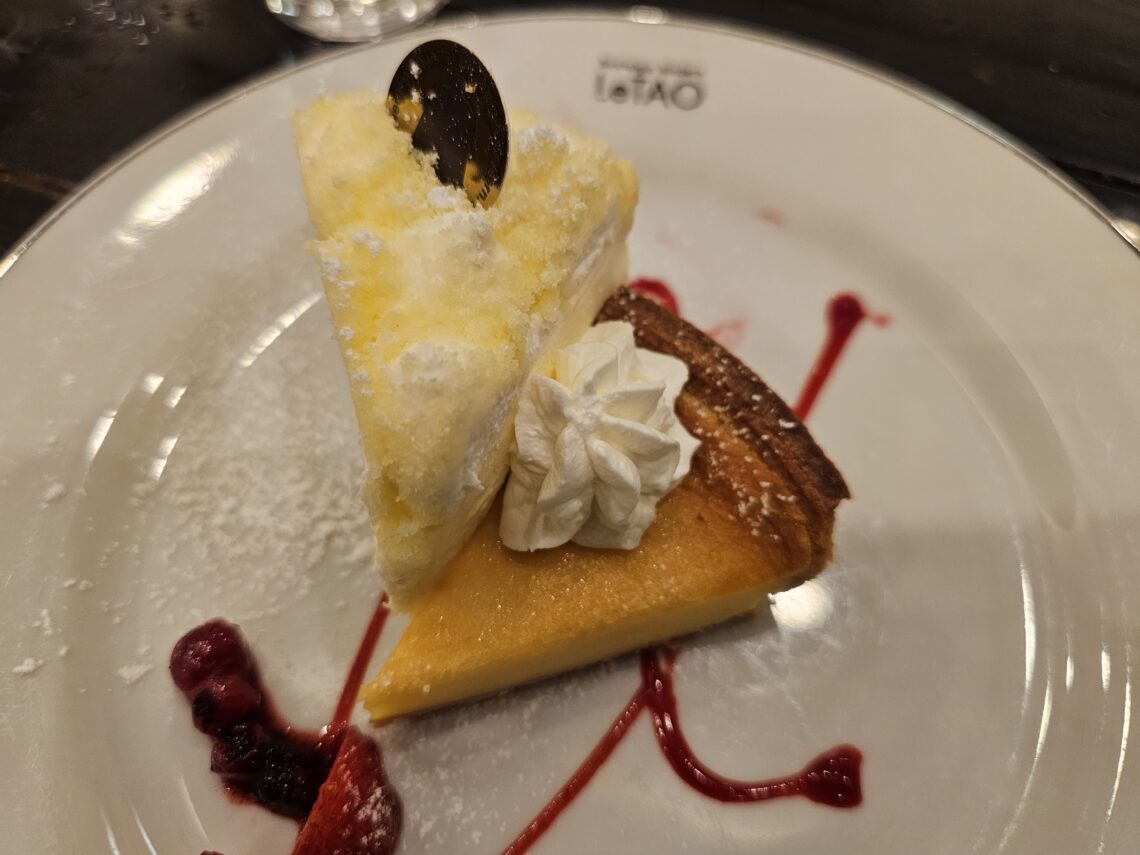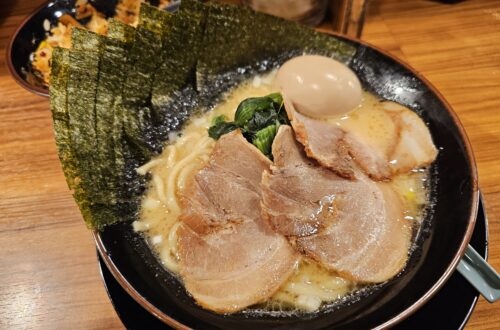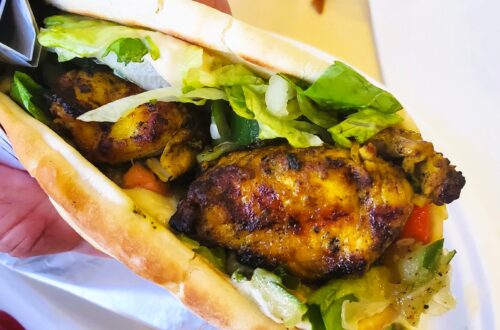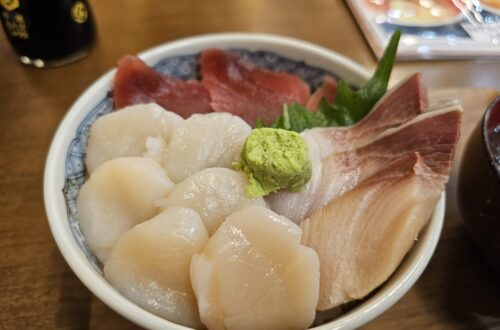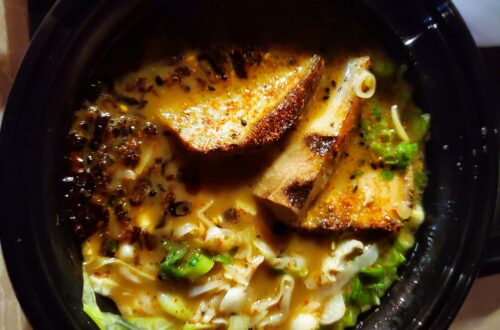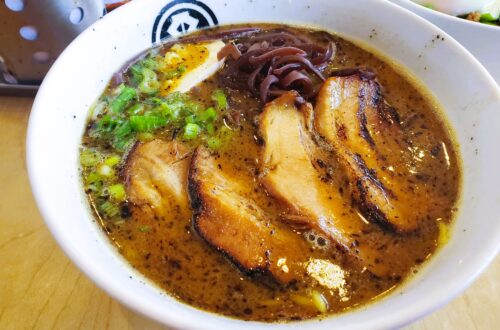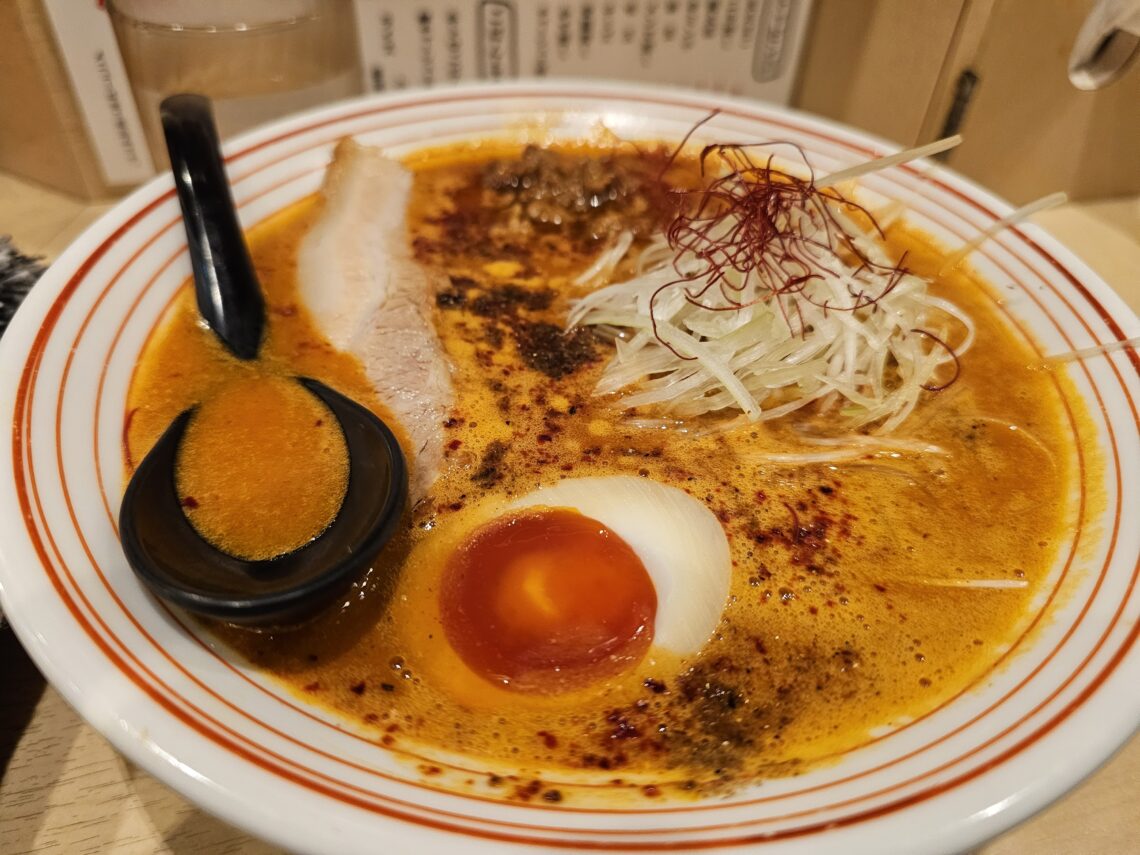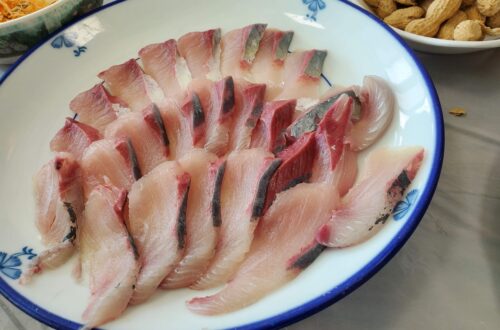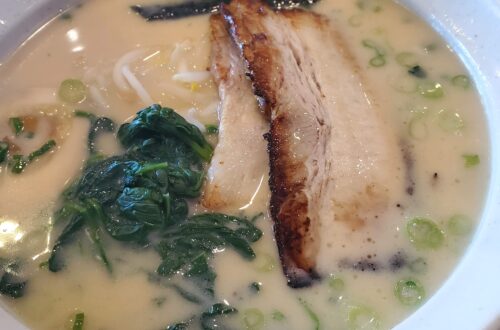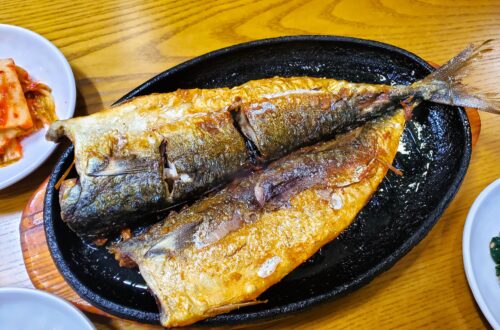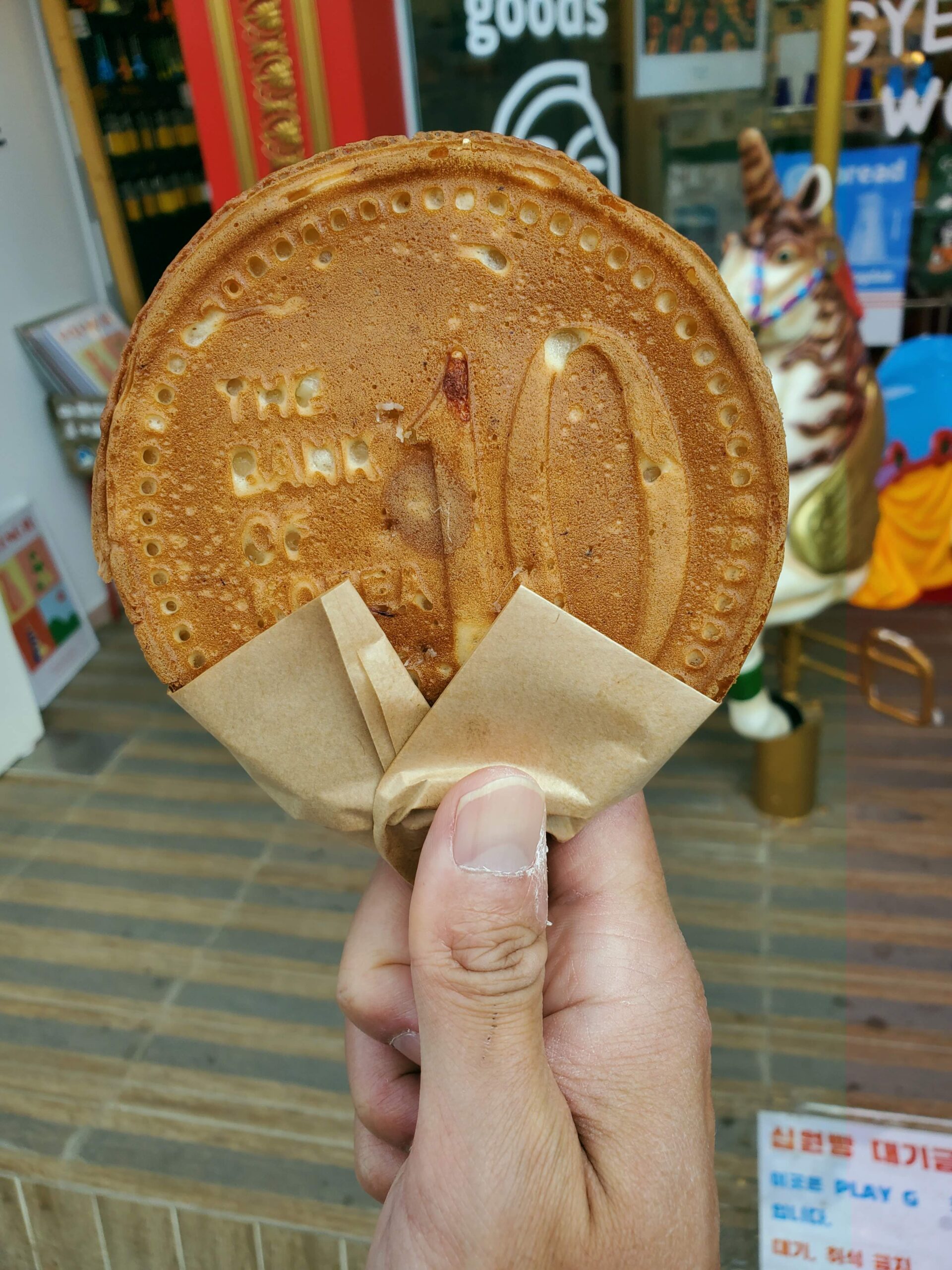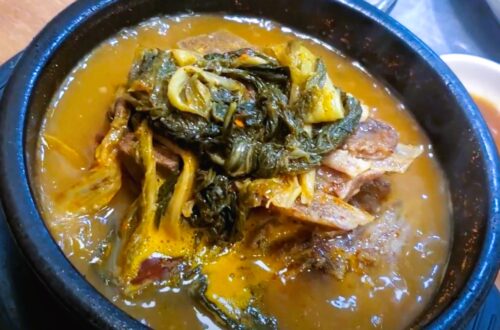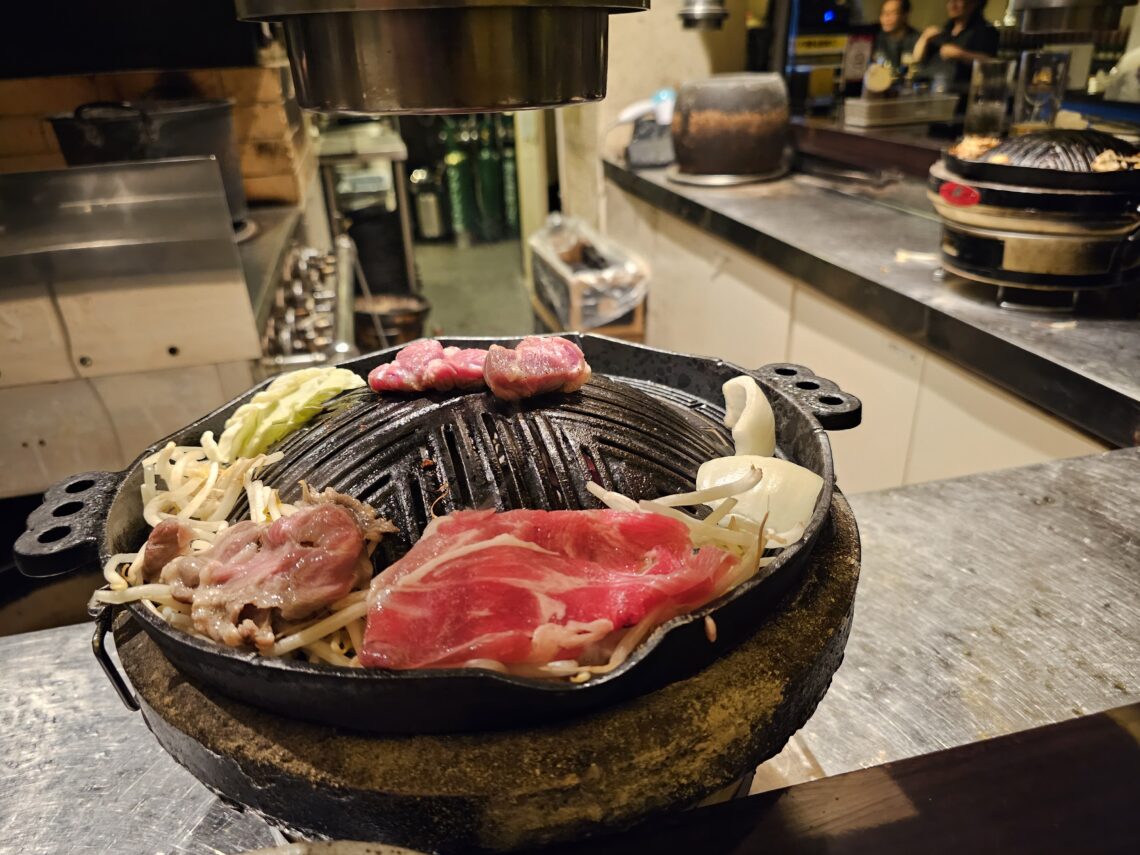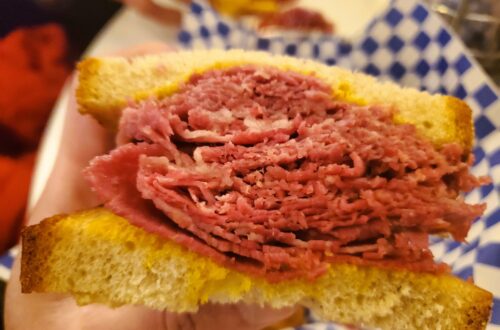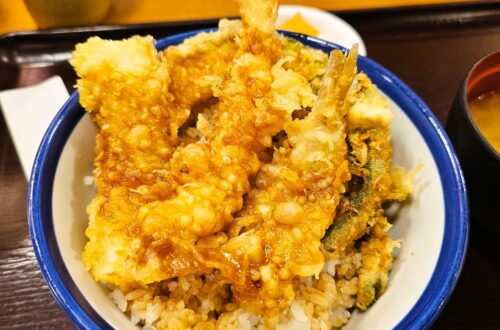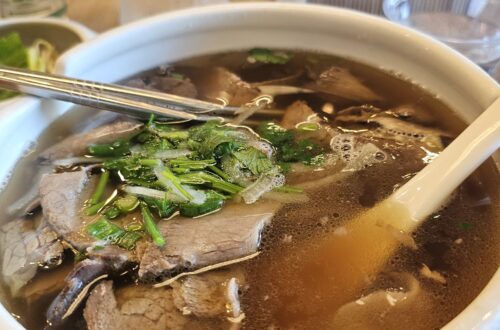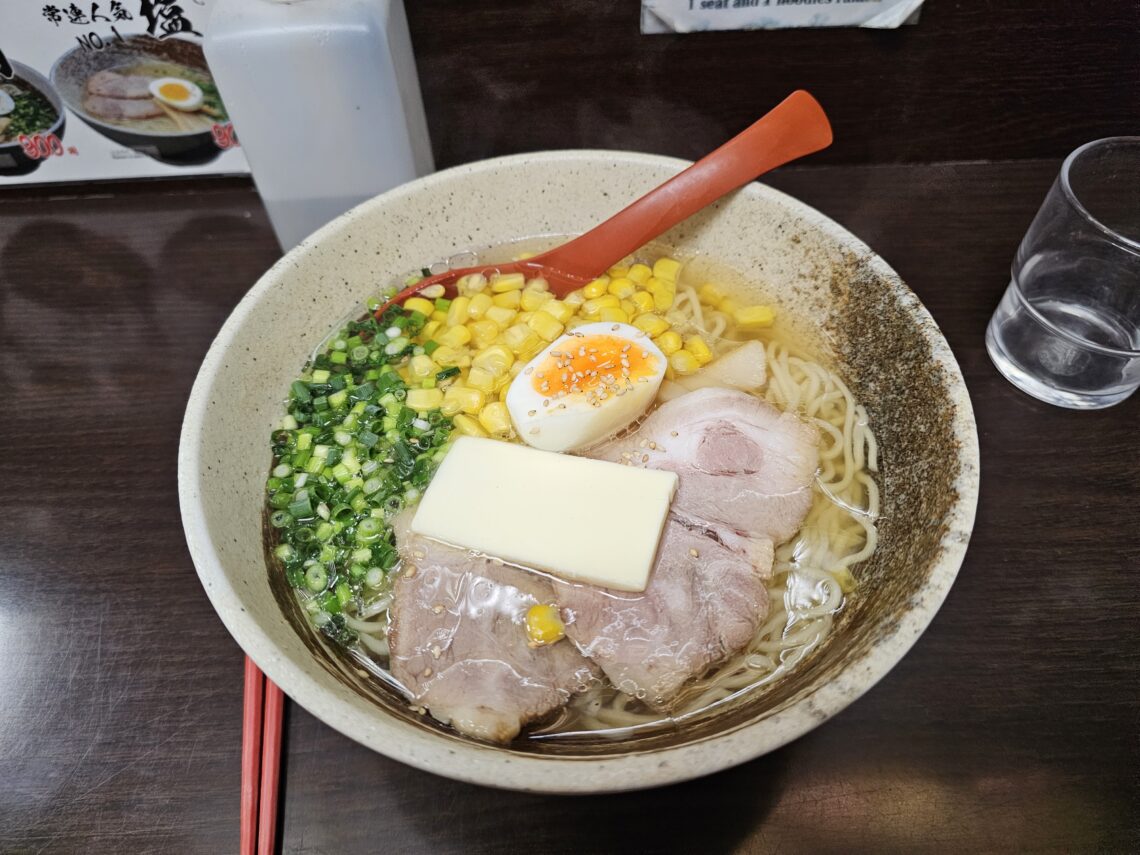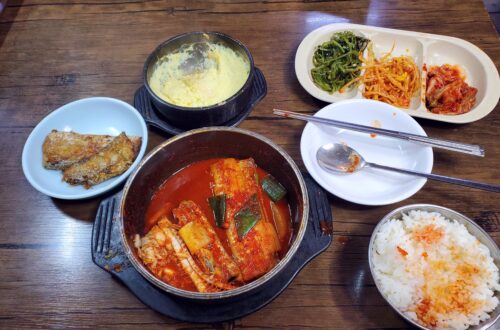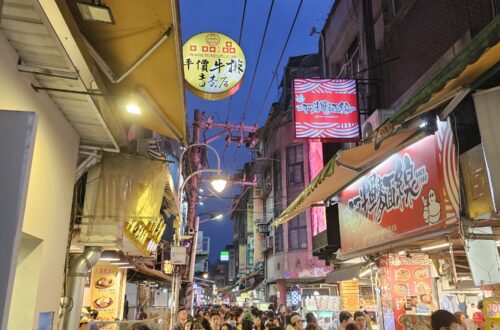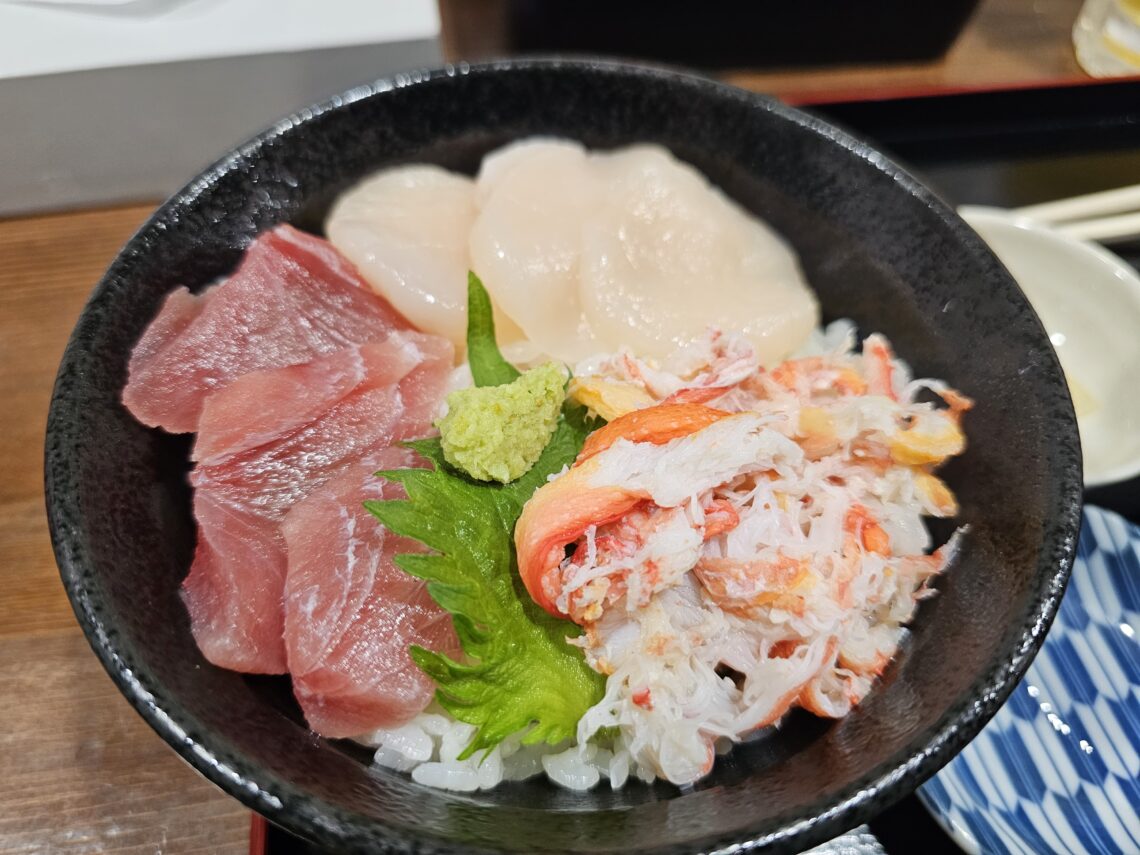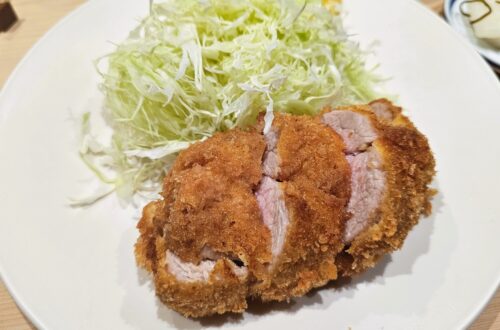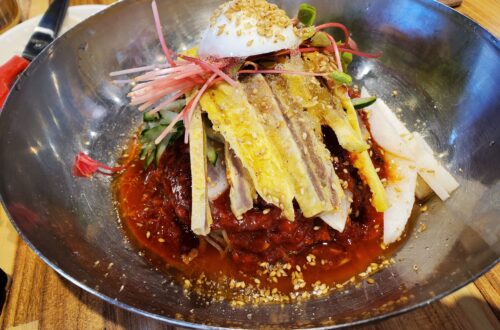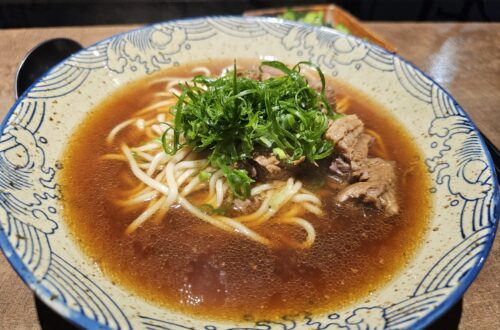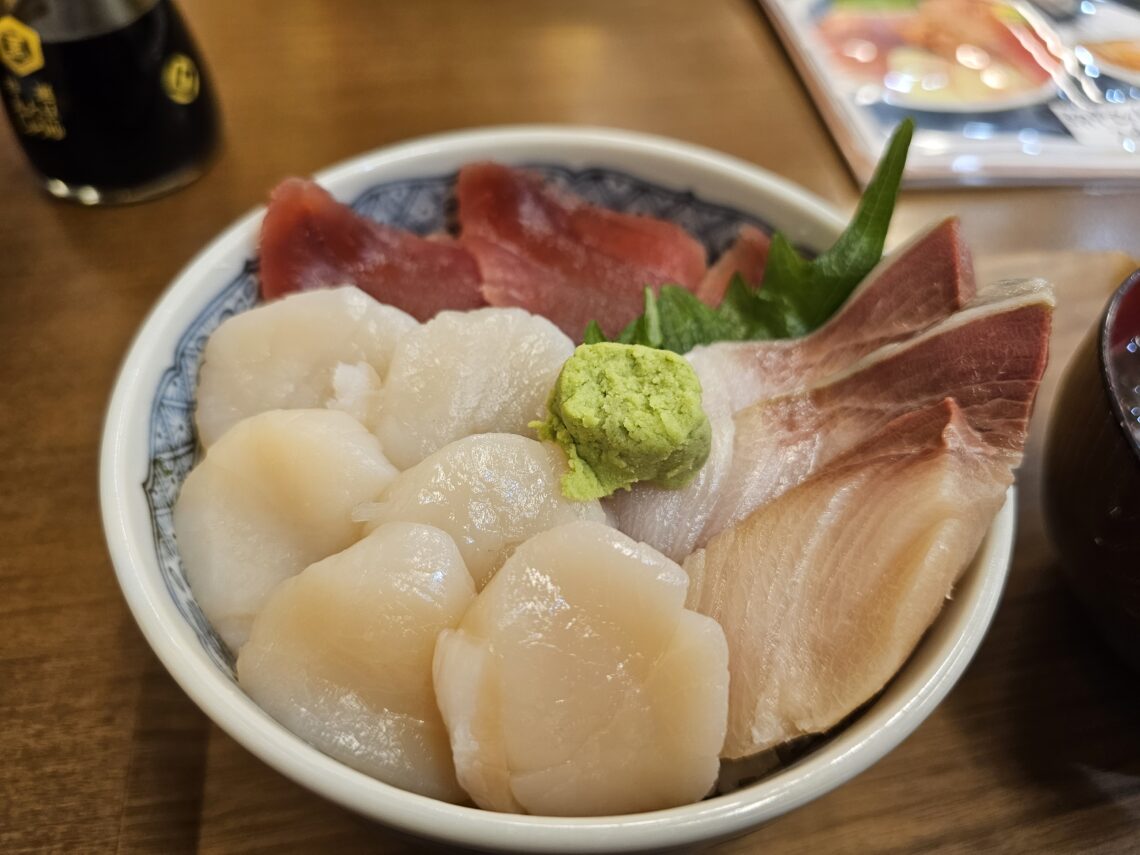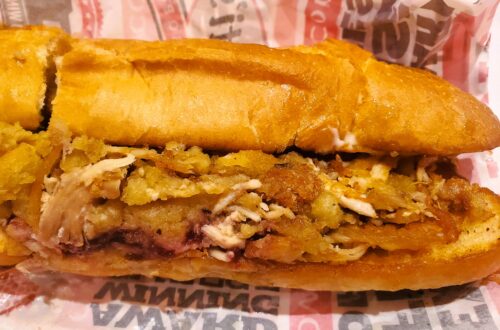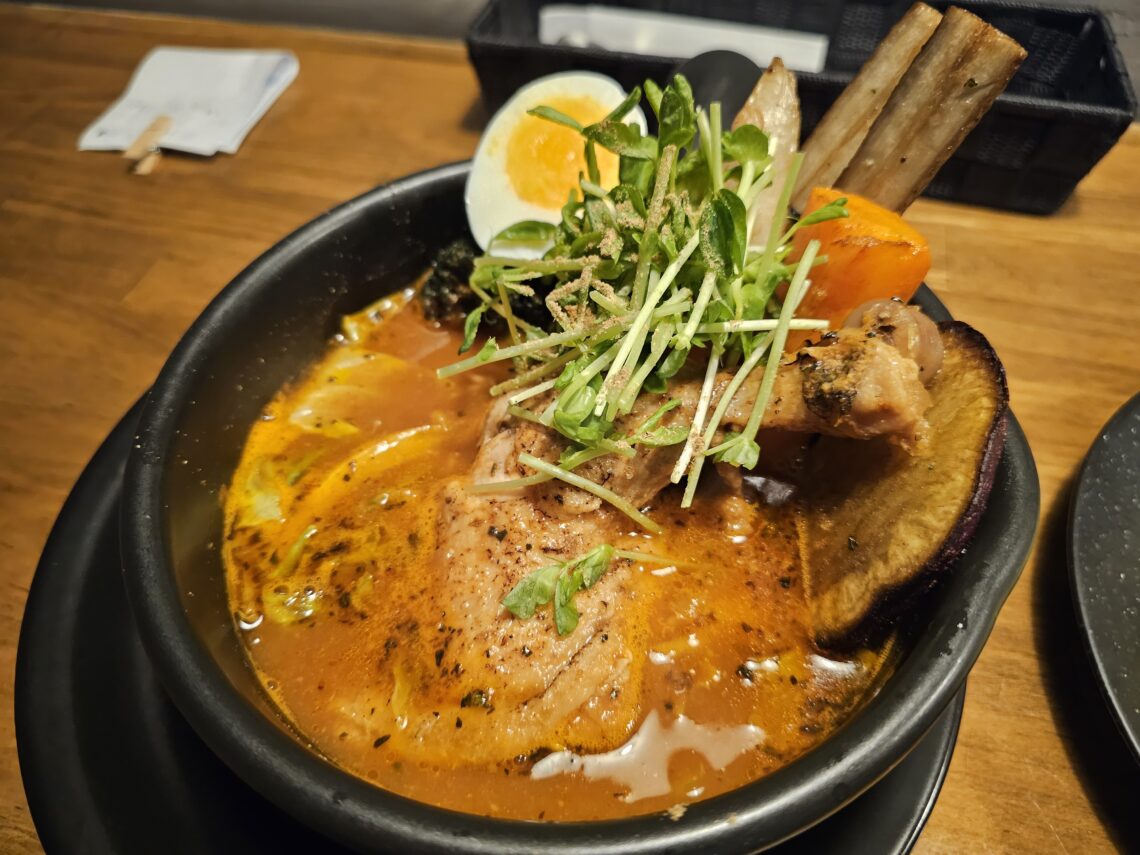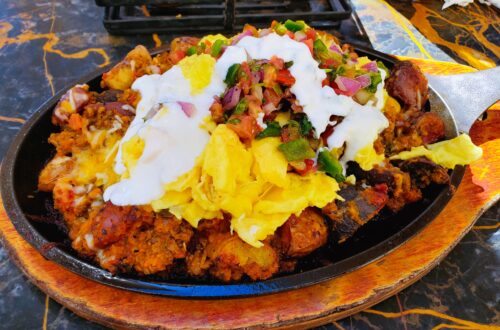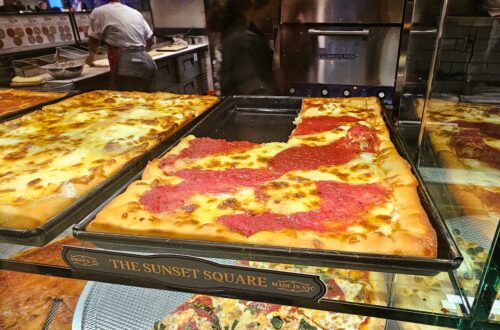Hokkaido
-
Does The Famous Japanese Bakery LeTAO Live Up To The Hype?
LeTAO is a Japanese dessert company that was founded in Otaru, Hokkaido in 1998. The first shop was opened in a tower right in the center of Otaru, which the founder, Kawagoe, taking inspiration from his travels in France, named La Tour Amitie Otaru – LeTAO – or The Amiable Tower of Otaru. In a creative twist to the name, the name is also comprised of a combination of the syllables of the city it was founded in.
The bread of butter of LeTAO is its cheesecake, most notably the Double Fromage. Each year LaTAO bakers churn out a whopping 25 million Double Fromage cheesecakes. Not only is that a staggering number, but it shows how popular the brand and its cheesecake is worldwide.
Table of Contents
The Original LeTAO in Otaru
The orginal LeTAO shop may have been small enough to fit within a tower but it has now expanded to include a massive store filled with baked goods attached to that original tower. When I went, it was extremely busy. I’m guessing that’s the norm here since LeTAO is now a worldwide brand and clearly extremely popular. Upstairs is where the restaurant is located. I went in the late afternoon, around 4pm, and it was packed. They have a number system so I grabbed a ticket and periodically would come back and check to see where I was in line. It was about a 45 minute wait.
The orginal tower is still there and you can continue going up the stairs from the restaurant floor to get to the top of it. You can enjoy the views it provides of Otaru while you wait for your table. It’s right across from the Otaru Music Box Museum.

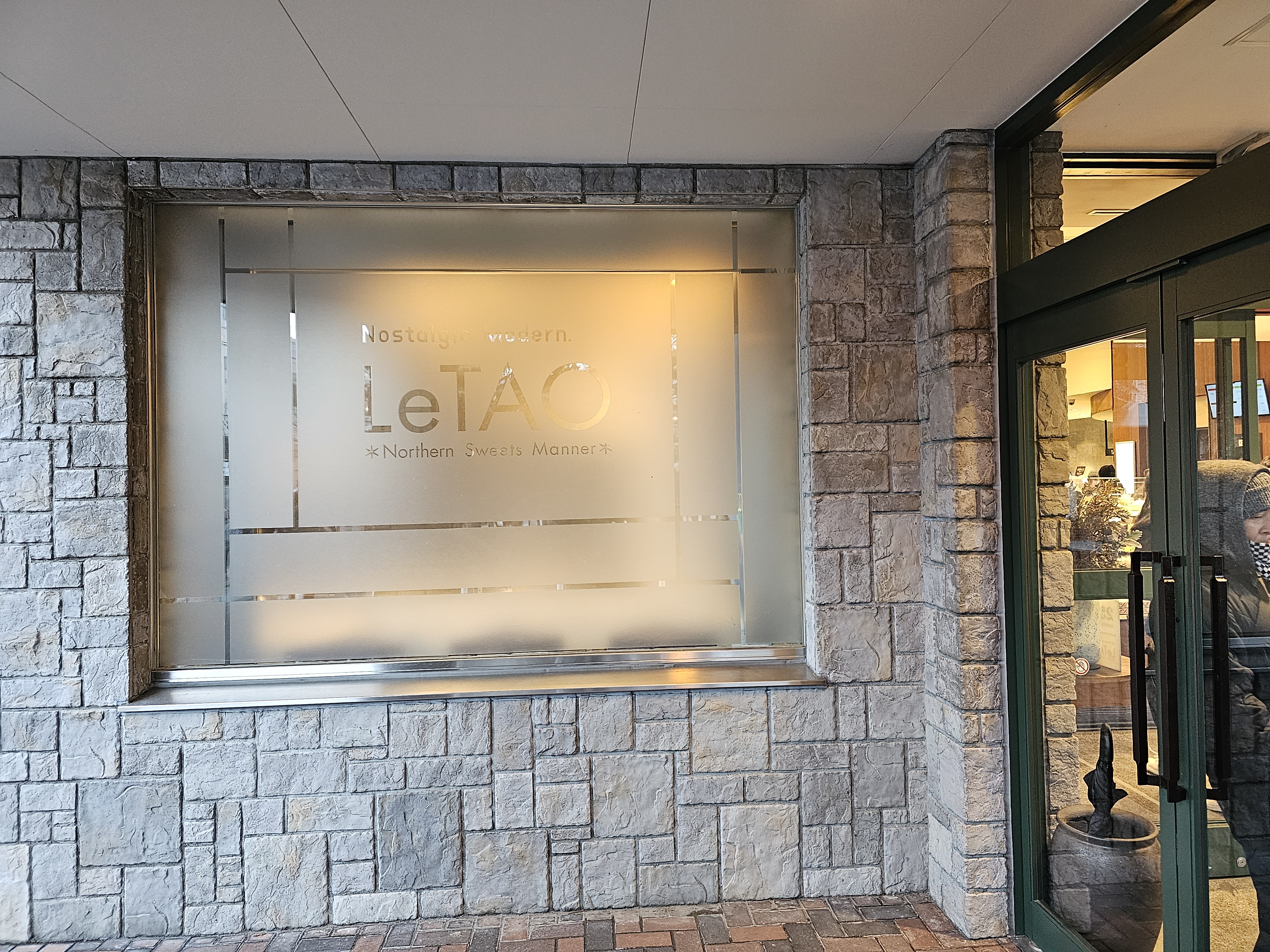
The Cheesecake
With LaTAO being known for their cheesecake, I obviously HAD to try it. There are many many cheesecake and pastry options and different combos to choose from, all of which came with a cup of tea as well. Some of the combos were already sold out for the day, but there were some yummy looking options still on the table to choose from.
I ended up with a slice of the original cheesecake (I believe) and a slice of lemon cheesecake (1500 yen, $9.60 USD).
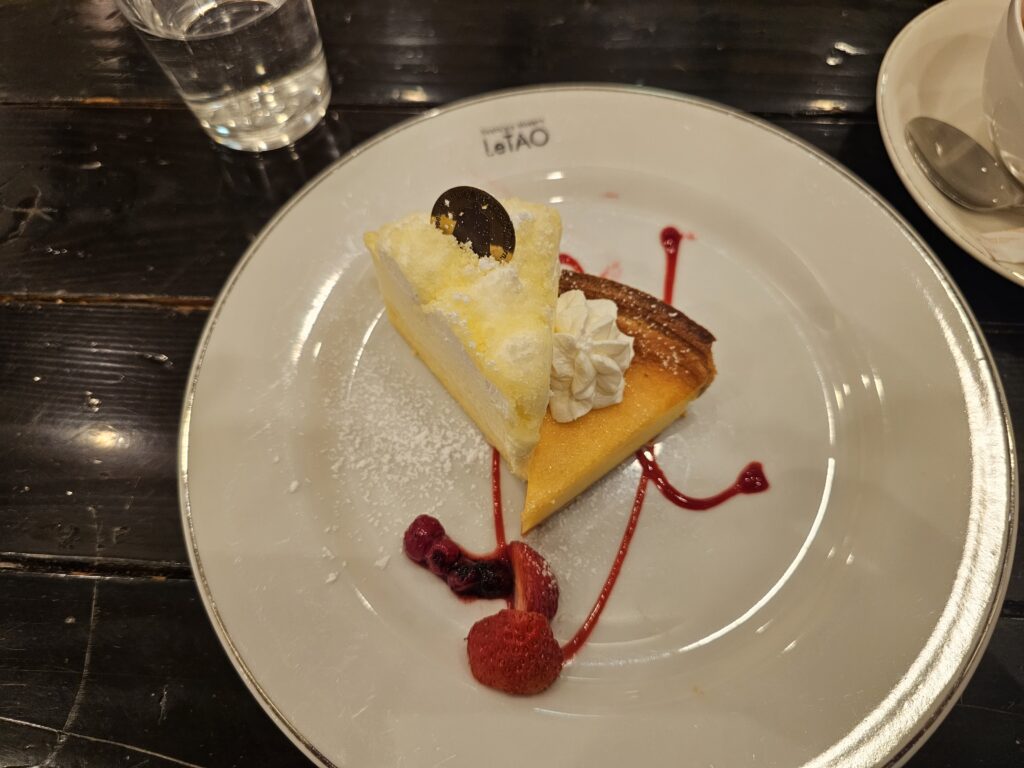
It’s a very simple, clean presentation. Slices are quite tiny, just big enough to get a nice sample taste. With this being cheesecake it’s probably a good thing the slices are on the smaller side!
I started with the original slice. It was very light with a subtle taste to it. It has the clear cheesecake taste to it but the flavor is not overbearing or super rich at all. Crust is incredibly light as well. Definitely quite tasty.
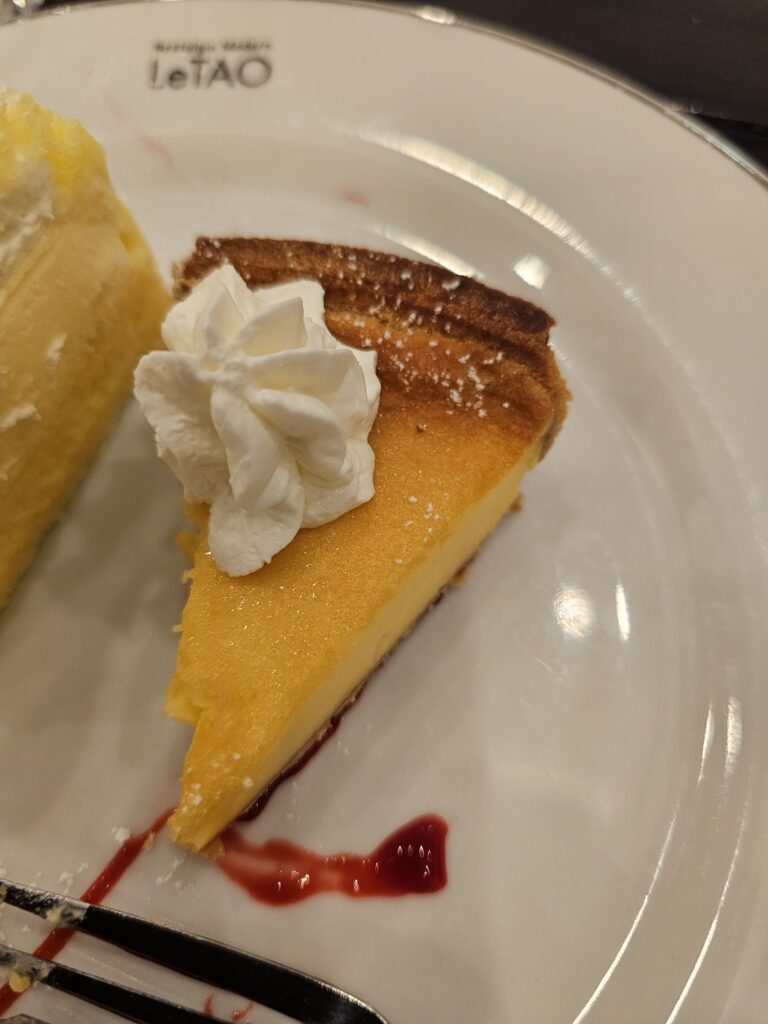
Next up was the lemon cheesecake. It had two layers on it, with the top layer being whip cream than the bottom layer being the lemon flavored cheesecake. Again, the flavors here are very subtle. With this having a couple layers I expected this to be a lot more rich in flavor. It wasn’t. It’s still very, very, light with a subtle taste to it. I really enjoyed this as well, even more so than the other slice!
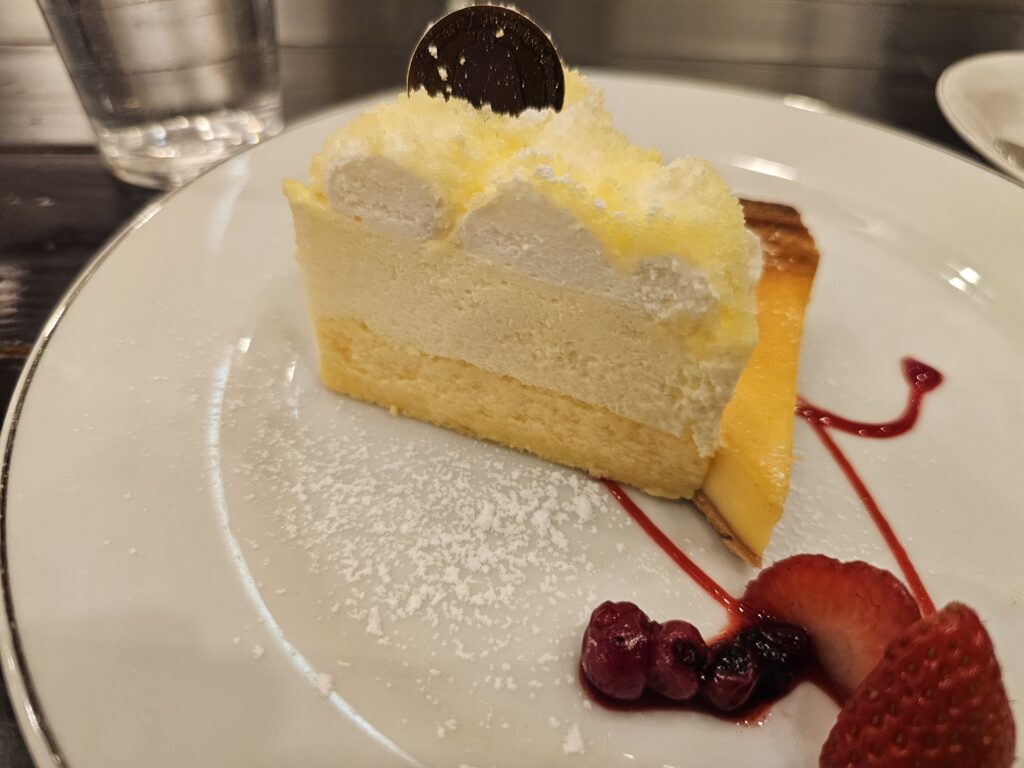
Is It Worth A Visit?
If you’re a fan of pastries and cheesecake LaTAO is certainly worth visiting and stopping by to sample some slices of cake. With so many excellent sounding options, it can be slightly daunting to choose just one or two to sample, but that’s a fun (and hopefully delicious) decision to make.
I was very satisfied with the combo that I bought. Getting two slices of cheesecaske with a cup of tea for sub-$10 USD is an excellent price for such a well-known bakery like LaTAO.
The cheesecake itself is certainly unique. These were by far the lightest slices of cheesecake I’ve ever had, which is a good thing. Even though the flavors were subtle, they were still very flavorful. I actually prefer this subtle falvor where the cheesecake is not overly rich and sweet. I didn’t feel all heavy after eating a couple slices and honestly probably could have sampled another slice or two (don’t judge, lol).
-
Is The Famed Naruto Honten Fried Chicken In Otaru Fulfill It’s Hype?
Otaru is a port city located in Hokkaido, Japan, about a 30-40 minute train ride from Sapporo, it’s a popular day trip from the biggest city in Hokkaido. Of course it has a number of outstanding restaurants to choose from. Depending on how long your stay is you may only get one or two meals here so it can certainly be a tough choice deciding on what to get!
I had seen a video on Naruto Honten and hadn’t had fried chicken up to this point on my trip so I definitely had a hankering for it. I decided to make this my meal in Otaru so I certainly had high expectations and even higher hopes (that I made the right decision lol).
Table of Contents
The Experience
I walked over to the restaurant around noon, so peak lunch time. It’s about a 10 minute walk from the famous Otaru Canal. You know the place is popular and expecting crowds when there’s a ticket machine where you pull a number with a waiting room where you can sit until your turn is called. With it being lunch time it was fairly busy, not overly so though. It took about 15 minutes or so to get my number called.
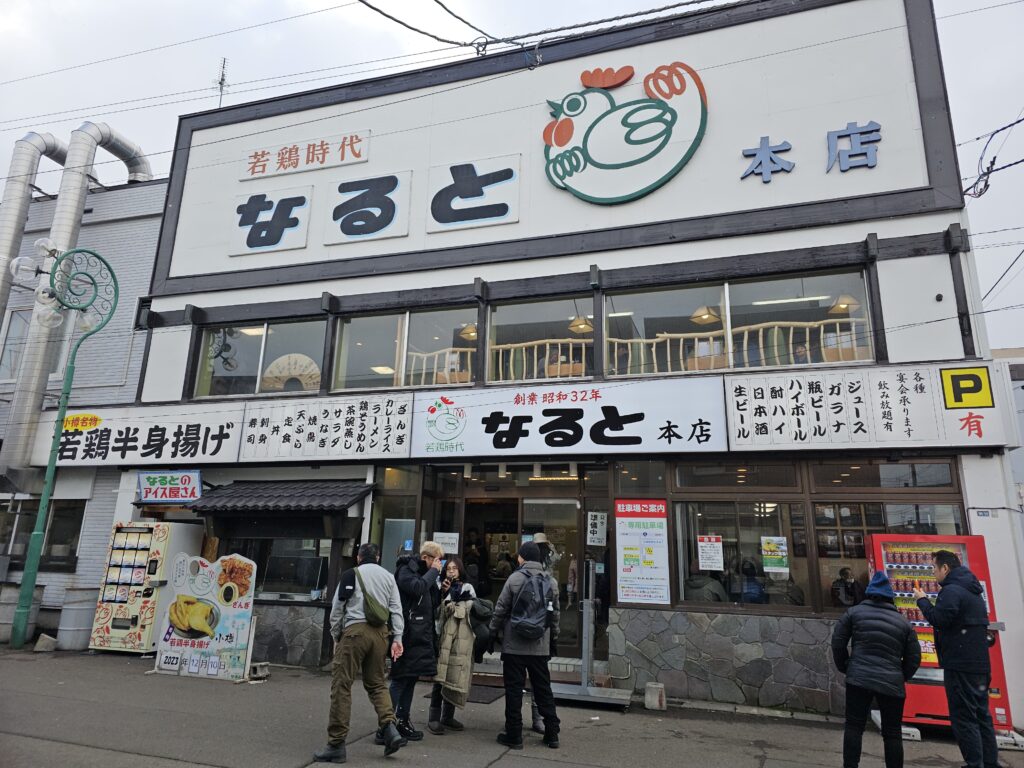
The front of Naruto Honken in Otaru There’s a lot of options to choose from on the menu. They have much more to offer than just the fried chicken they’re known for.
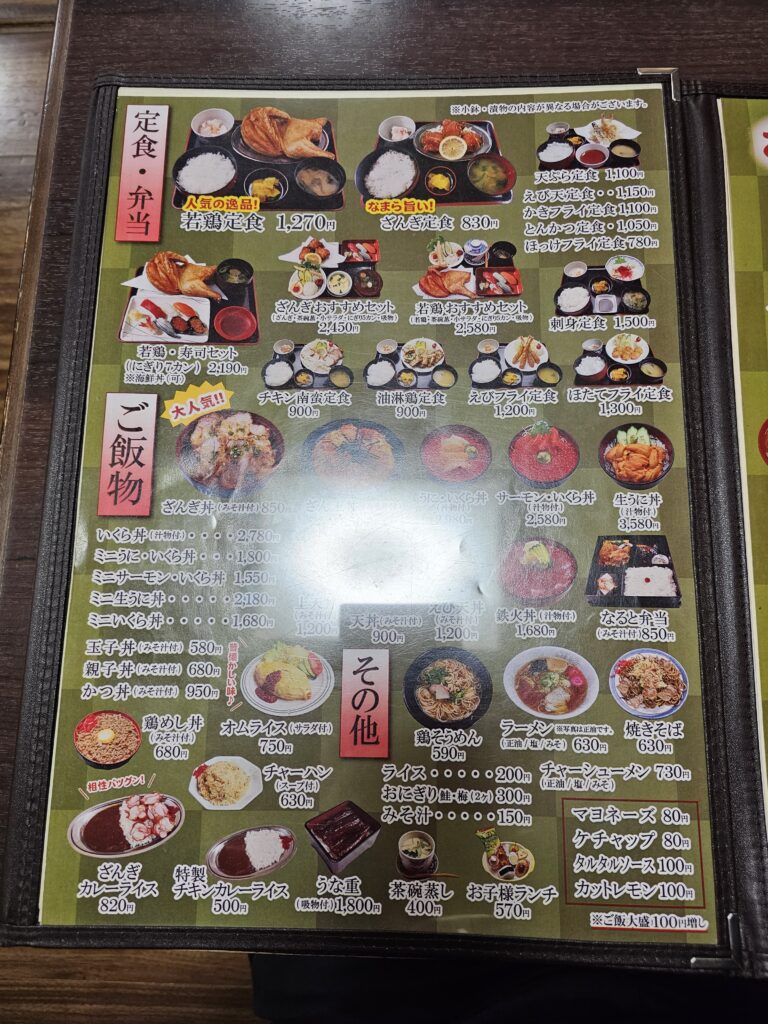
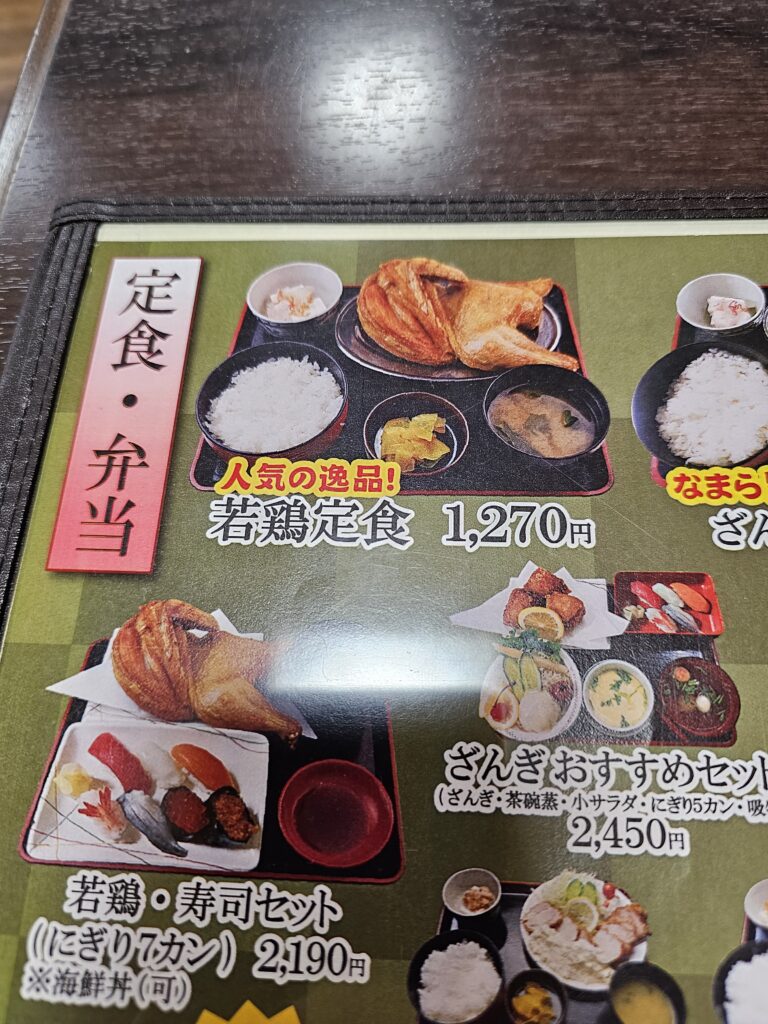
But I came here specifically for the fried chicken. That half-chicken combo meal was just calling my name and that’s what I went with along with a beer (1850 yen, $12.02 USD)
The Fried Chicken
The first thing you notice about the fried chicken is how crisp the skin is. Exceptionally crispy and seasoned well, it really is delicious. Digging into the meat, it’s tender and extremely juicy. With fried chicken you can sometimes run into places where the meat is a little dry, but it wasn’t the case here. The fried chicken was done perfectly and juicy throughout.
The seasoning is mild which I enjoyed. It’s not overly salty at all. For my taste preference it was perfect. The fried chicken isn’t very greasy either, another positive!
The combo meal also came with a bowl of rice, miso soup, tofu, and radish. Quite a filling meal for $12!

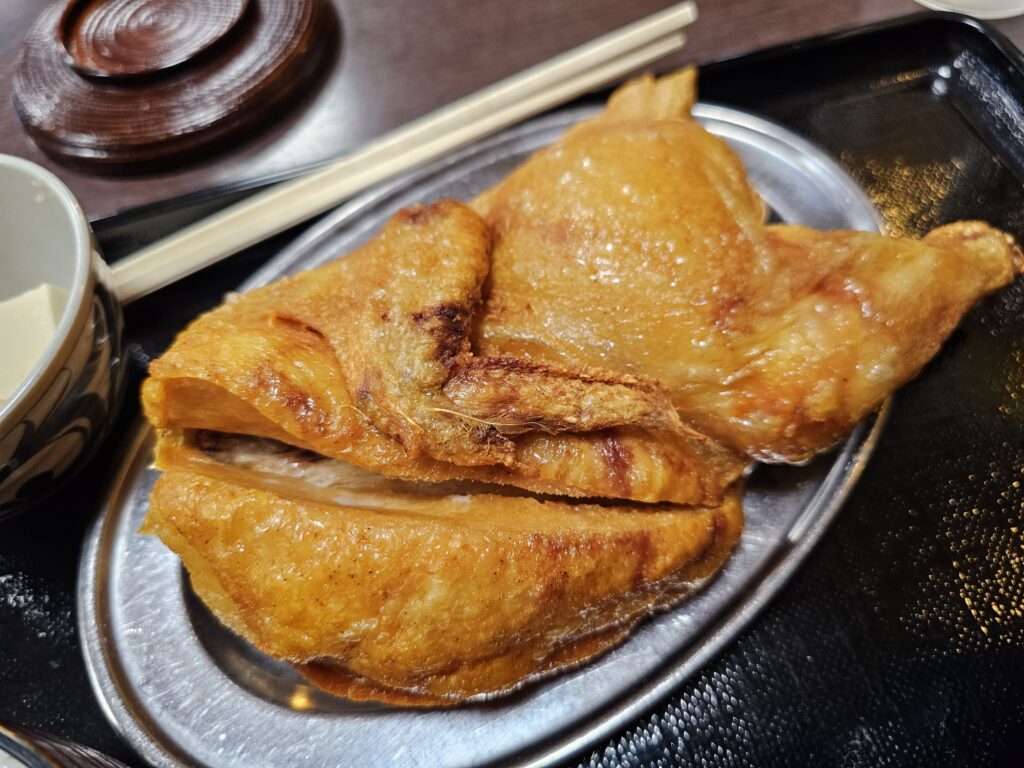
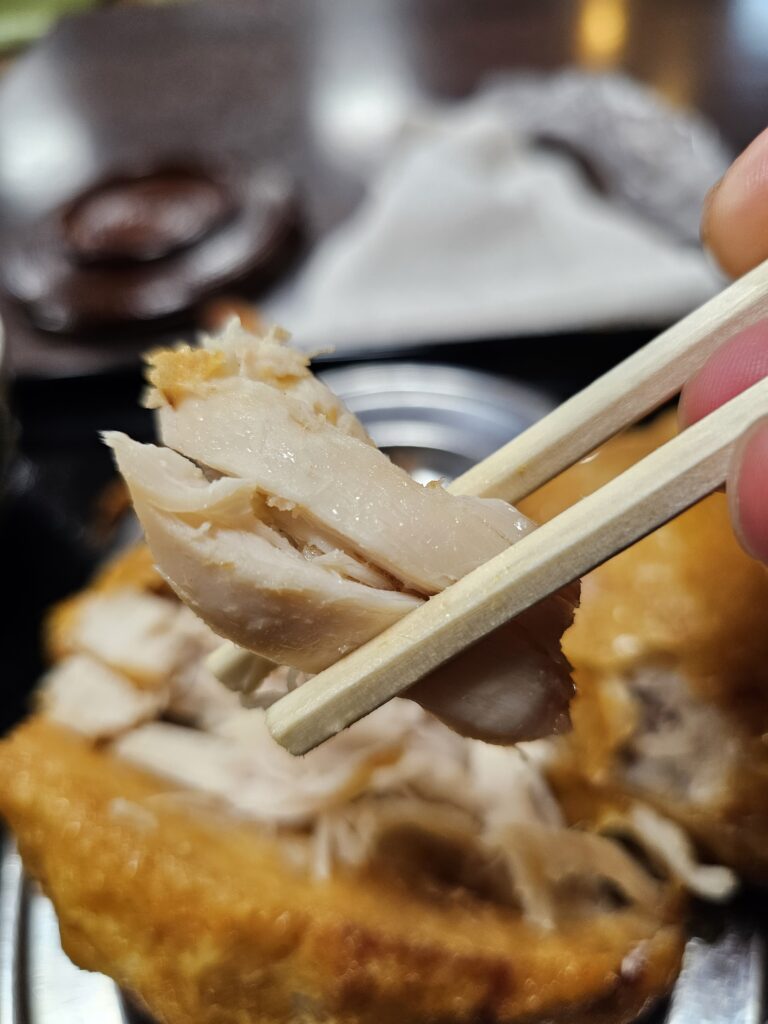
Is Naruto Honten worth visiting?
If you’re in the mood for fried chicken and have had your fill of sushi (which Otaru is also known for) then Naruto Honten is certainly worth the trip. It’s an iconic, well-known establishment in Otaru and the fried chicken is quite good! You get quite a bit of food for only $8.25 as well.
-
Things Get SPICY At This Miso Ramen Joint in Sapporo
Miso ramen can be found throughout Japan but the birthplace of this style of ramen is Sapporo. The specific nature of how miso ramen came to be has long been rumored that it occurred at a restaurant called Aji no Sanpei in Sapporo in the 1950s when a drunken customer asked that noodles be placed in their miso soup. How accurate the story is may be debatable, but a “strange” concoction born from the hunger pains of a drunken patron are surely believable.
Fast forward decades later and, as mentioned above, miso ramen has evolved and can be found throughout the country. Each area and restuarant will have their own unique spin on this unique tasting ramen BUT there’s only one place that can claim to be the creator of miso ramen and that’s Sapporo. It was a must try for me while I visited.
Karaiichi Sapporo Ramen Susukino
I stumbled upon Karaiichi Sapporo Ramen Susukino after coming back from my day trip to Otaru. It was a cold day ( I went in December) so a nice steaming hot bowl of ramen sounded like the perfect meal to have to cap the day off. I thought it was the perfect time to get some authentic miso ramen in Sapporo!
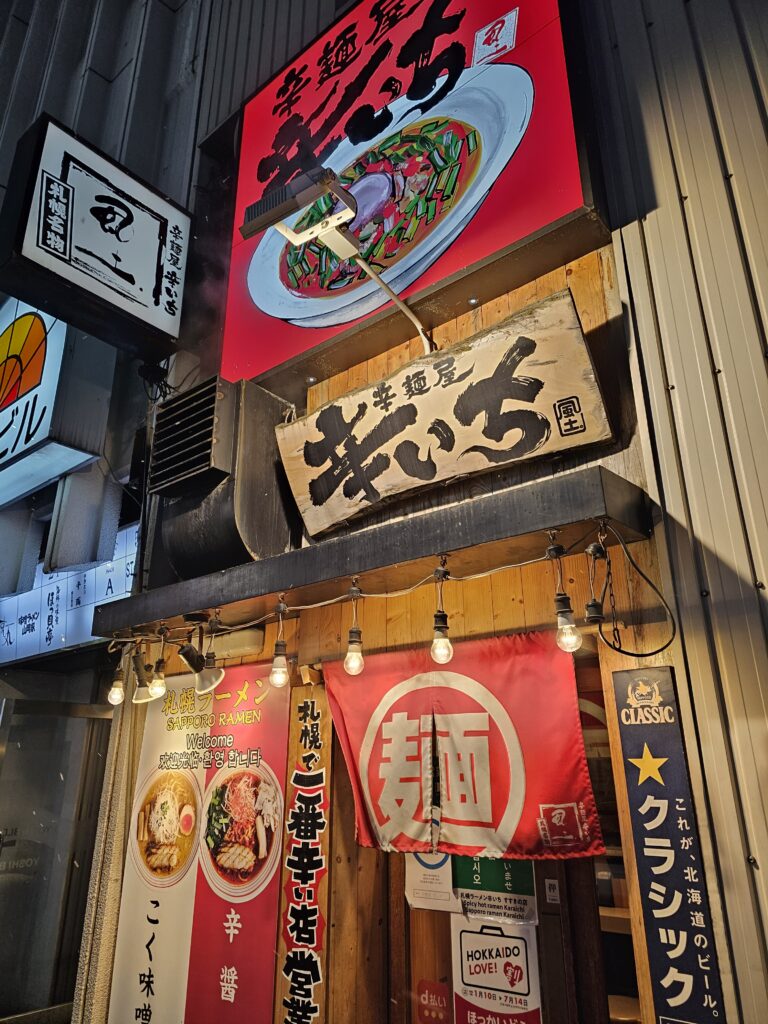
It’s a typical ramen restaurant that’s very tiny and seating consisting of countertop space. They did have an English menu here which was certainly helpful. Something that was very interesting here was the spice level.
If you take a look at the below (sorry the print is tiny) you can see that spice levels range from 1-30 with appropriate increases in price, then there’s TWO additional levels called “demon” and “Hell”. I mean….what does this ENTAIL? What does this even look like or taste like?? I certainly wasn’t brave enough to give either one of those a taste. I like spice but I draw the line when spice levels hit “demon” and “Hell” levels, haha.
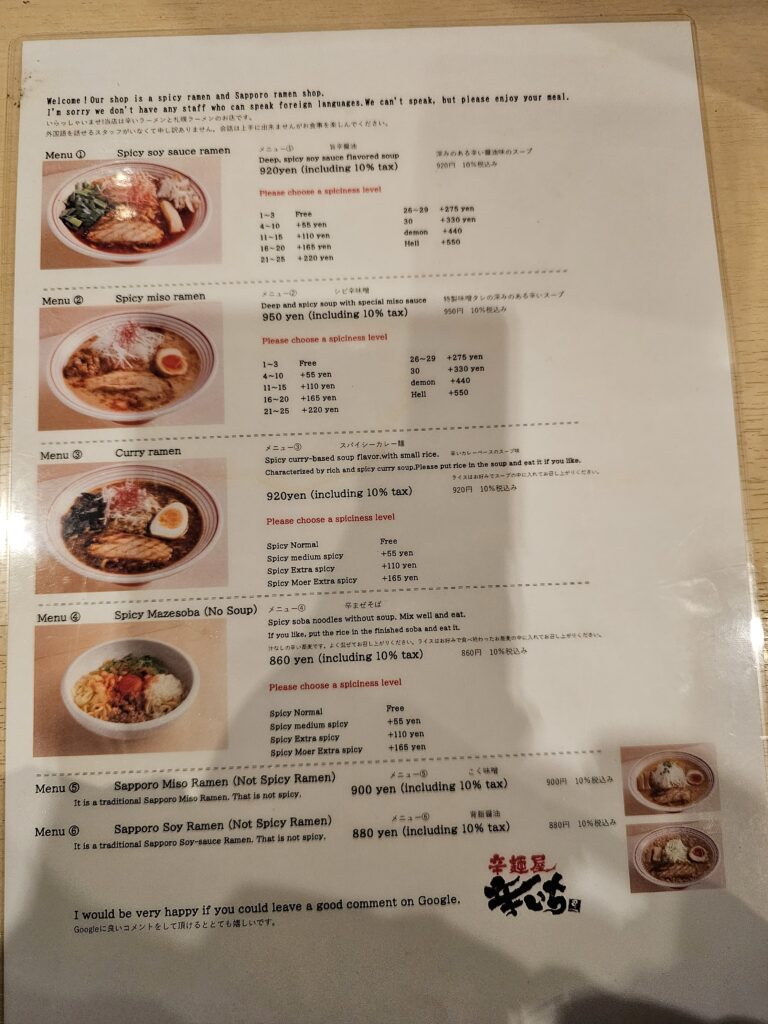
The Food
I ended up getting the Spicy Miso Ramen, level 10 (1005 yen, $6.47).
Miso broth is thicker, made primarily with miso paste and can also include many other ingredient combinations of dashi, garlic, ginger,onions, scallions, tare, and other ingredients. There’s a lot of variation that can be found here.
This particular broth was definitely rich with a deep flavor. The spice was quite good at level 10. Definitely quite spicy, not overly so, with a great kick to it. It was just right. I can’t imagine what level 20 would be, let alone the last two levels!
The bowl of miso ramen comes with finely shredded bean sprouts, half an egg, a piece of chashu pork, and some ground pork as well. The chashu was fantastic. It was exremely tender and was falling apart as I attempted to pick it up.
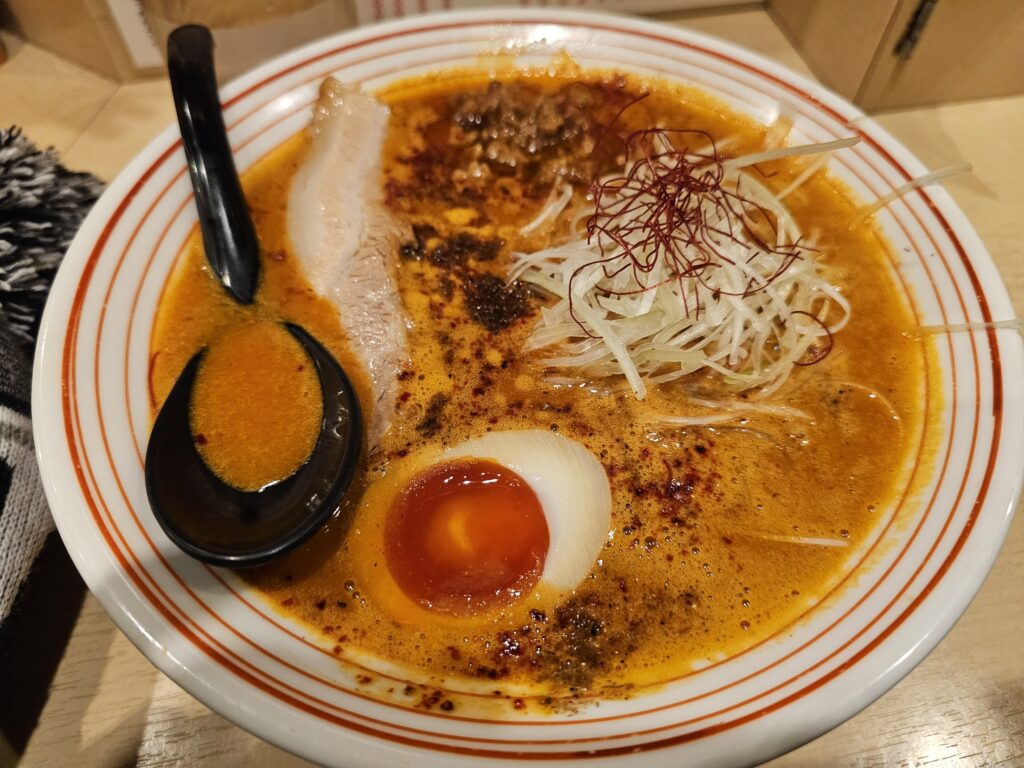
The noodles were thicker and firmer and tasted extremely fresh. The egg was nice and creamy. I enjoyed the addition of the ground pork, it was a little different than what I was used to. The bean sprouts added a different texture to the bowl. Everything in the bowl really played well together, when combined with the spicy broth made quite a comforting bowl of ramen on a cold December night.
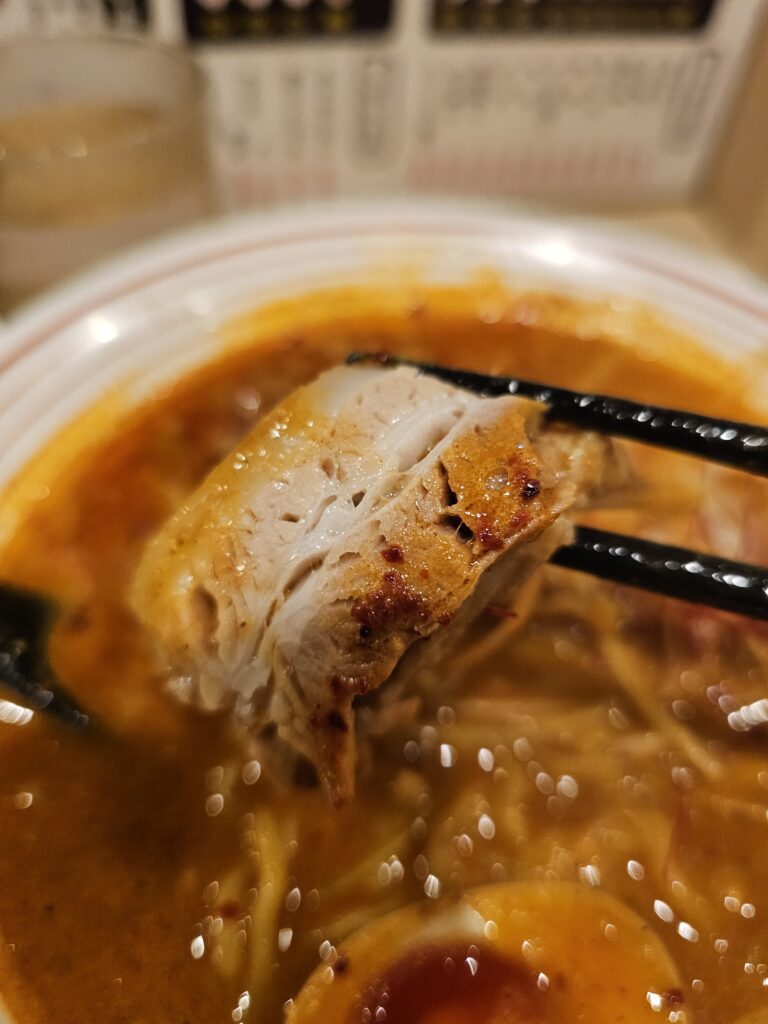
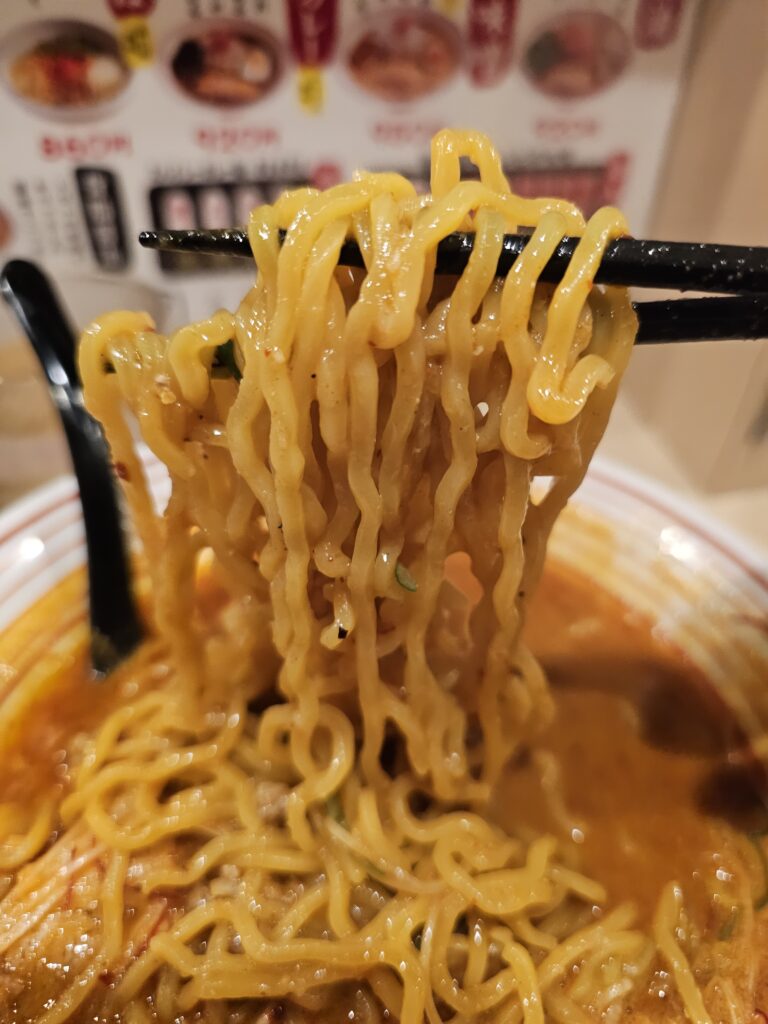
Miso Ramen in Sapporo
As mentioned above, miso ramen was CREATED in Sapporo, so if you’re a foodie it’s a must try. You could certainly go to the original ramen shop that created miso ramen – Aji no Sanpei – it’s still there (!) or you could find any number of ramen restuarants dispersed about the city serving miso ramen.
I was lucky enough to stumble up on Karaiichi Sapporo Ramen Susukino and was not disappointed. If you have a hankering for spicy miso or are looking to give it a try, this is a great option if you’re in the area. The Spicy Miso Ramen was fantastic here. I just love how many different spice levels they offer, as someone that loves spicy food it was great to see!
Karaiichi Sapporo Ramen Susukino
Address: Japan, 〒064-0805 Hokkaido, Sapporo, Chuo Ward, Minami 5 Jonishi, 4 Chome−7−3 ソシアルビル 1F
-
Inviting Local Bar in Sapporo Is A Great Place For Drinks And Snacks
After a long day of exploring Sapporo, I was in the need of a nice cold beer and some food. There are of course a ton of bars in Sapporo so narrowing it down can be a daunting task. Not wanting to venture out too far, I was able to whittle down the choices and find Micci’s. Micci’s had great reviews and was located just a few minutes from where I was staying.
Micci’s Bar
The first thing you notice when you first enter Micci’s is the decor. This is a unique bar in Sapporo. It’s walls are covered with posters, stickers, toys, plushies, photos, and assorted other trinkets. There’s a whole section behind the bar housing many many CDs which are played within the bar. The night I was there they were playing the Rolling Stones. It feels like a bar from the early 2000s. Just a really cool and fun environment.
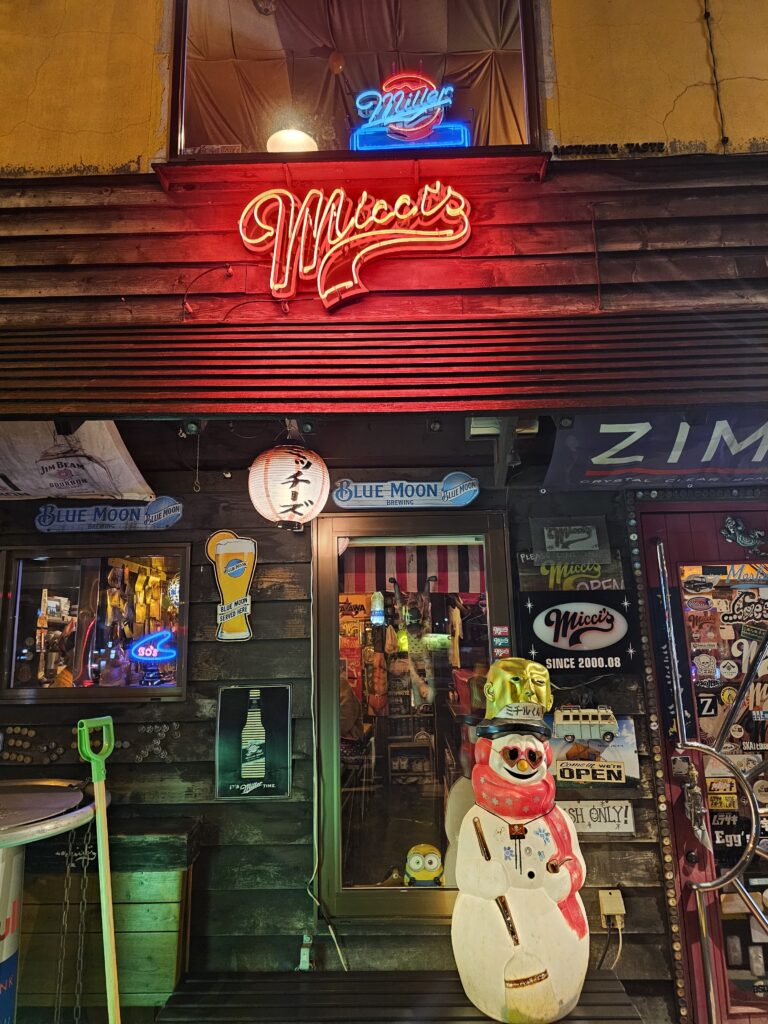
The bar is quite small. There’s counter seating and then another section with a booth and a table with some addtional seating. The quaintness of the bar adds to the coziness appeal. The staff also adds to the warm environment as they are very kind, chatty, and speak English as well!
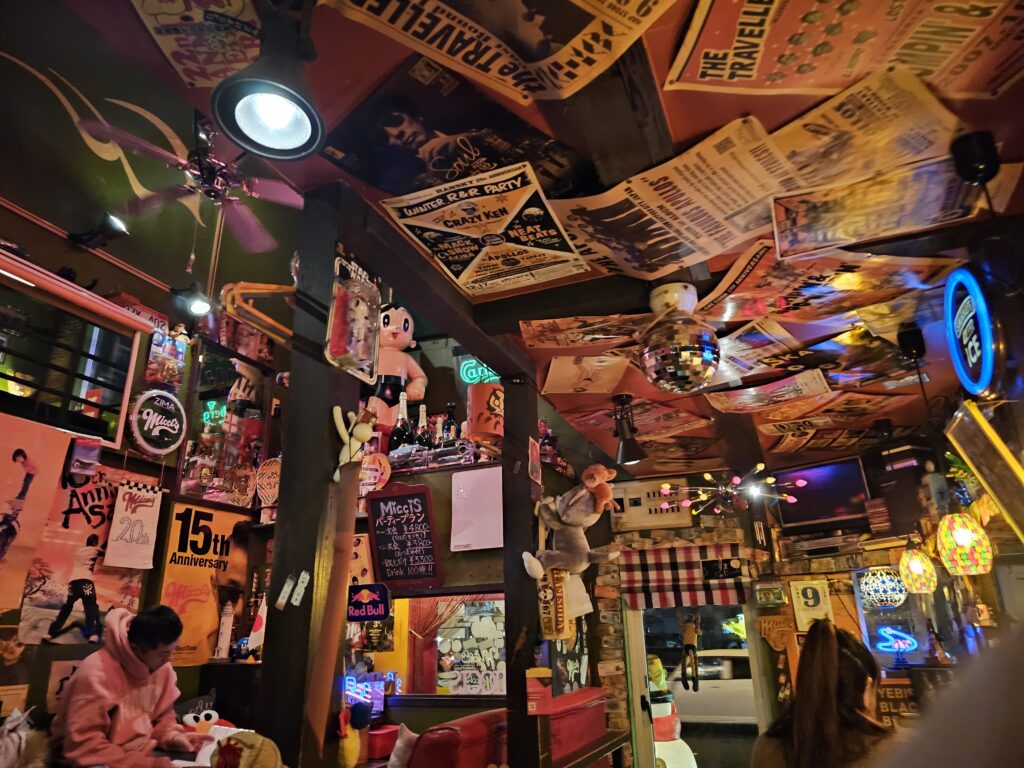
This may be a bar but Micci’s also offers a fairly diverse menu filled with snacks, small dishes, and finger foods which go great with a nice cold beer. The bar food is all very reasonably priced as well so you could certainly eat to your heart’s content here without breaking the bank.
There’s only two people working at Micci’s and Micci does all the cooking. There’s no separate kitchen area. The fryer and all cooking takes place right behind the bar
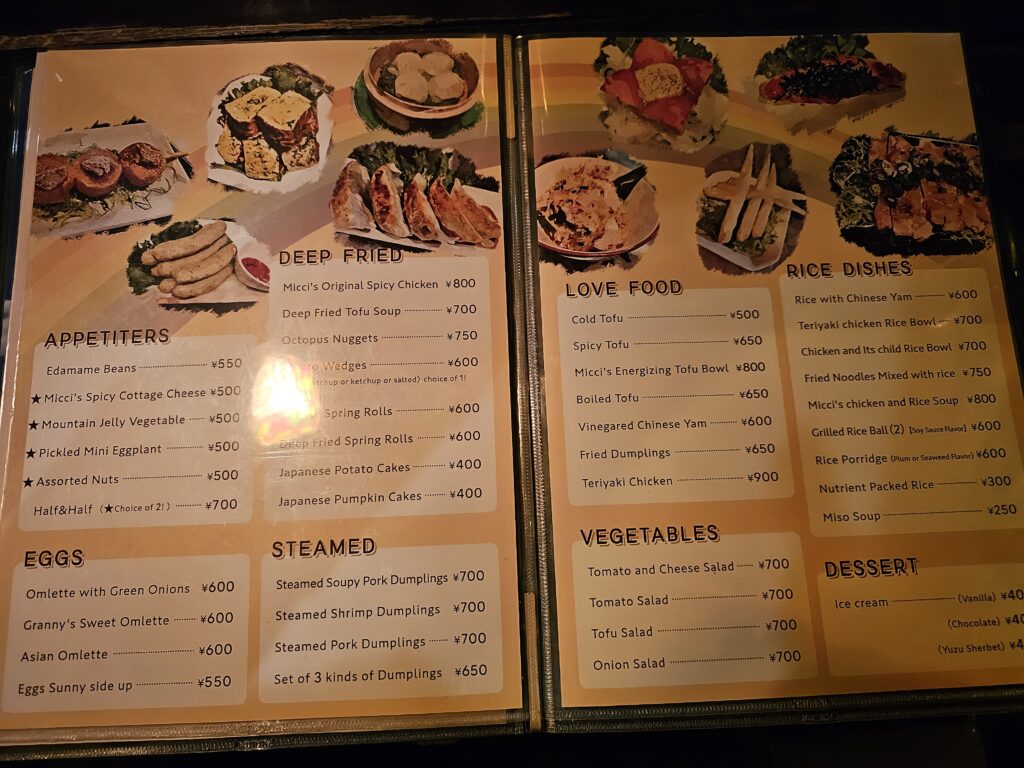
The Food
I opted for Micci’s Original Spicy Chicken (800 yen, $5.07) and the Japanese potato cakes (400 yen, $2.54). The Spicy Chicken had nice crispy skin and the meat was juicy and tender. There was finely shredded lettuce and green onion that accompanied the chicken as well. I wasn’t quite sure what the sauce consisted of. It was a little buttery a little sweet, and a little spicy. Very subtle flavors but very tasty.
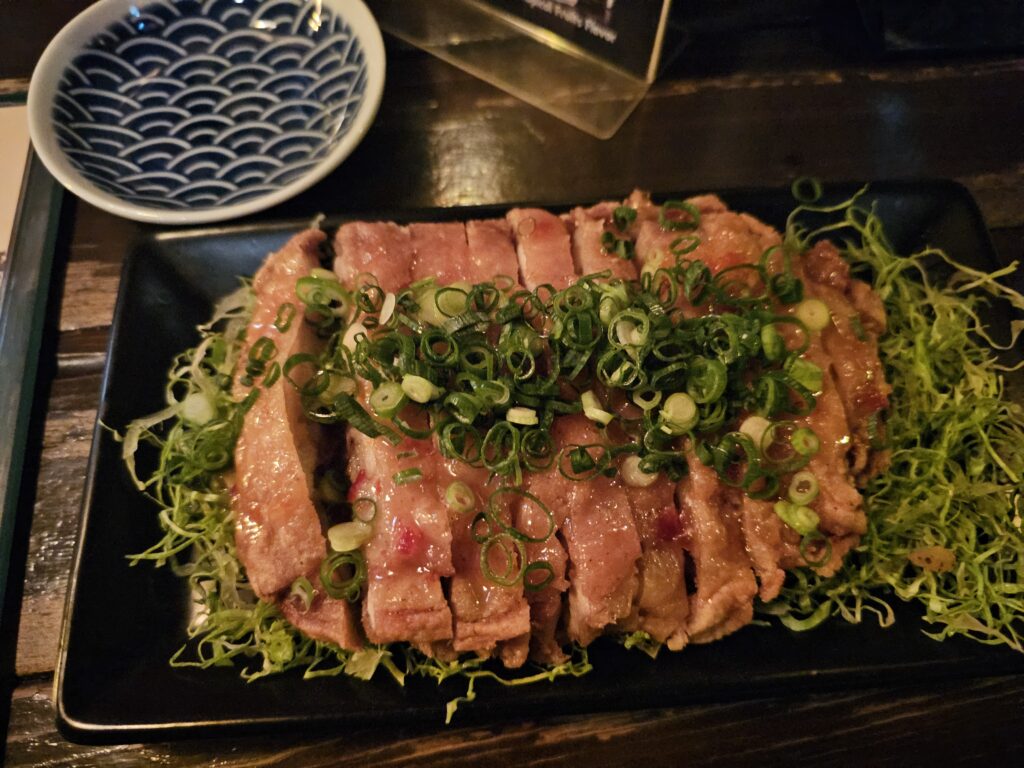

The Japanese potato cakes came out piping hot. Nice and cripsy on the outside the inside was semi-firm, semi-gooey on the inside. It reminded me of potato mochi to a certain extent. It was really tasty as well.
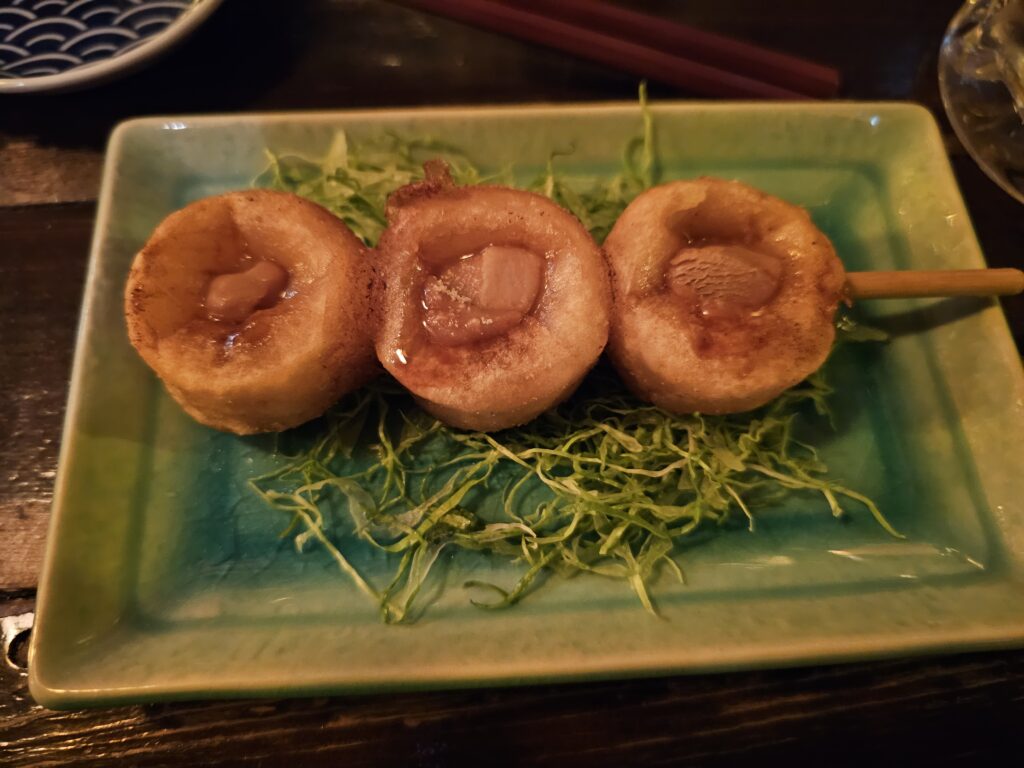

Micci also gave me free octopus nuggets(essentially calimari), which was delicious and very kind of him!
Micci’s Is Worth A Visit
If you’re in Sapporo and looking for a chill evening with some cocktails and some good bar food, Micci’s is certainly worth a visit. It’s a unique bar in Sapporo. From it’s charming decorations to friendly staff to delicious bar food, Micci’s is just a really cool bar in Sapporo to hangout at to enjoy a night. I definitely recommend checking it out!
Micci’s
2 Chome-12-4 Minami 5 Johigashi, Chuo Ward, Sapporo, Hokkaido 060-0055, Japan
Hours – Monday – Saturday 6 pm – 3 am, closed on Sunday’s.
-
Genghis Khan BBQ Is A MUST TRY If Visiting Hokkaido Japan
There’s some well-known, very popular foods in Hokkaido Japan (think soup curry, miso ramen) and Genghis Khan BBQ (also known as Jingisukan) is one of those foods. Like the other two foods mentioned above, it’s a regional favorite and is certainly a comfort food in Hokkdaido.
What is Genghis Khan BBQ?
Genghis Khan BBQ is grilled mutton with a mixture of vegetables like beansprouts, onions, mushrooms, peppers, and others. It’s also served with a dipping sauce on the side.
The shape of the grill is very unique and definitely stands out. It’s a rounded iron pan with a domed grill which slightly resembles that of an old helmet. Meat is placed at the top of the dome and the vegetables placed on the bottom, around the edges of the grill. Think the brim of the helmet. The vegetables are placed here so they can soak up the the meat drippings and oil, making them even more tasty.
The Food
There’s a lot of Genghis Khan BBQ places in Sapporo. Since I was staying right next to the popular Susukino district that’s where I gave it a try. I stumbled upon a restaurant named 63 Roksan Genghis Khan and was fortunate enought to get a seat without a reservation.
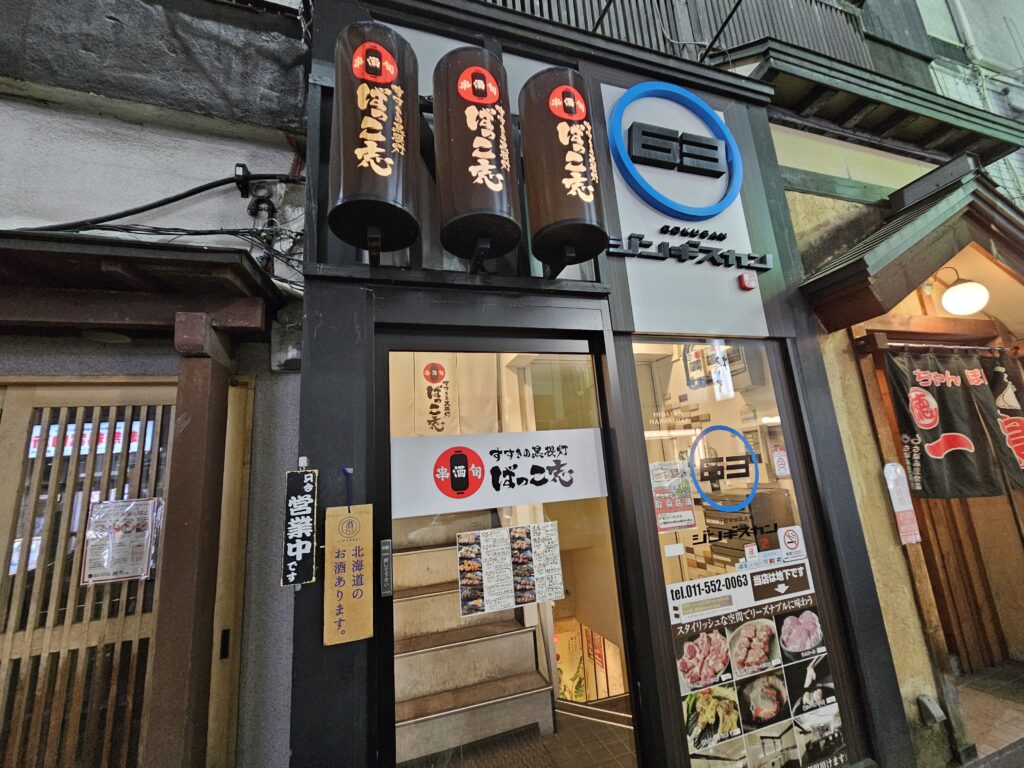
The layout strongly resembles that of a Korean BBQ place with grills at every table and at the counter which is where I sat.
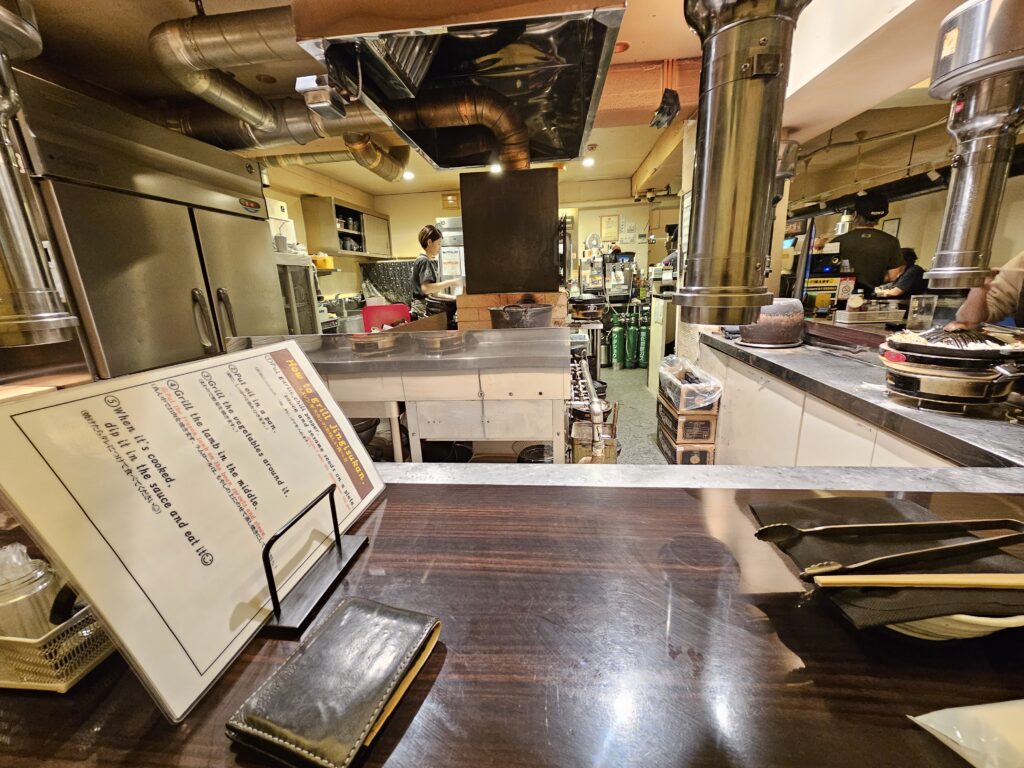
These grills though, unlike Korean BBQ grills, have that unique “helmet” like shape to them.
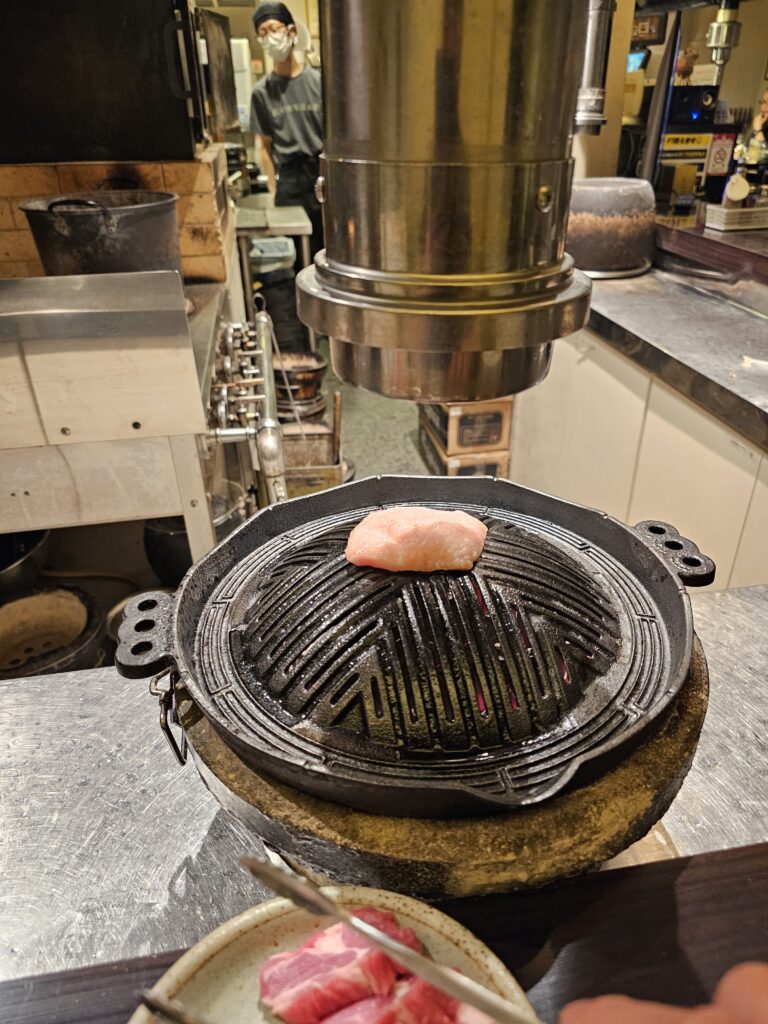
The experience is also unique since you get a piece of fat to grease up the grill.
I loved that they had a simplified English menu here. There was an easy to choose trial set that included grilled vegetables, lamb chuck, lamb dice steak, frozen lamb slices, and a sausage set (1900 yen, $12.56). I opted for this since I wanted to give everything a try and figured these were the most popular lamb cuts.

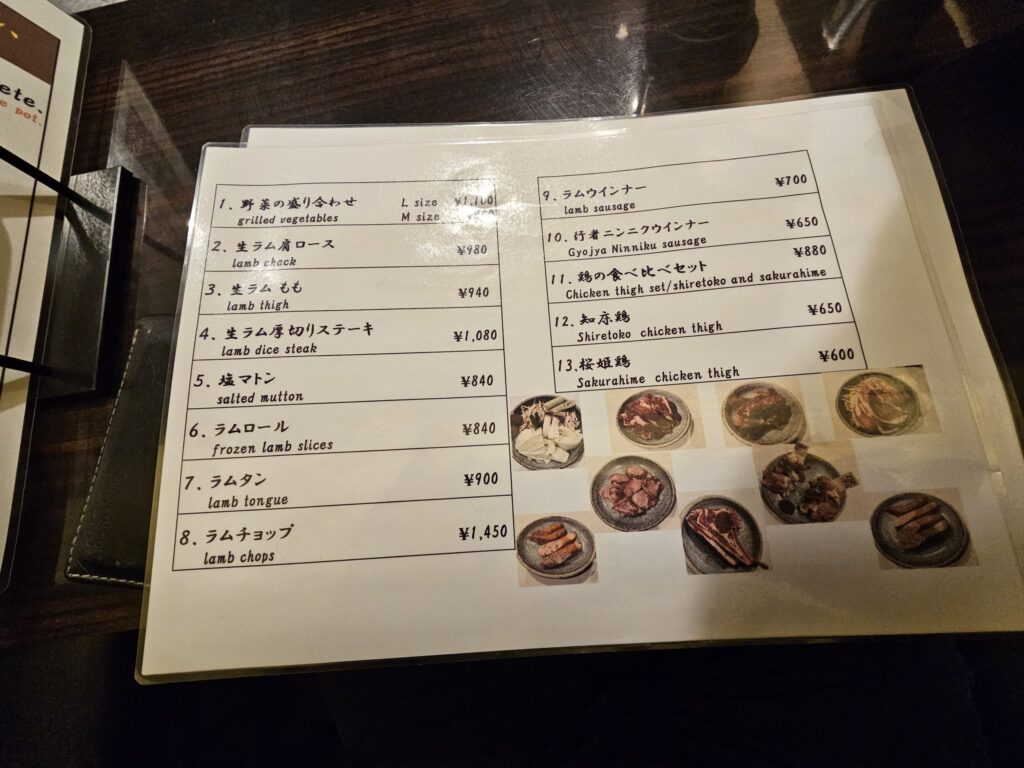
Something else that was helpful was they offered English instructions on how to make the dipping sauce and properly grill everything, which was definitely helpful for a complete noob like myself.
Without this there definitely would have been some trial and error or awkward staring at others to figure out how to correctly cook everything, lol.
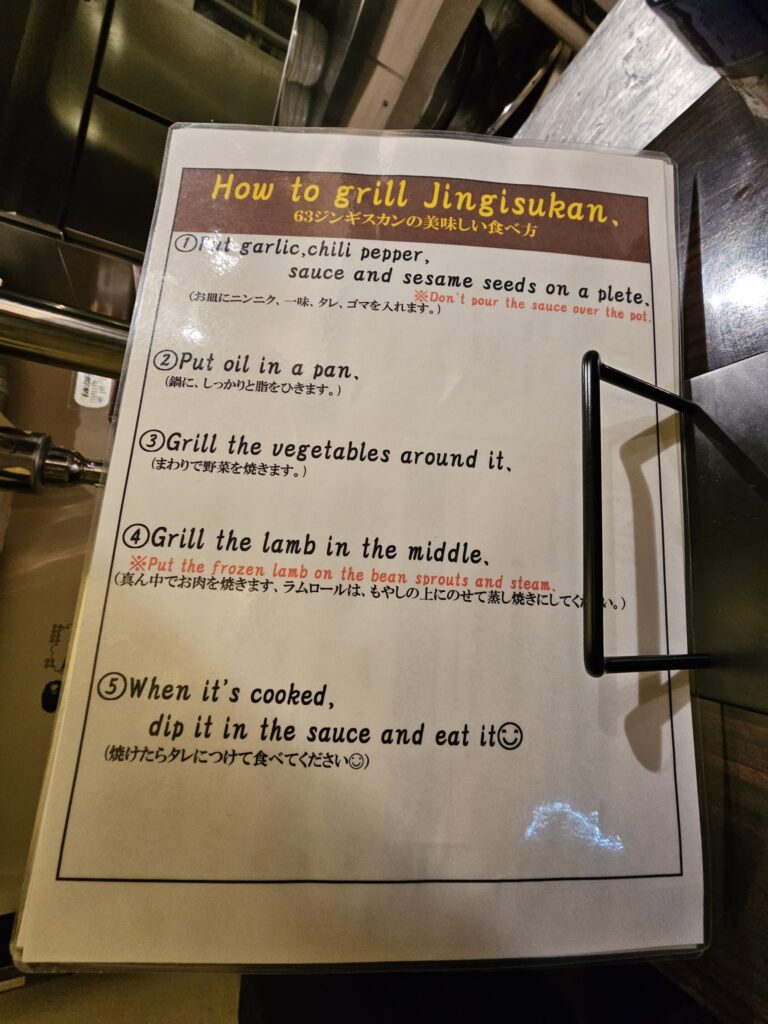
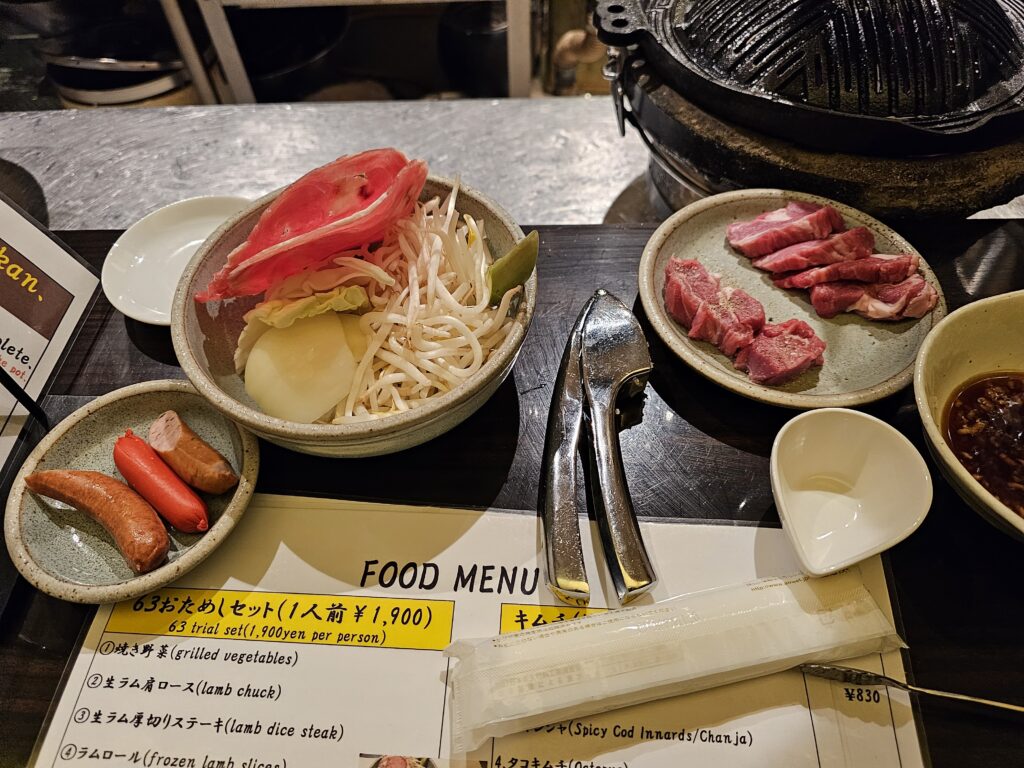
This was the spread of everything included in the meal. It didn’t turn out to be a TON of food, but I think it’s meant more to be a sampler, then you can order more a la carte.
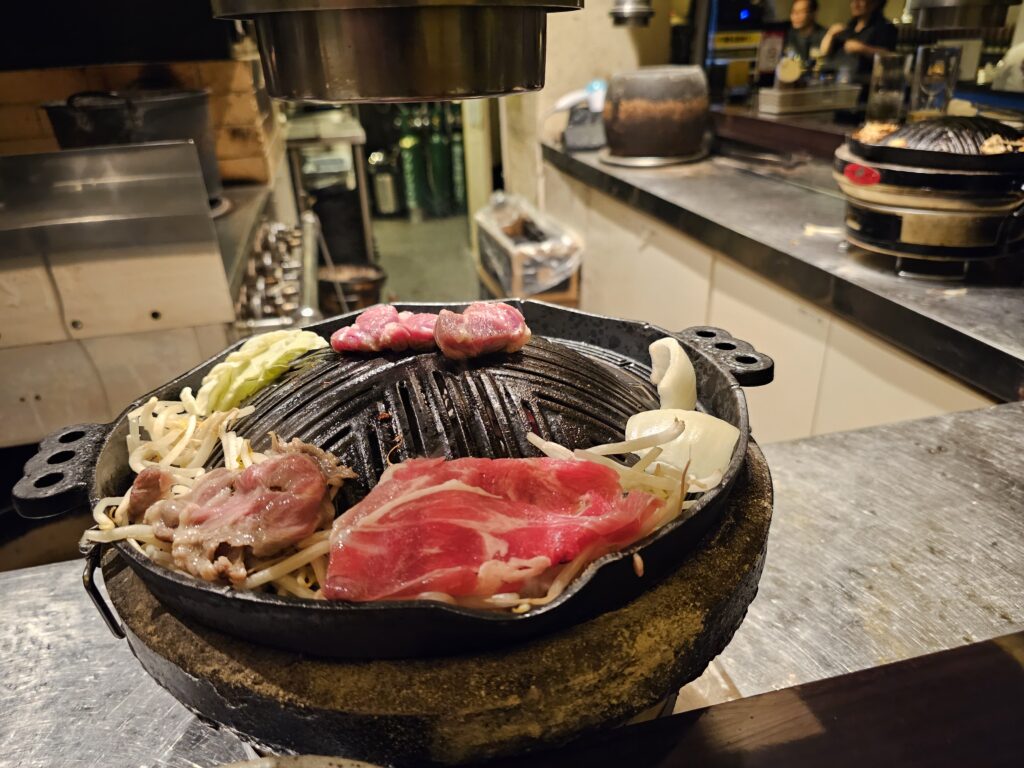
This is how it all looks when you throw it on the grill. For the frozen lamb, since it’s so thin, you put it on top of the vegetables to cook as they absorb the juices that roll off the meat.
After this it’s just straight grilling meat. I’m no lamb connoisseur but found this to be very good. The meat was really tender and juicy. I expected it to be a little gamey but didn’t notice that at all with these pieces.
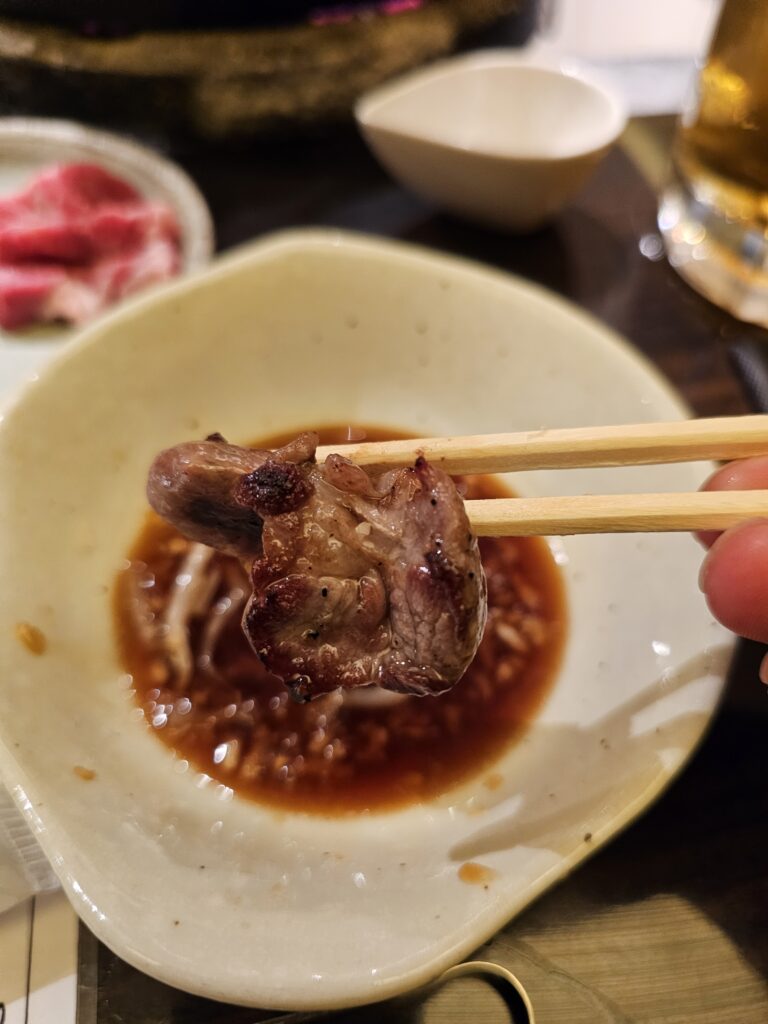



The dipping sauce which consisted of garlic, chili pepper, sesame seeds, and soy sauce complements the flavor of the meat well.
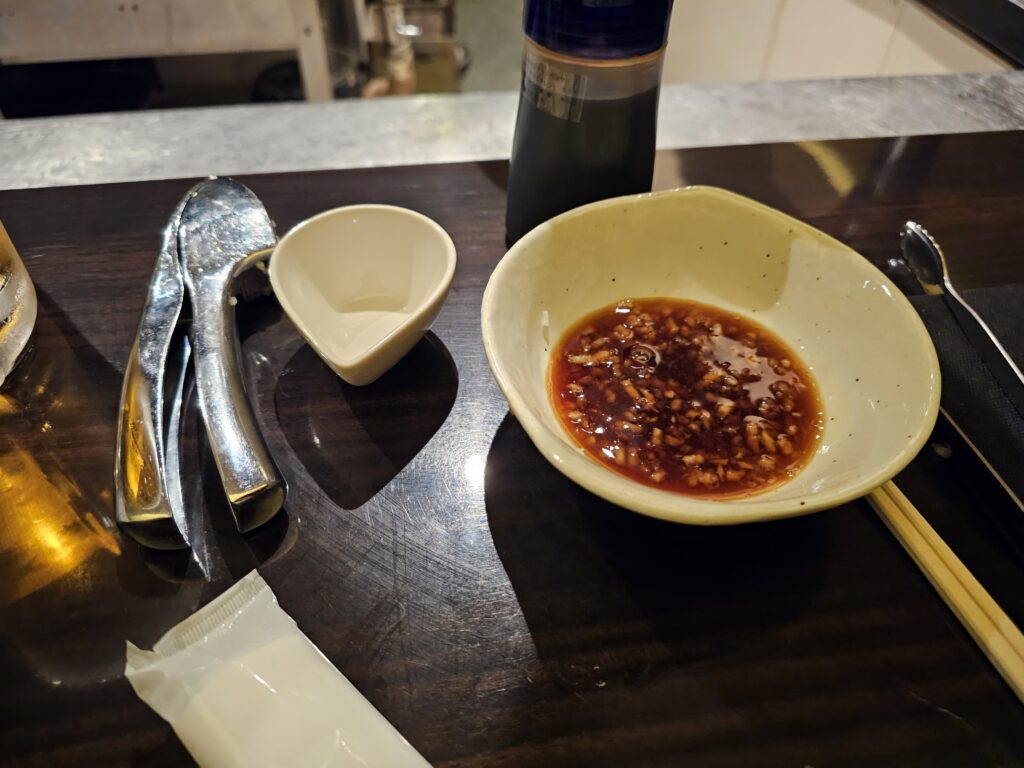
Final Thoughts
Overall, the meal was very good. Any one that’s had Korean BBQ will feel at home eating this meal. There’s obvious familiarity with it, just with a slight twist due to the the grill. It’s a really fun experience. Grilled meat with an ice cold beer, you can’t ask for much more. Without a doubt Genghis Khan BBQ is something you’ll want to try if visiting Hokkaido. It’s immensely popular for a reason!
On a side note, I’m not sure if it’s the case everywhere in the city (Sapporo specifically), but I found that reservations are definitely needed around dinner time.
I was able to get into 63 Roksan but they did ask if I had reservations (I did not). They were kind enough to accommodate me but other places I went to for Genghis Khan BBQ were fully booked for the evening and couldn’t seat me without a reservation. So I’d definitely recommend booking a reservation if interested in giving Genghis Khan BBQ a try. This is one popular meal in the city!
-
The Ramen Alley in Sapporo Hits The Spot For Ramen Lovers
What is the Ramen Alley in Sapporo?
The Ramen Alley in Sapporo is located in the lively Susukino district. This narrow alley has been around since 1948. Shockingly, there’s nothing but ramen shops found in this delightful alleyway, who thought with a name like that? Lol. The original Ramen Alley opened up with eight total ramen shops. There are now 17 that line the famous alley. Miso Ramen was also created here, adding to the lore.
These shops are all quite tiny, most likely seating no more than 7-15 people from what I could gather walking by. Since this is a tourist spot expect crowds, especially at peak lunch / dinner times for the most popular spots. All the shops have varying hours as well so if you know the specific place you want to go to make sure to check their hours.
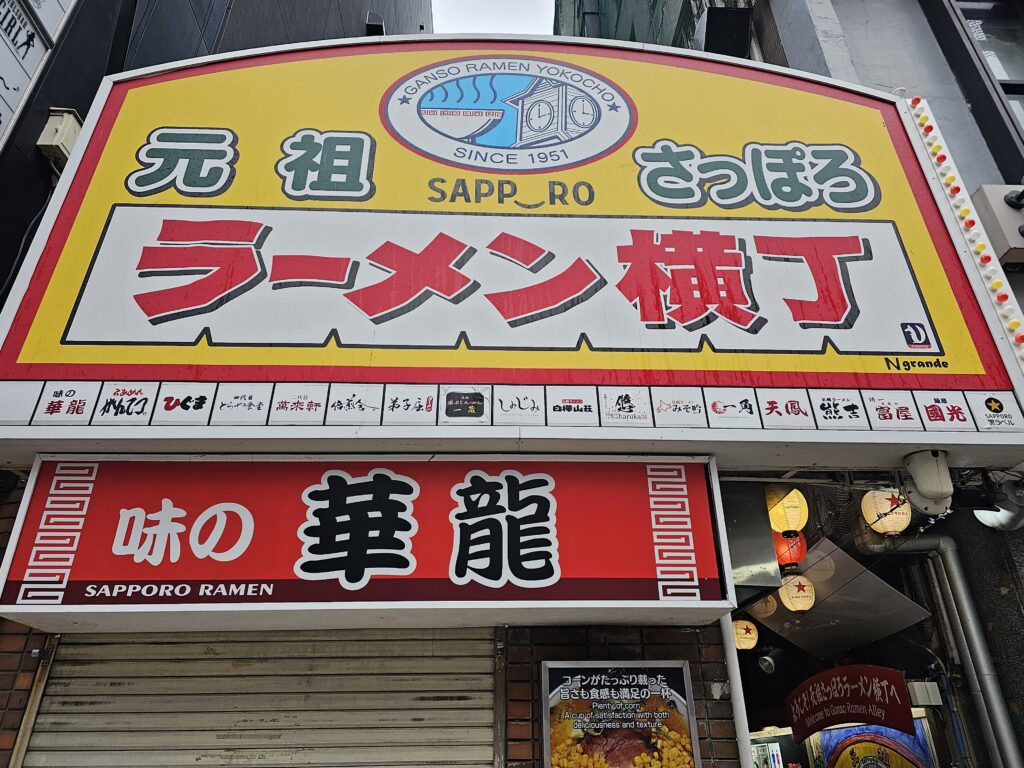
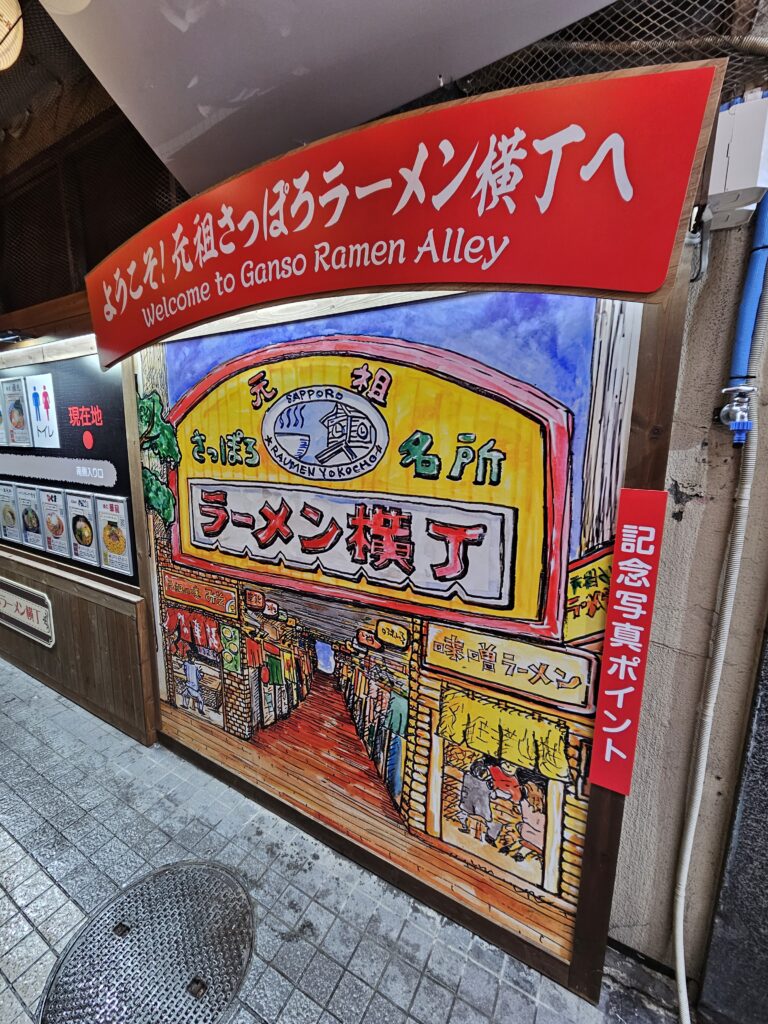
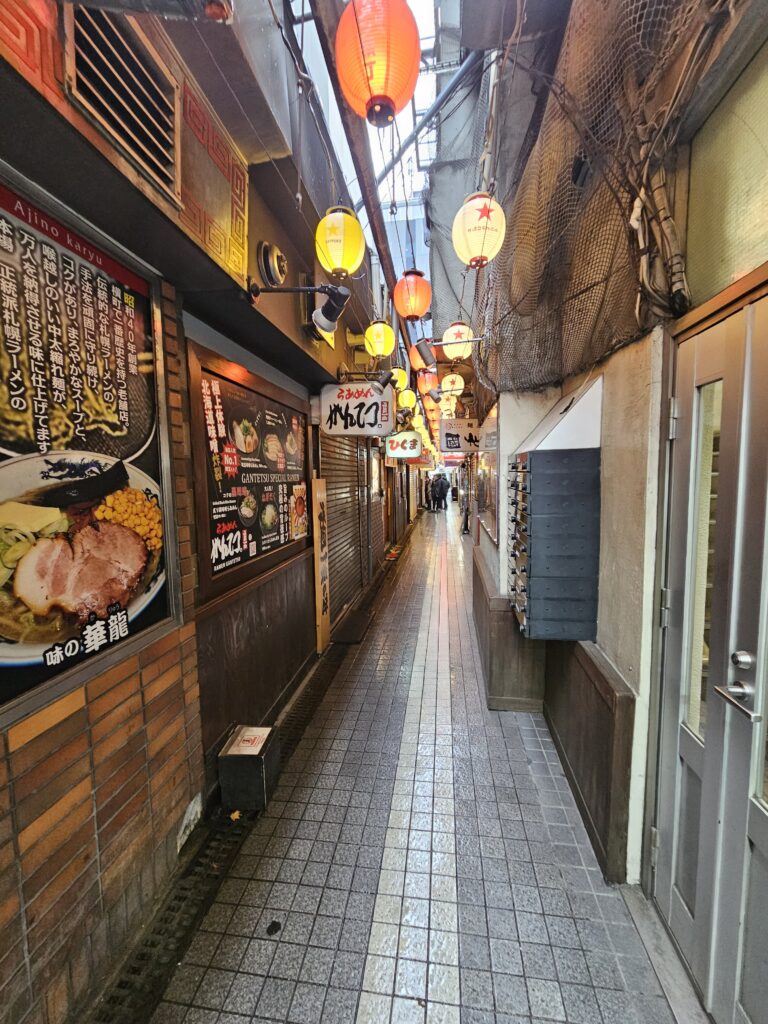
I got here at an odd time when some shops weren’t open yet but was able to find a seat at Ichi Kura.
Ichi Kura
Ichi Kura was one of the places that were open and had available seats. I hadn’t done any research on the individual shops themselves, so I wasn’t sure what the most popular or well-know shops were. The ramen pictured in front of the shop looked great though so I decided to give it a try.

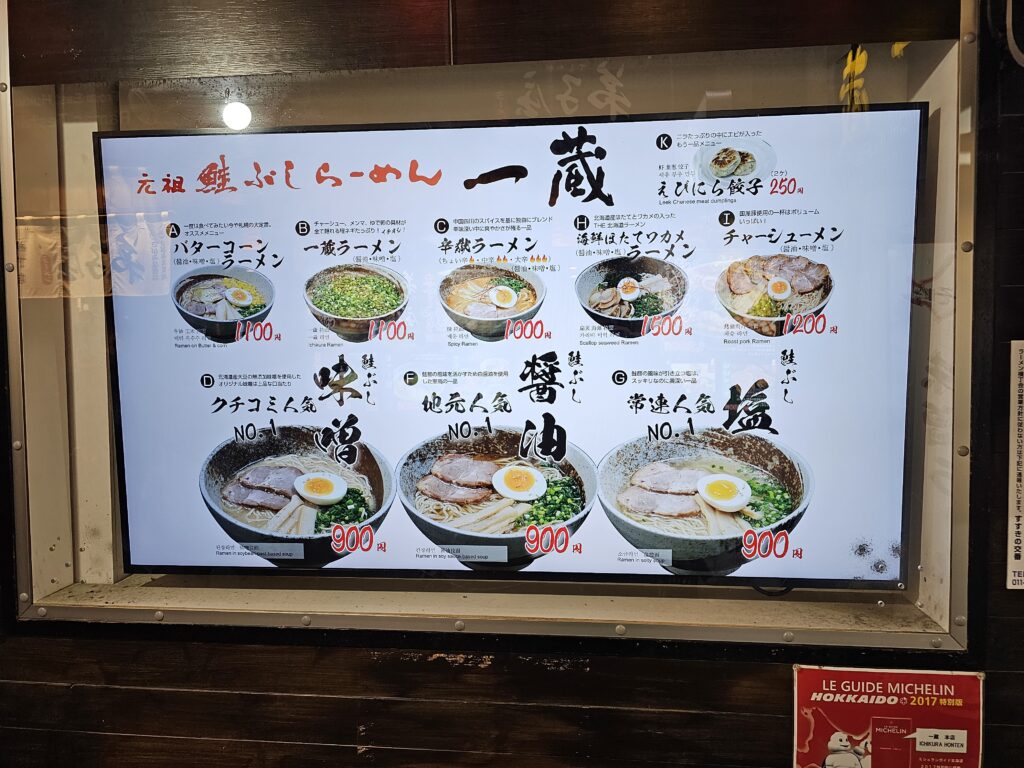
Toppings that are more uniquely associated with Hokkaido include corn and butter. Hokkaido is known for their dairy and produce so this would be the place to get those toppings in your ramen!
The Ramen
Like I mentioned above, the main driving force behing getting this particular bowl was for the butter and corn. I’m not entirely sure what the broth was, possibly shoyu, but it was very light. The butter once, melted really adds a richness and creaminess to it which was a welcome addition to the overall flavor. In addition to the butter and corn the ramen was topped with bamboo shoots, green onion, half an egg, and chashu.
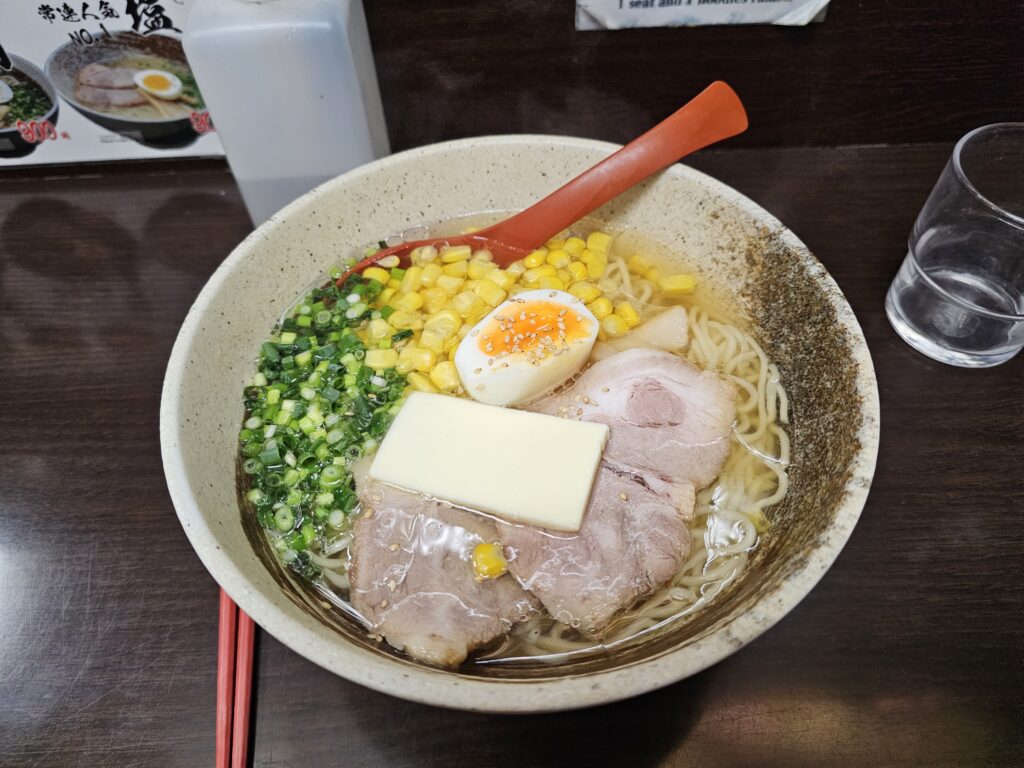
The semi-firm noodles were light, springy, and fresh. The egg was nice and runny, and the corn was definitely sweet. All solid additions to go along with the bamboo and green onion. The chashu was good, but nothing to really write home about. Definitely tender but was lacking in flavor to a certain extent. Overall the bowl of ramen was really good. I did enjoy the butter and the corn so I was glad I got the chance to give it a try.
Is the Ramen Alley in Sapporo worth a visit?
If you’re a ramen lover like myself, without a doubt you’ll want to visit the Ramen Alley in Sapporo. Can you imagine an alley lined with nothing but ramen shops? It’s a ramen lover’s dream! It’s just a cool experience as well since the alley is quite narrow and the shops are all quite small. It’s fun walking by and checking out the different types of ramen that each shop offers. Next time I go I’ll have to do a better job of researching the restaurants to know which ones I should target!
-
The Unique Lucky Pierrot In Hakodate, Japan Is A Must Visit
Lucky Pierrot – Background
Lucky Pierrot is a chain of hamburger restaurants located in Hakodate which is located in Hokkaido in Japan. Founded in 1987, Lucky Pierrot has 17 restuarants…all located in Hakodate. It’s immensely popular there.
So what makes it unique? In the age of franchising and trying to make as much money as possible, Lucky Pierrot has resisted doing so. It’s only found in Hakodate. The owner, Ichiro Oh, has kept the local brand, well, local, despite overtures to grow the brand outside of Hakodate. All ingredients used at the restaurants are local and fresh which wouldn’t make it possible to open restaurants outside of Hakodate. In a time when restaurant chains are always looking to expand and grow, Lucky Peirrot has done the opposite in order to ensure their quality standards don’t suffer. It’s quite a refreshing and admirable stance in this day and age.
Something else that’s unique is that all 17 restaurants have their own individual flair and personality. There isn’t a standard Lucky Peirrot layout that all 17 follow. So really each time you step into one of them it’s a little different experience since they all have a different theme.
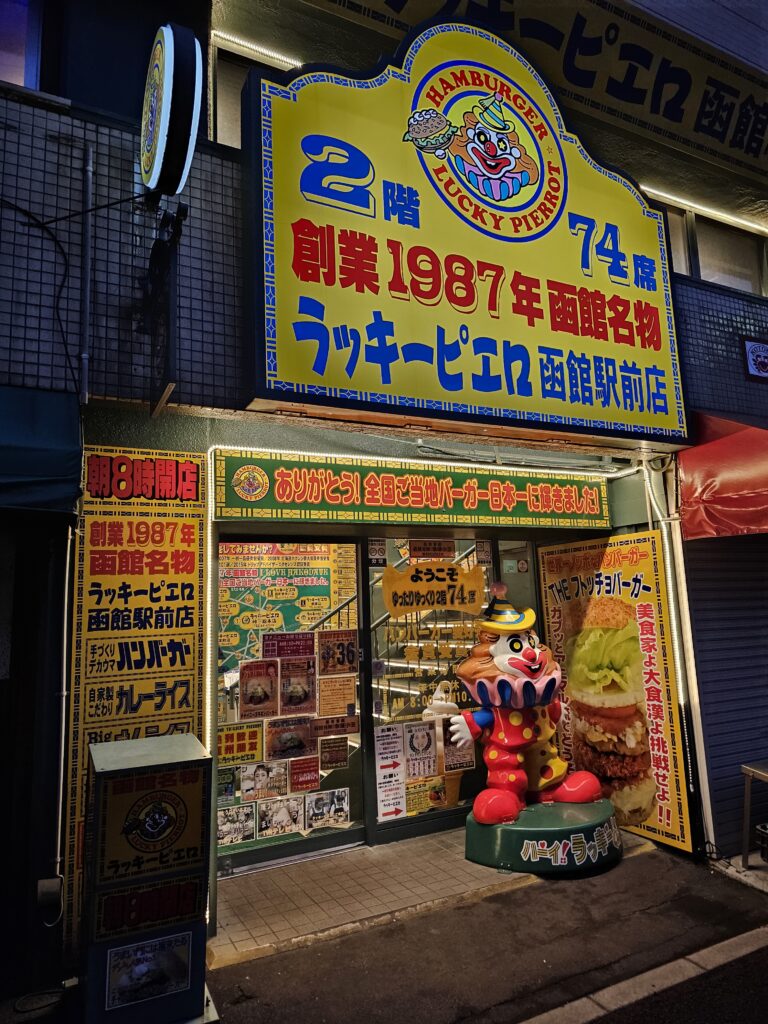
The Experience
There’s a lot going at at Lucky Pierrot’s. The restaurant I went to was pretty hectic with the decorating and VERY colorful. It’s pretty kitschy but in a positive, fun vibey way. They also have a portion of the store with various souvenirs. They even have their own brand of drinks, including an energy drink!
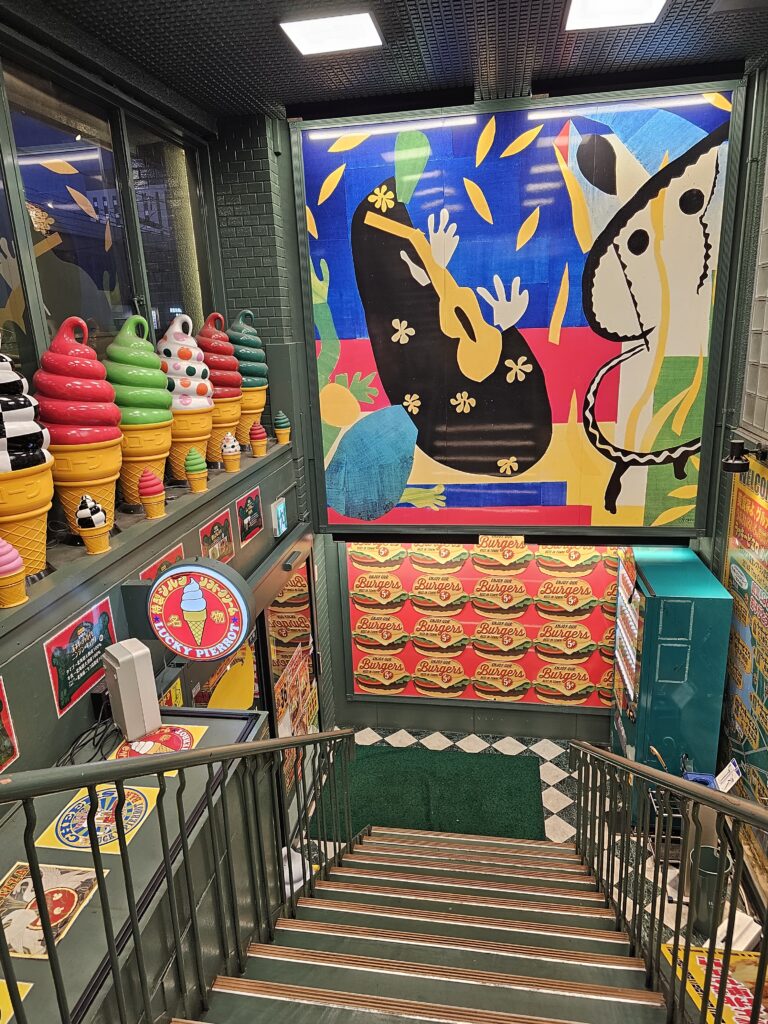
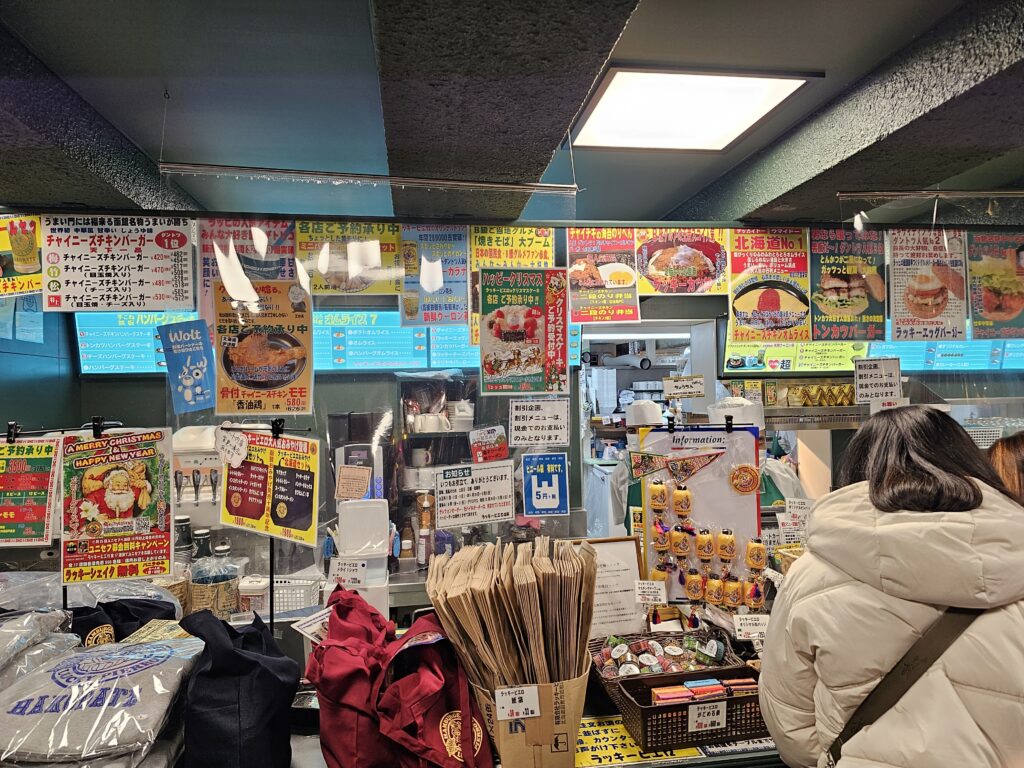
The menu is pretty expansive with a variety of food. There’s burgers, sandwiches, curry plates, pork cutlet bowls and plates, hamburg and steak dishes, and fried noodles. There’s A LOT to sort through. I already knew what what I wanted to try here though. The Chinese Chicken Burger is the original burger and what Lucky Pierrot is well-known for so I had to give it a try!
The Food
I got the #1 combo which consisted of the Lucky Pierrot Chinese Chicken Sandwich, fries with cheese / gravy, and drink (550 yen, $3.66) and also got a soft serve vanilla ice cream on the side (290 yen, $1.93).
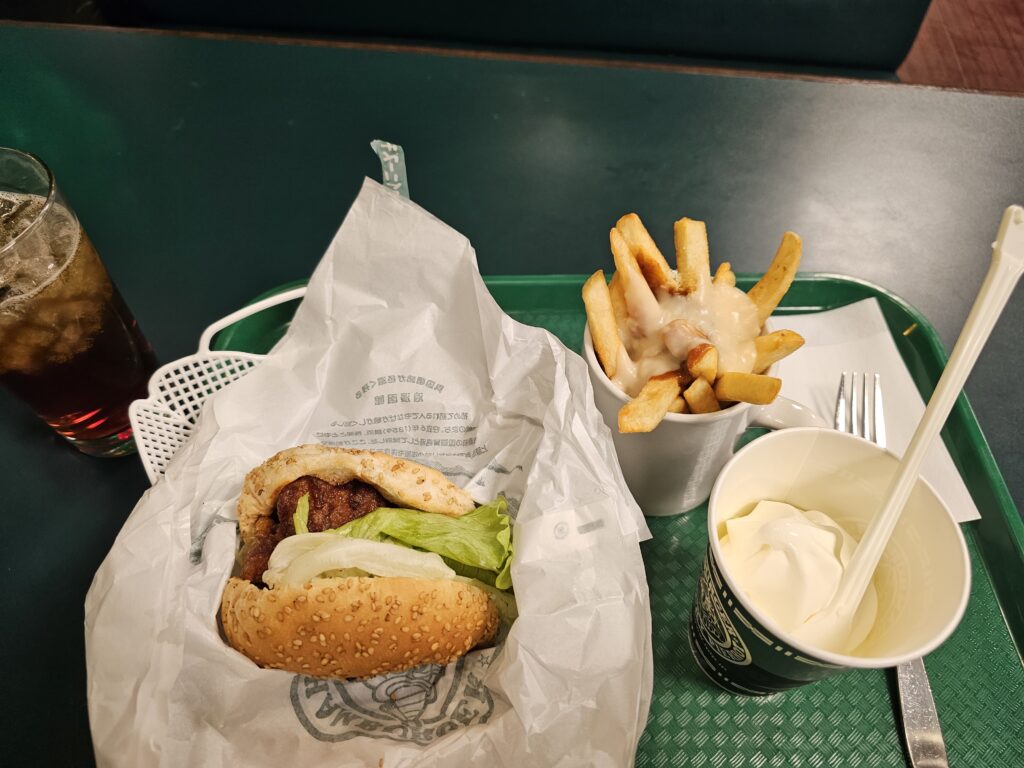
The chicken sandwich consists of two pieces of fried chicken lathered in sauce (think orange chicken essentially) with lettuce and LOTS of mayonnaise. That’s it. Chicken, lettuce, and mayonnaise. It’s a very simple sandwich. The pieces of chicken are tasty and are actually quite tender. There’s just way too much mayonnaise. I had to scrape some of it out. Overall, it’s a pretty decent chicken sandwich.

The cup of fries is lathered in a combination of like a cheese sauce and gravy mixture. I’m not exactly sure what it is exactly to be honest. The taste reminded me of dipping sauce for tonkatsu. So pretty interesting taste and texture to it. The fries themselves weren’t too bad. Nothing to really write home about.
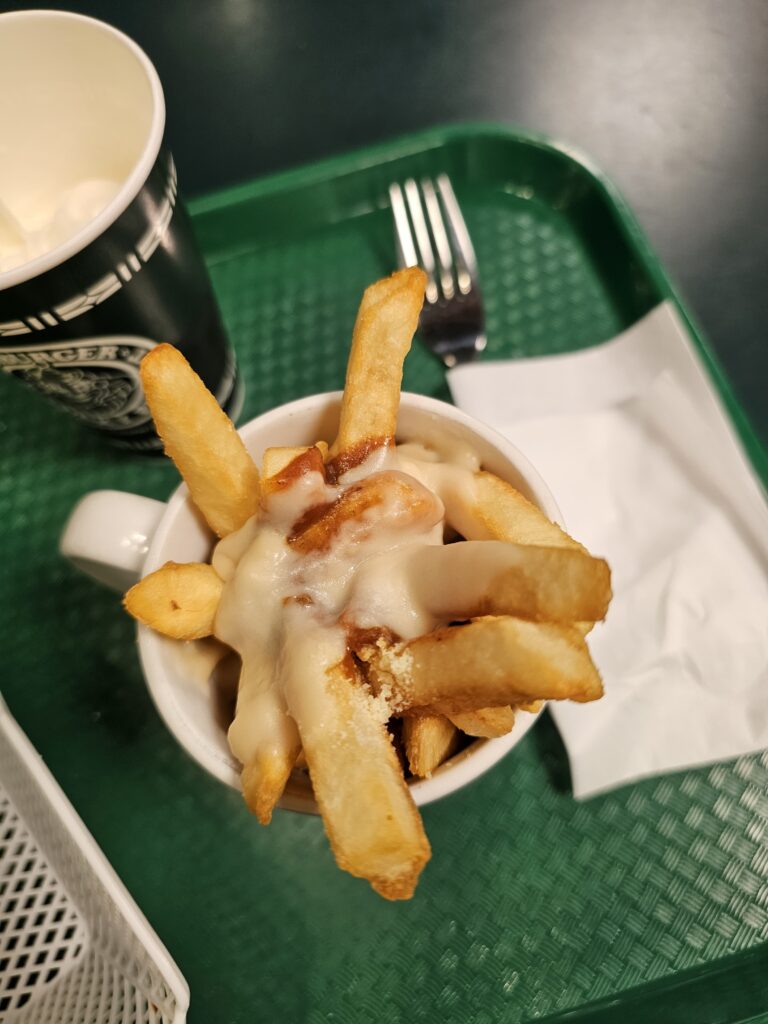
The soft serve ice cream had trademark Hokkaido ice cream traits: rich, creamy, and sweet. I love this style of ice cream. It has very distinct taste to it.
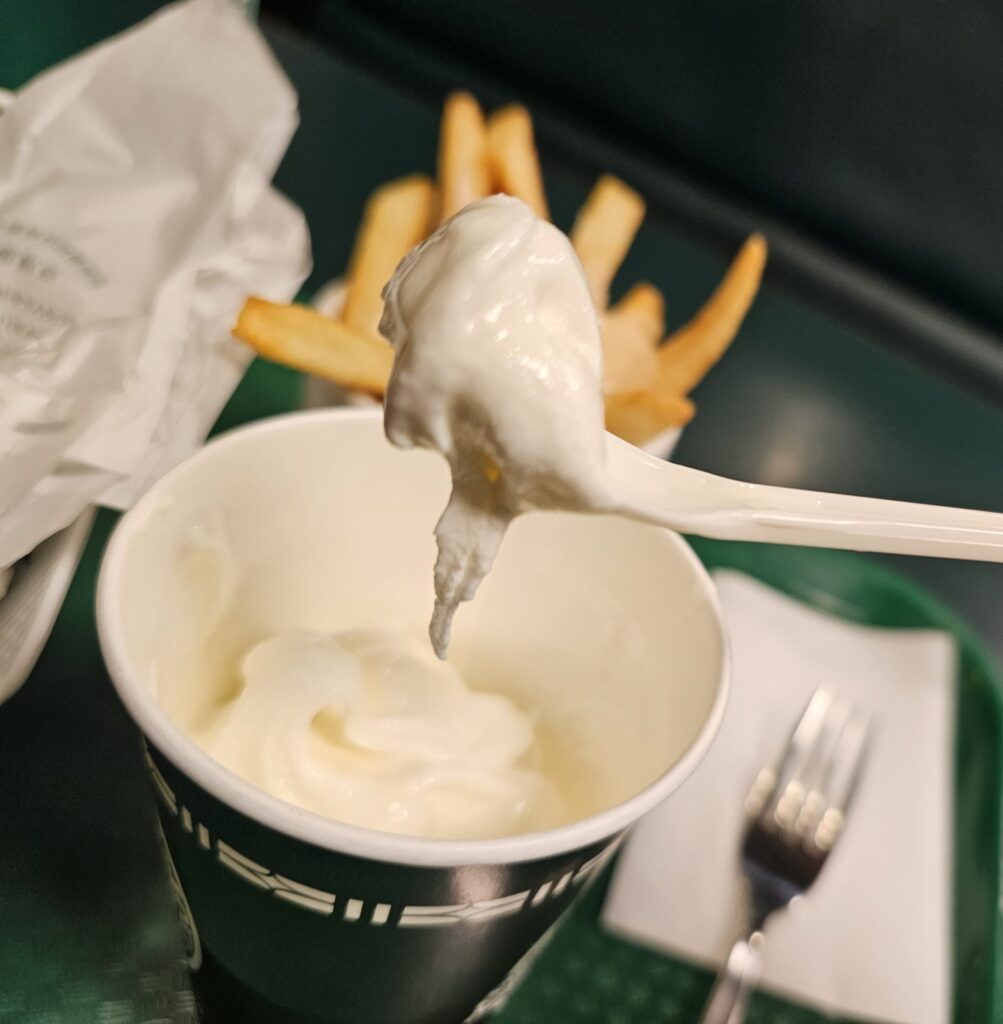
The Verdict
When visiting Hakodate Lucky Pierrot is a must visit. It’s pretty much like if you had never eaten In N Out, you 100% are going to to give it a try if you visit a state that has it. Lucky Pierrot is the In N Out of Hakodate. If you’re visiting Hakodate, you have to try it.
The food that I had was pretty good and very affordable. Nothing really stood out as something that was mind blowing good, but I only had the Chinese Chicken Sandwich and there’s a ton of other options to choose from. The ambience is fun and it’s just a fun to place to come in and grab a quick bite to eat. If you’re not a fan of clowns though, maybe skip it.
-
The Hakodate Morning Market Is A Top Destination When Visiting Hakodate
What is the Hakodate Morning Market?
The Hakodate Morning Market is open from 5 am to about 2 pm, but that can vary by stall / restuarant. The location is very convenient since it’s right across the street from the JR Station. This is a four block stretch in Hakodate that sells fresh seafood, vegetables, fruit, and snacks.
There’s a couple of additional, larger buildings in the area that houses more stalls and restaurants. There’s about 250 places total in this area but it never seems all that dense unlike the Tsukiji Outer Market in Tokyo. That has to do with Hakodate in general being less touristy, so there’s less people, which is quite nice actually.
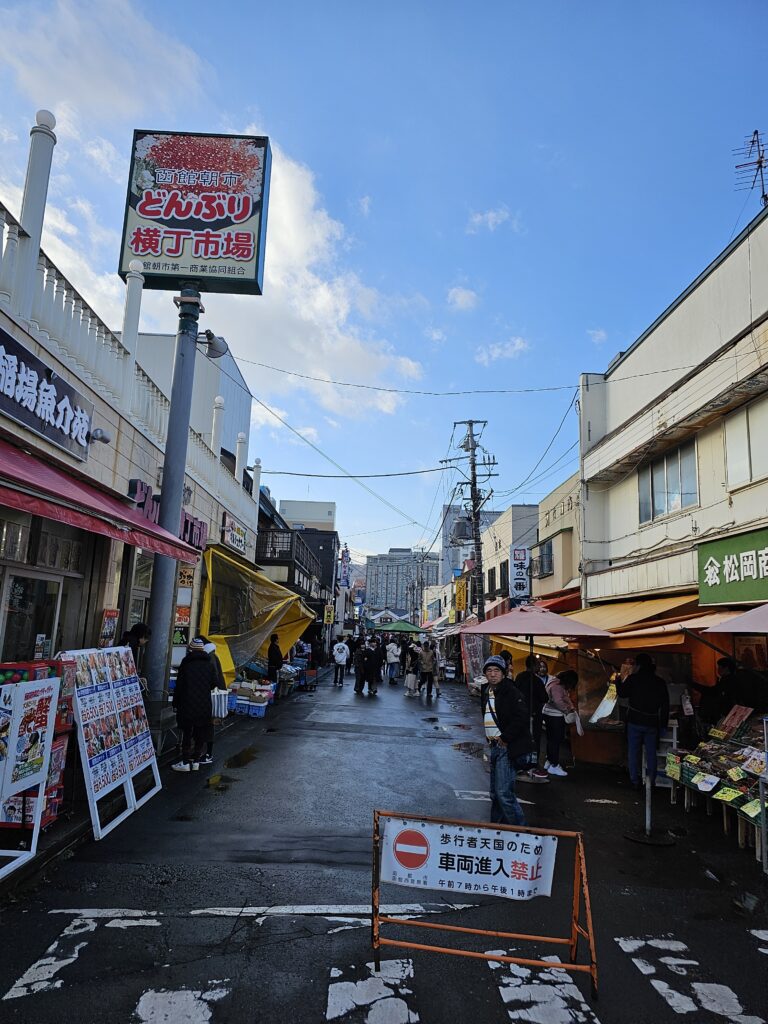
The main drag of the Hakodate Morning Market 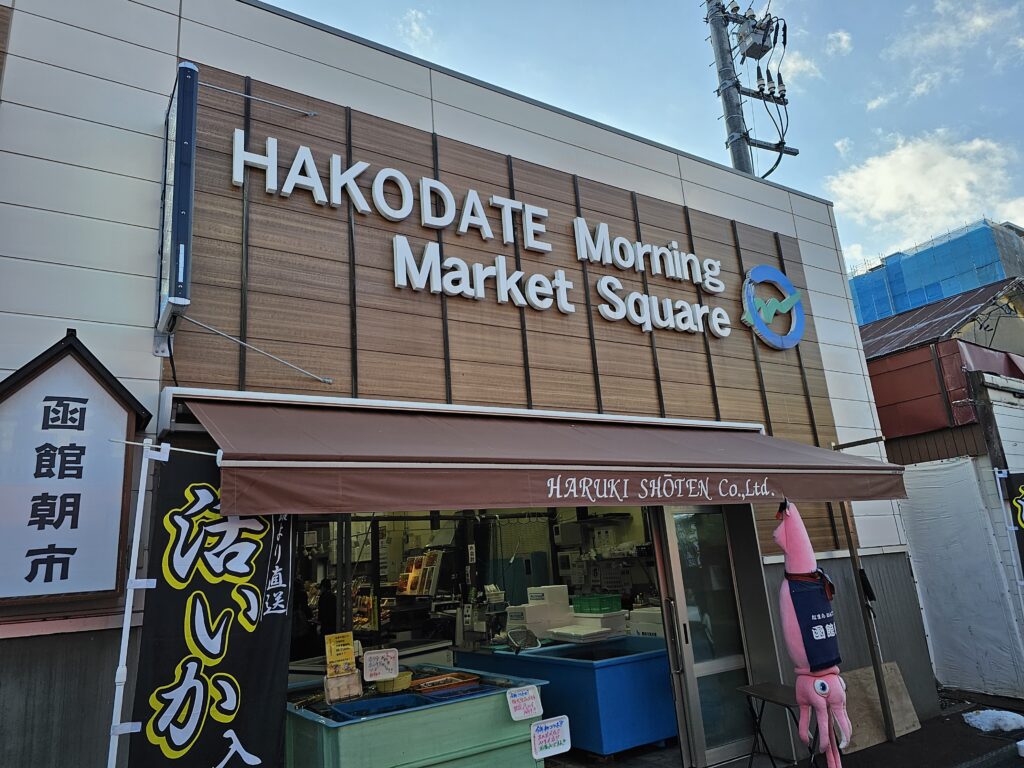
The Seafood
The Steamed Crab Bun
The main draw of coming here is of course the food. Specifically the seafood and the fruit. There’s several types of crab, uni, squid, salmon eggs, scallops, other shell fish, and a whole lot more at this market. As you’d imagine, it’s all very, very good.
To start the morning off I decided to grab a steamed crab bun (450 yen, $3.06).
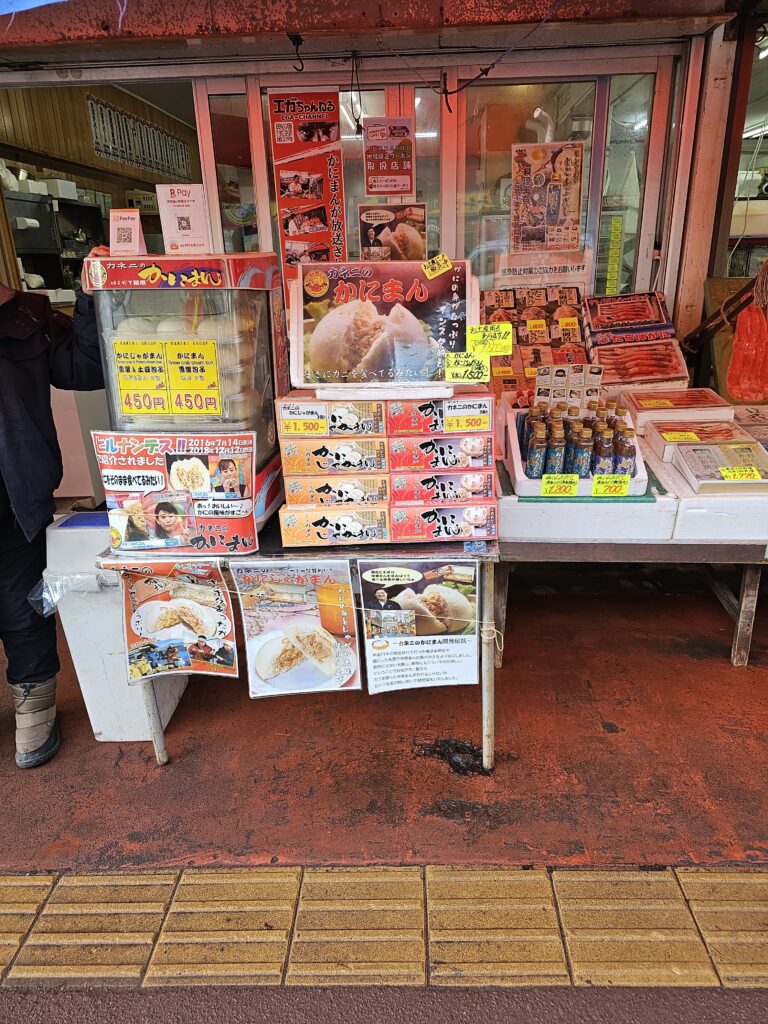
The stall that sells the crab buns 
The steamed crab bun 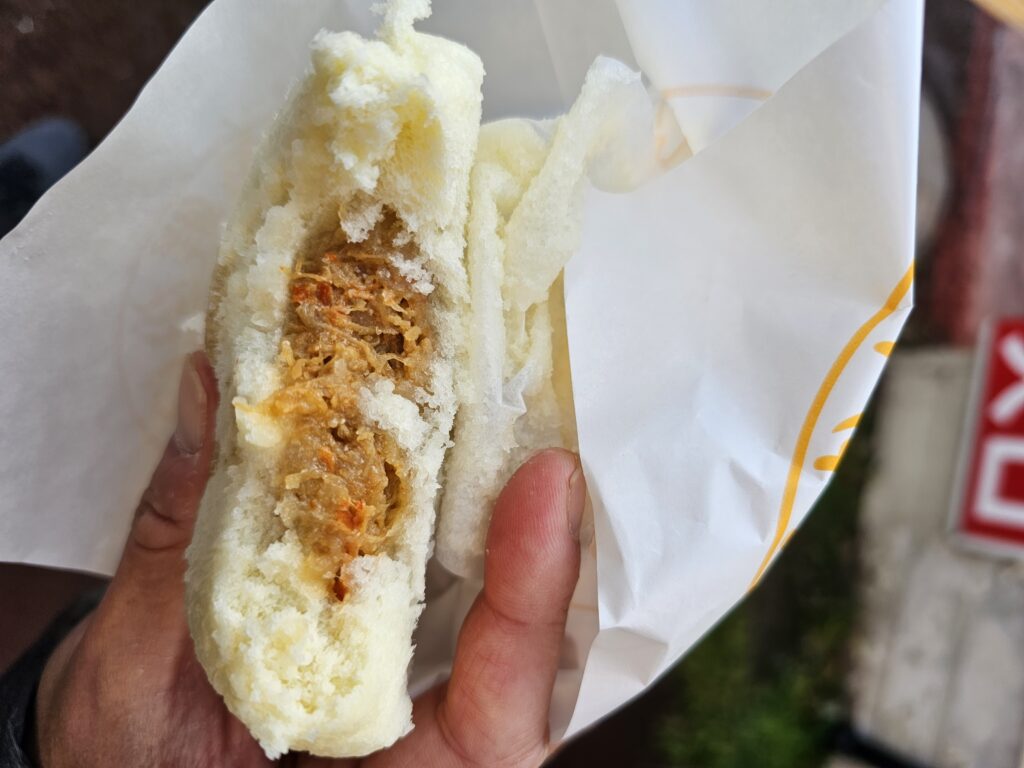
The filling of the crab bun The dough was very light and airy. The filling is a combination of snow crab mixed with some onion and bits of carrot in some kind of sweeter sauce. It’s a little salty and sweet at same time. Crab meat taste gets a little washed out due to all the other ingredients but pretty good.
Donburi
Ikuratei
Now this was something I was looking forward to the most. Donburi is rice-bowl dish that consists of fish, meat, vegetables, or other ingredients. It’s a very popular meal throughout Japan. In the Hakodate Morning Market there are TONs of places that offer donburi with some of the freshest seafood you can find.
There’s a building on the main strip of the market that houses a bunch of restaurants. They all serve pretty much the same type of foods with the same kinds of seafood donburi, with subtle differences. The displays, like the below, showcase all the different types of donburi that restaurant makes and these line the one hallway of the building.
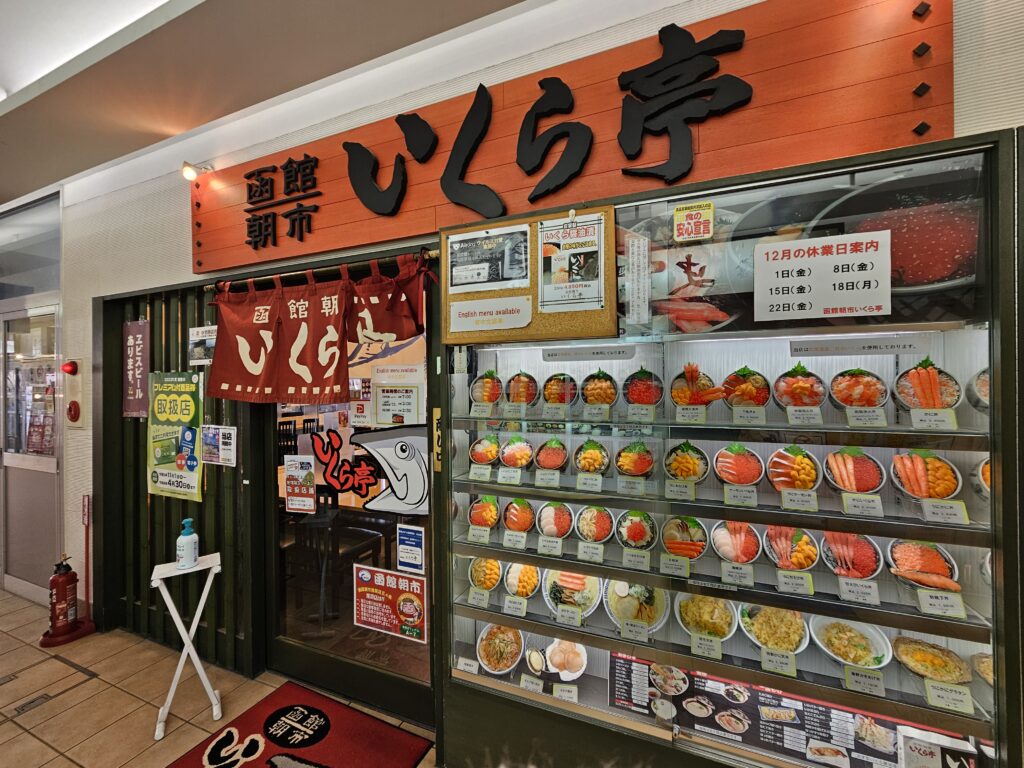
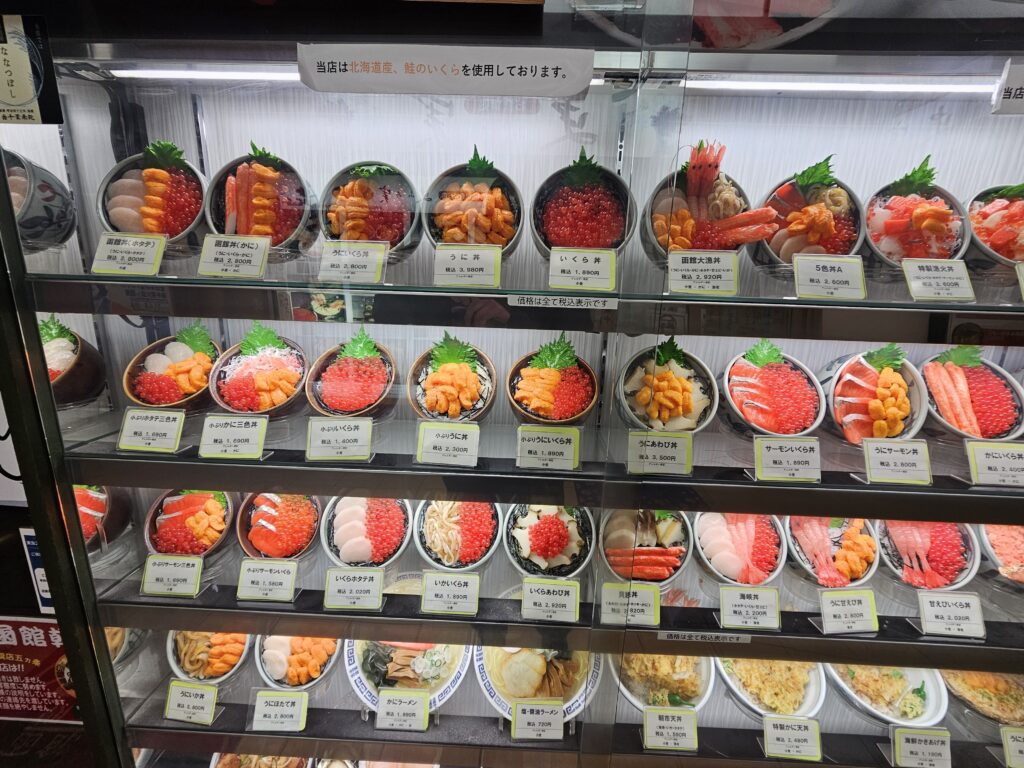
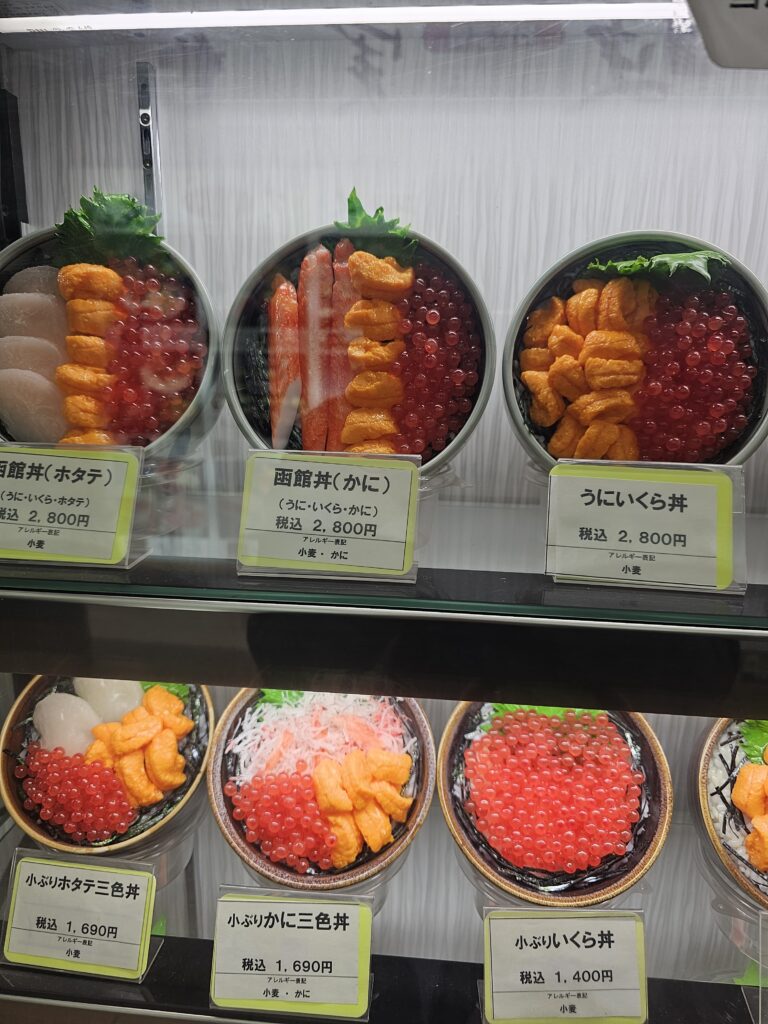
I ate at a couple of the places during my stay in Hakodate with the first being called Ikuratei. The menu is pretty extensive. There’s a lot of different types of donburi to choose from so it can be a tough choice sorting through all the options. It’s odd to be eating fresh fish at about 8 or 9 in the morning but you get used to it and it’s VERY good.
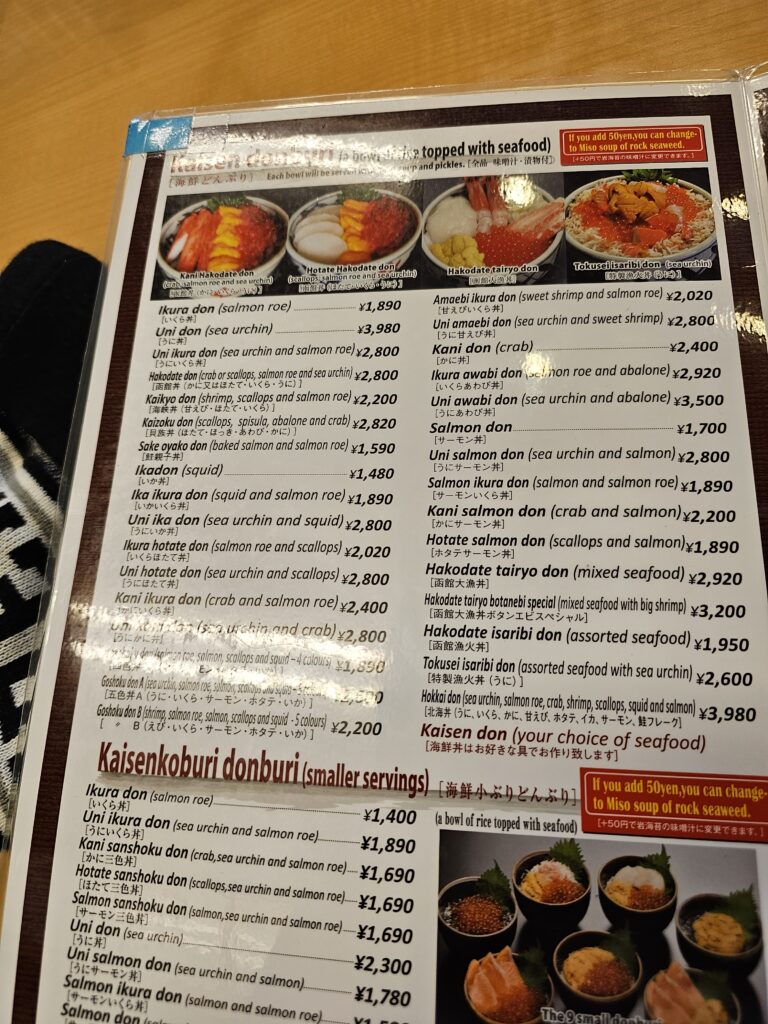
I went with the crab, salmon roe, and uni bowl (2800 yen, $19.03) which came with miso soup and pickled vegetables.
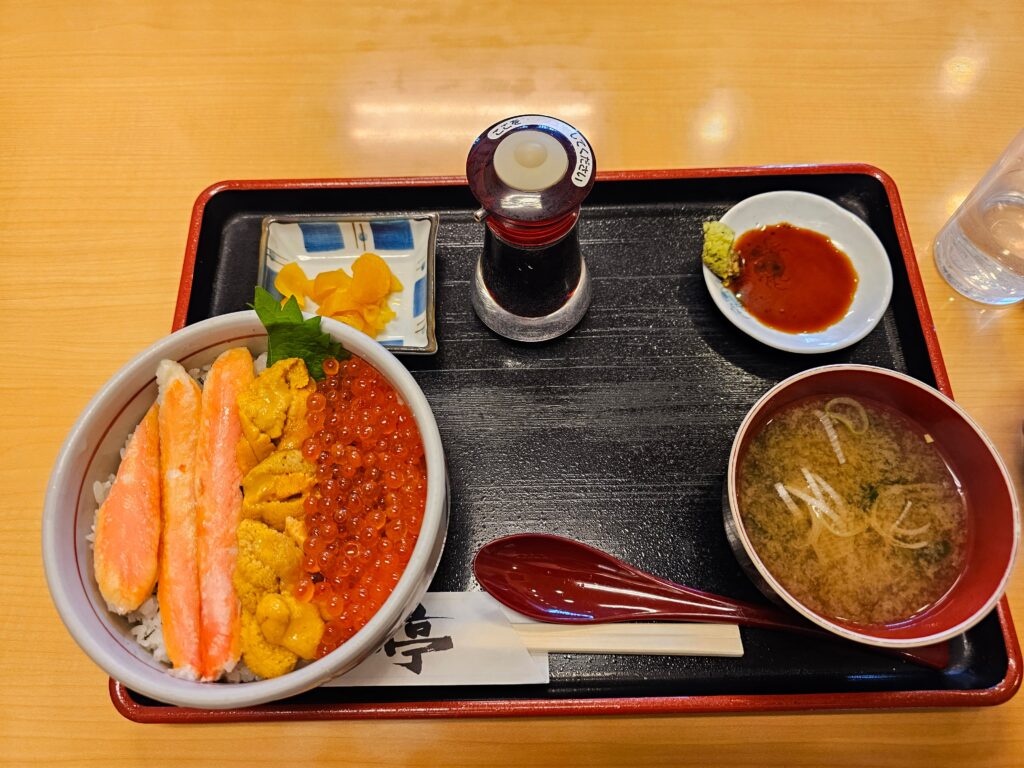
This definitely beats a bowl of cereal for breakfast The crab was insanely sweet and quite salty on its own. I didn’t need to add anything or dip it into any soy sauce. It was the best tasting crab I can ever remember having.
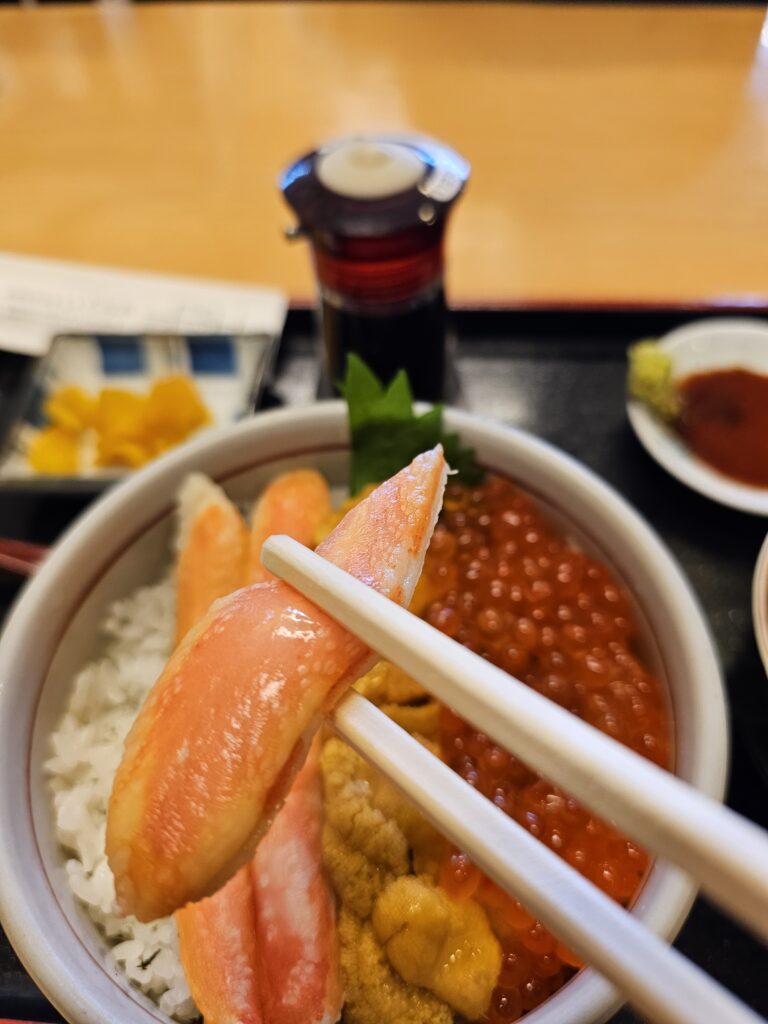
The uni just melted in my mouth. It has that real intense seafoody taste before dissolving. Extremely creamy adn the deep sea taste was quite memorable.
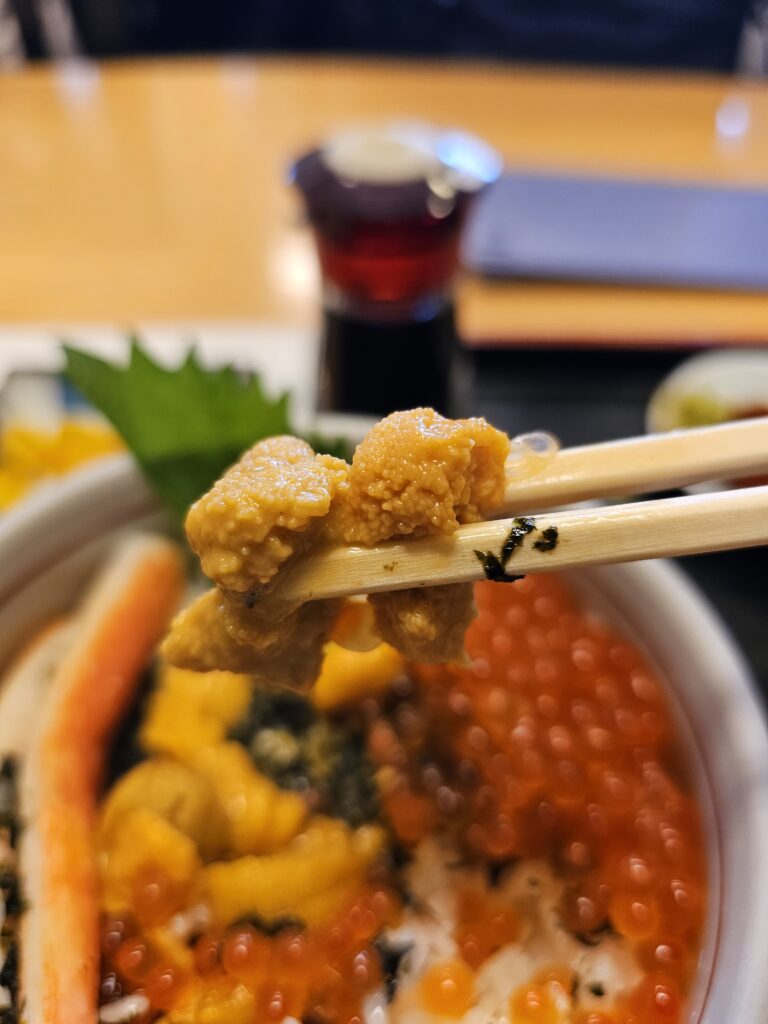
The salmon roe provided a totally different texture to the bowl with that nice popping, burst of flavor with each bite.
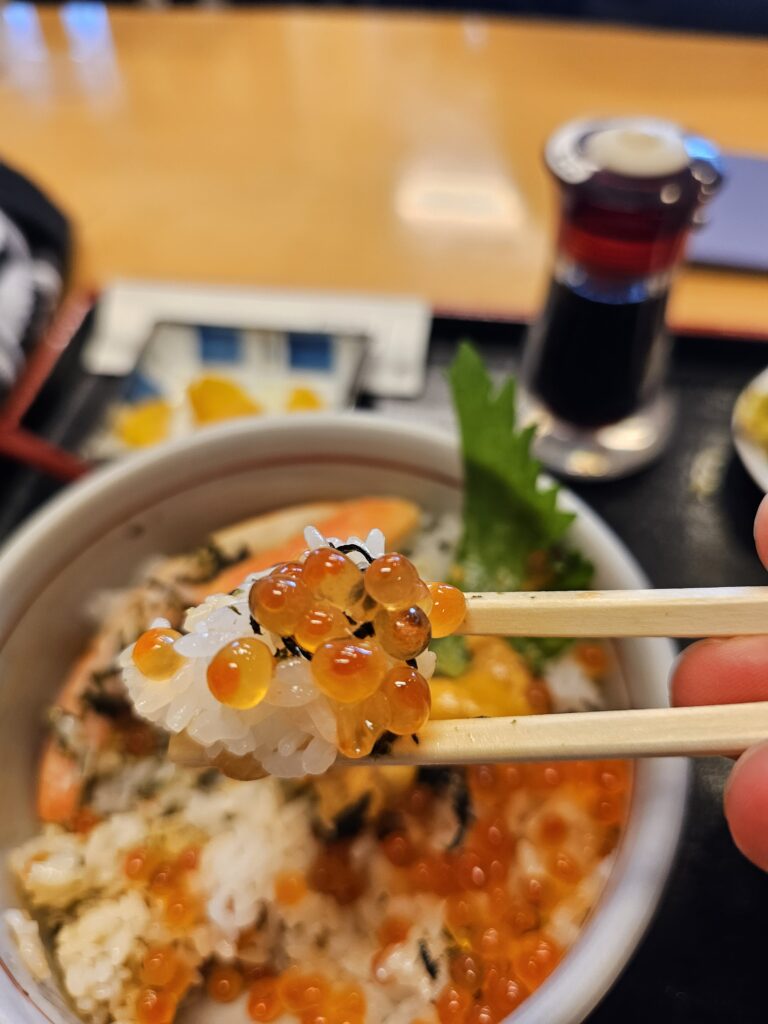
Everything blends together so well. Drizzling some soy sauce over the bowl enchances the flavor as well. The highlight for me was the crab. I couldn’t believe how naturally sweet and salty it was!
Maruishi Shokudo
The second restaurant I went to within the market was called Maruishi Shokudo which was located in the same building as Ikuratei. The menus were very similar. The combination of what kind of seafood was on top of the donburi would be somewhat different from restaurant to restaurant.
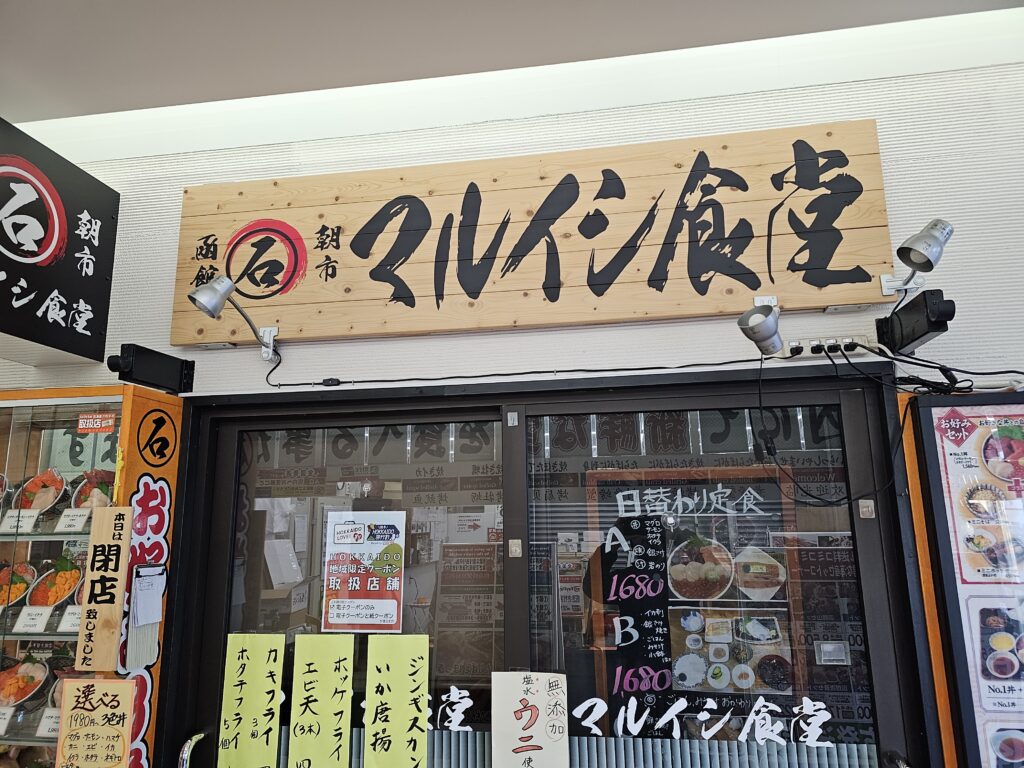
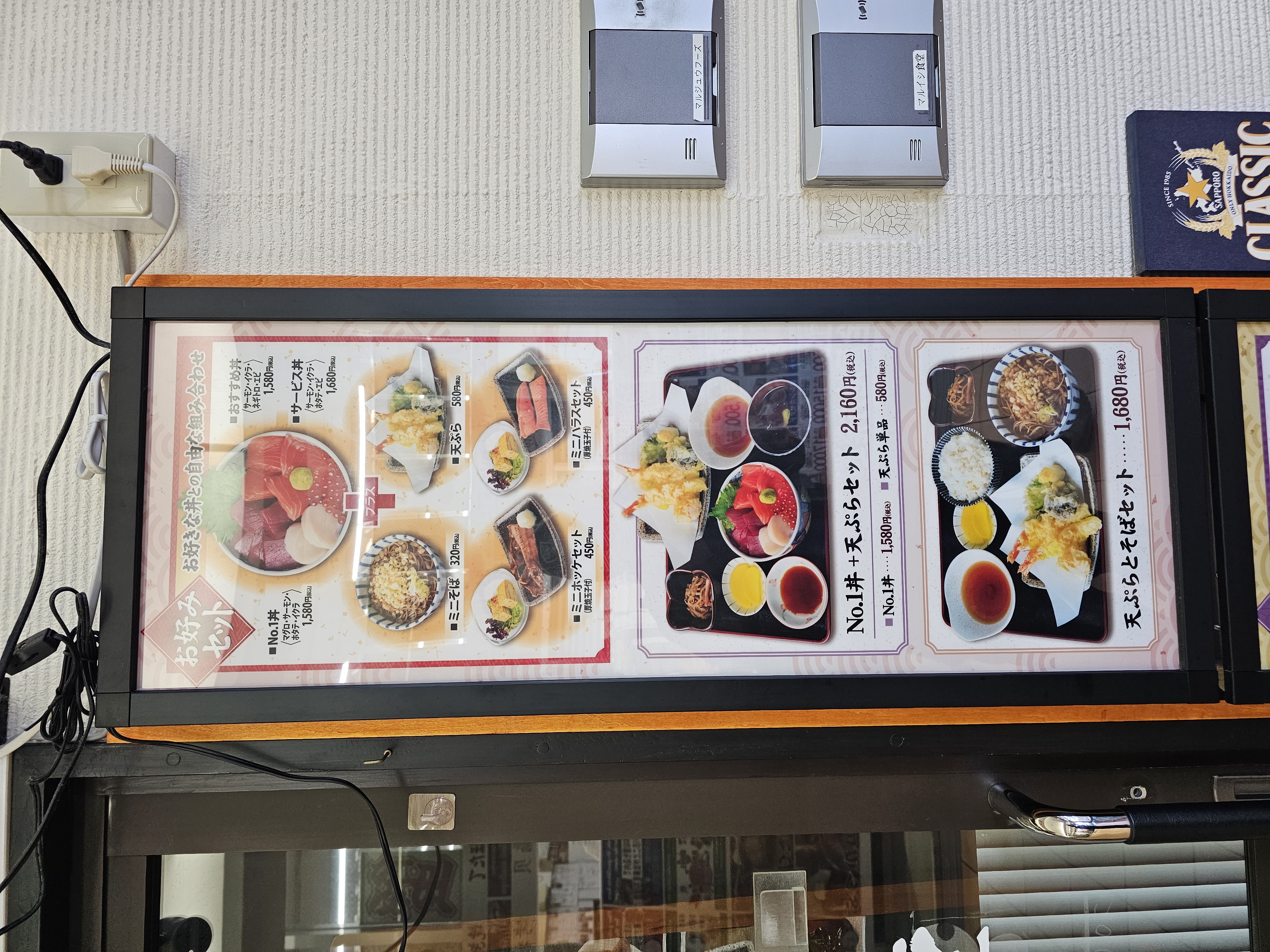

Maruishi Shokudo stood out to me because they had a bowl that included scallops, tuna, and yellowtail (1980 yen, $13.47). I had scallops the previous night for dinner at another restaurant and they were amazing, so I wanted to double down on them for breakfast.

The scallops were tender and extremely sweet. So good!
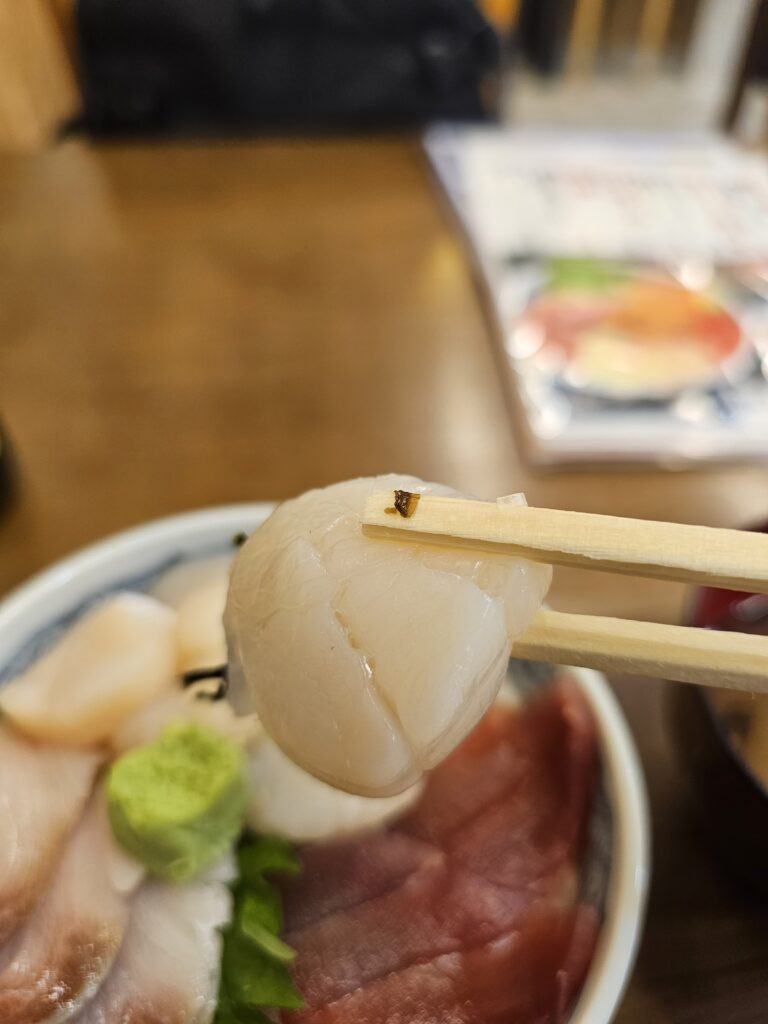
Both the tuna and yellowtail just melted in my mouth. No chewy parts at all.
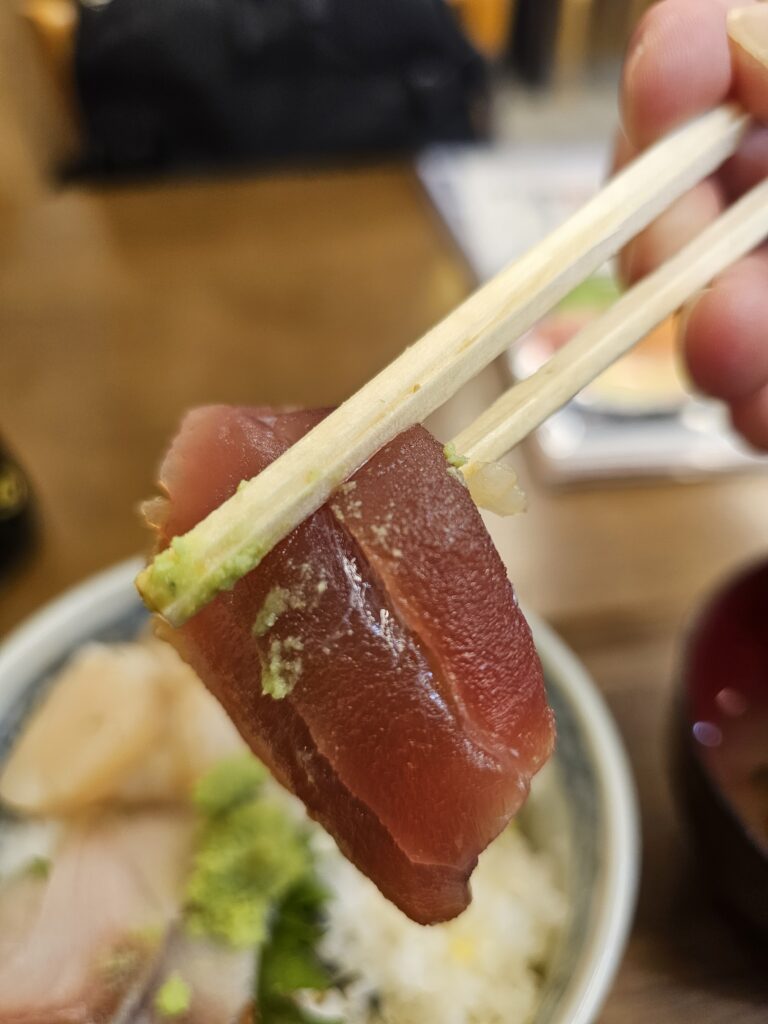
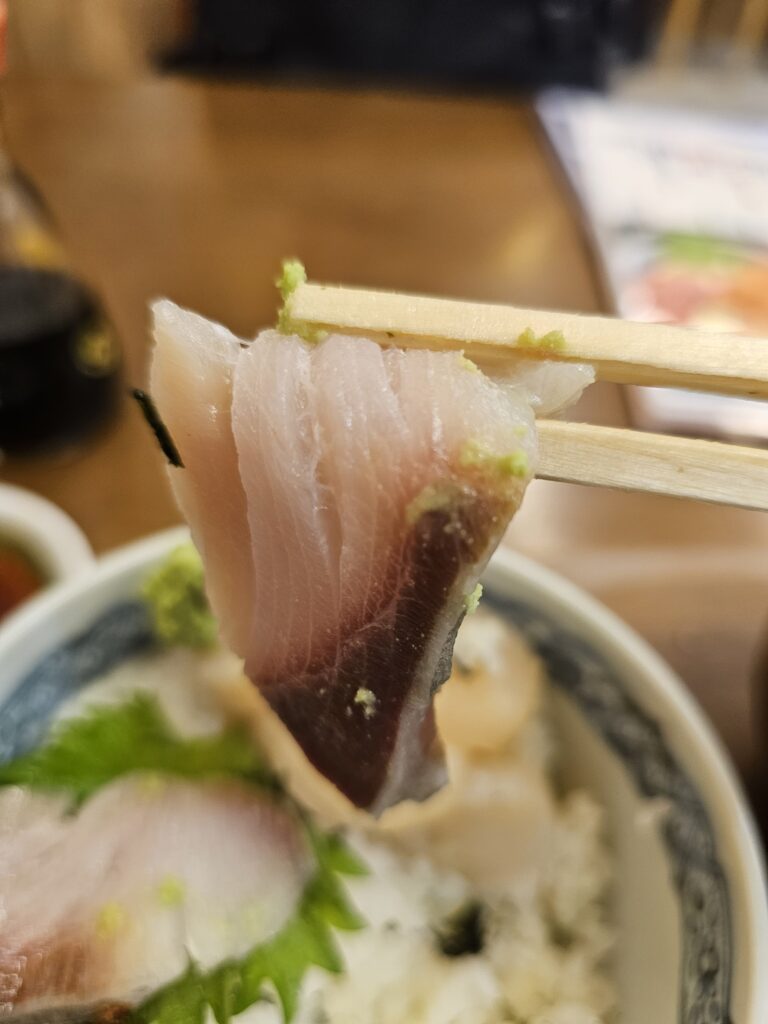
The scallops and fish were extremely fresh. Another outstanding donburi bowl. The seafood and donburi bowls are must gets when visiting the Hakodate Morning Market. Very affordable and just amazing seafood!
The Produce
Something that also warrants attention at the Hakodate Morning Market is the produce. Hokkaido is the largest agricultural area in Japan and produces many fruits and vegetables. The corn and melons are a couple of the notable products from Hokkaido so I had to try them!
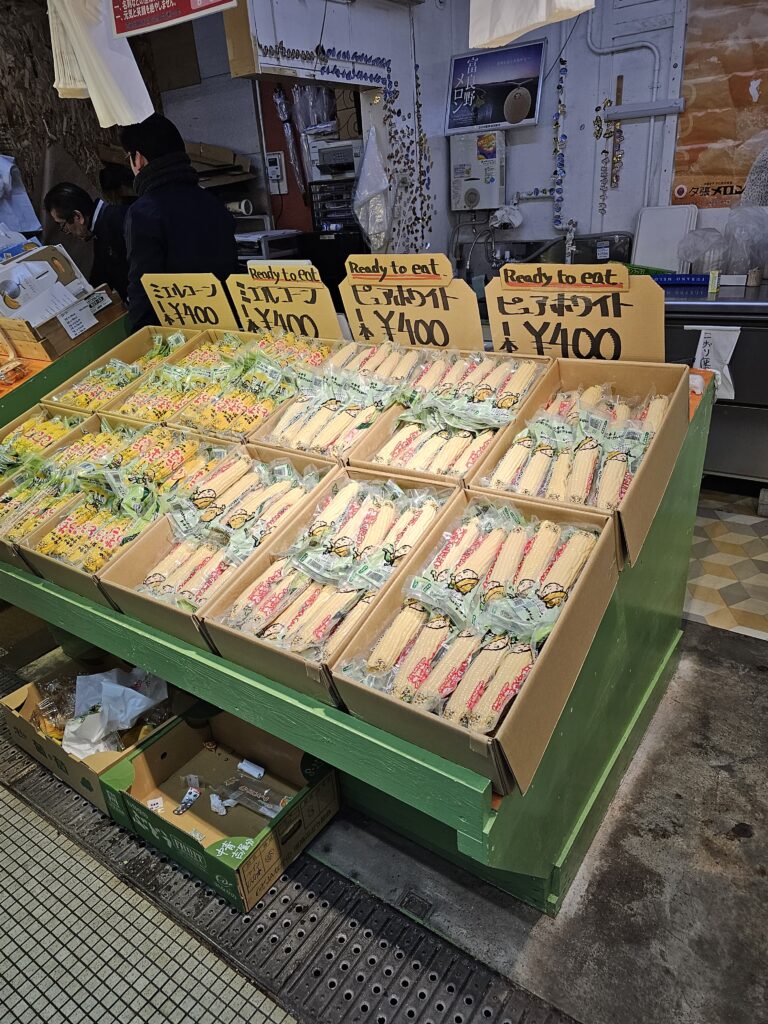
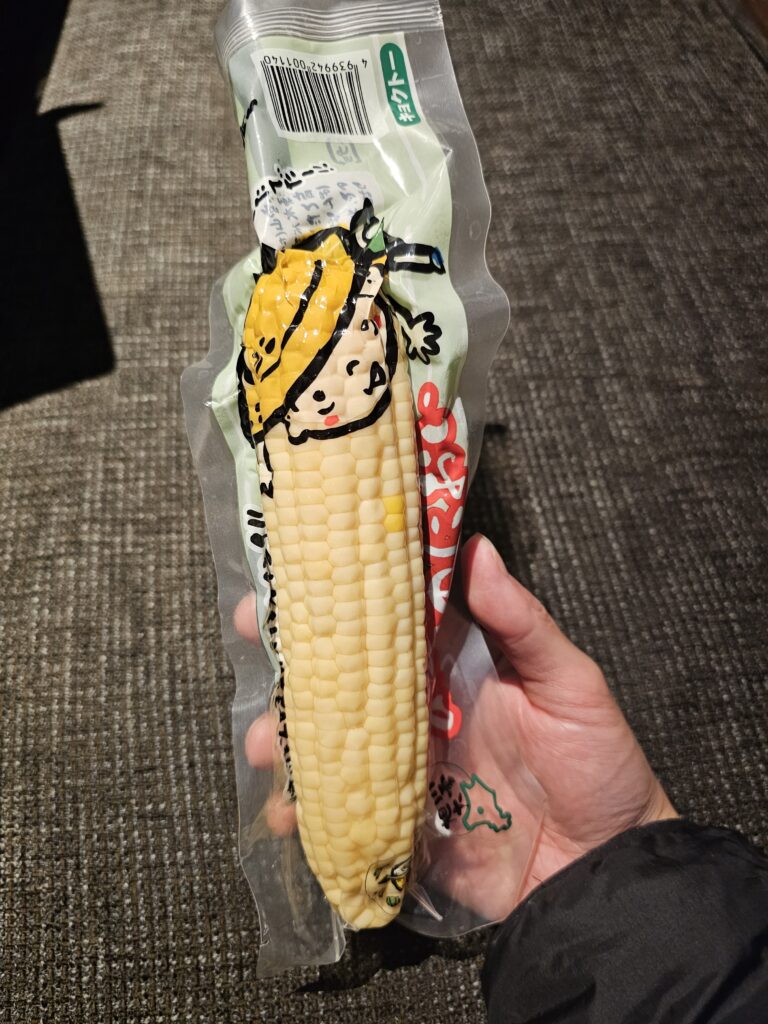
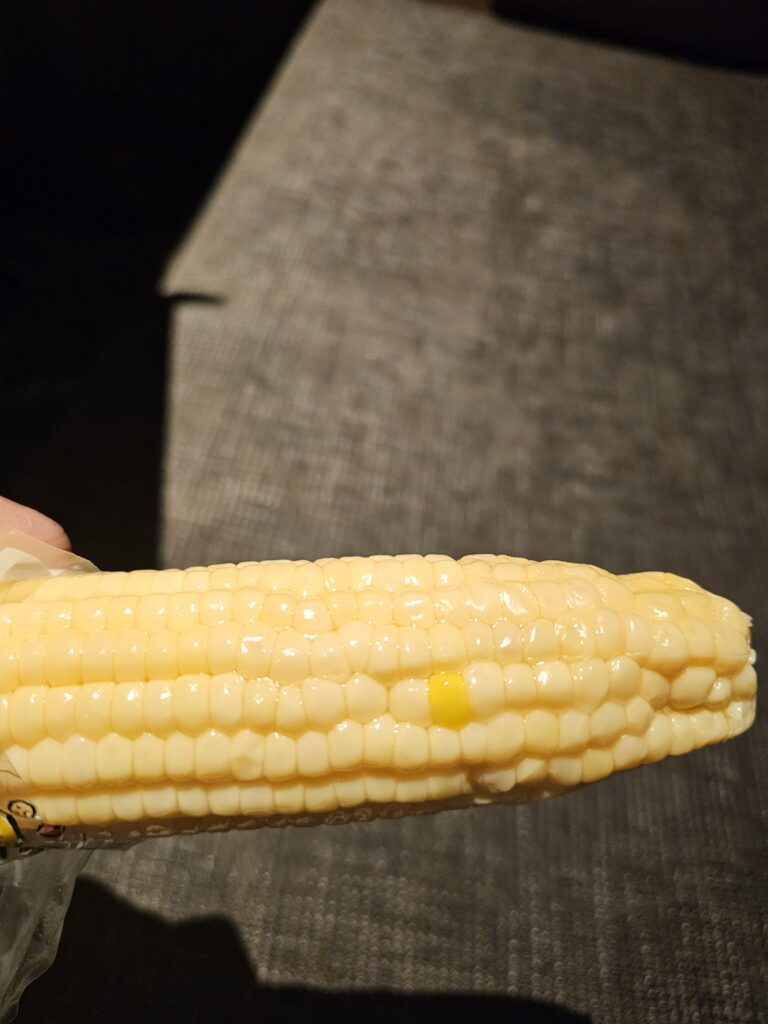
At hte morning market you’ll find stalls with vendors selling individually plastic wrapped corns like the above photos. They’re about (472 yen, $2.72) a piece. It’s well worth the price. Once you unwrap the corn it’s ready to eat. It’s hands down the sweetest corn I’ve ever eaten. It tasted like cream of corn. It’s pretty insane how sweet the corn was.
Many of these same stalls and vendors will sell slices of Hokkaido cantaloupe as well (500 yen, $3.40). They’re conveniently cut up so you can use a tooth pick to pick up pieces of the slices.
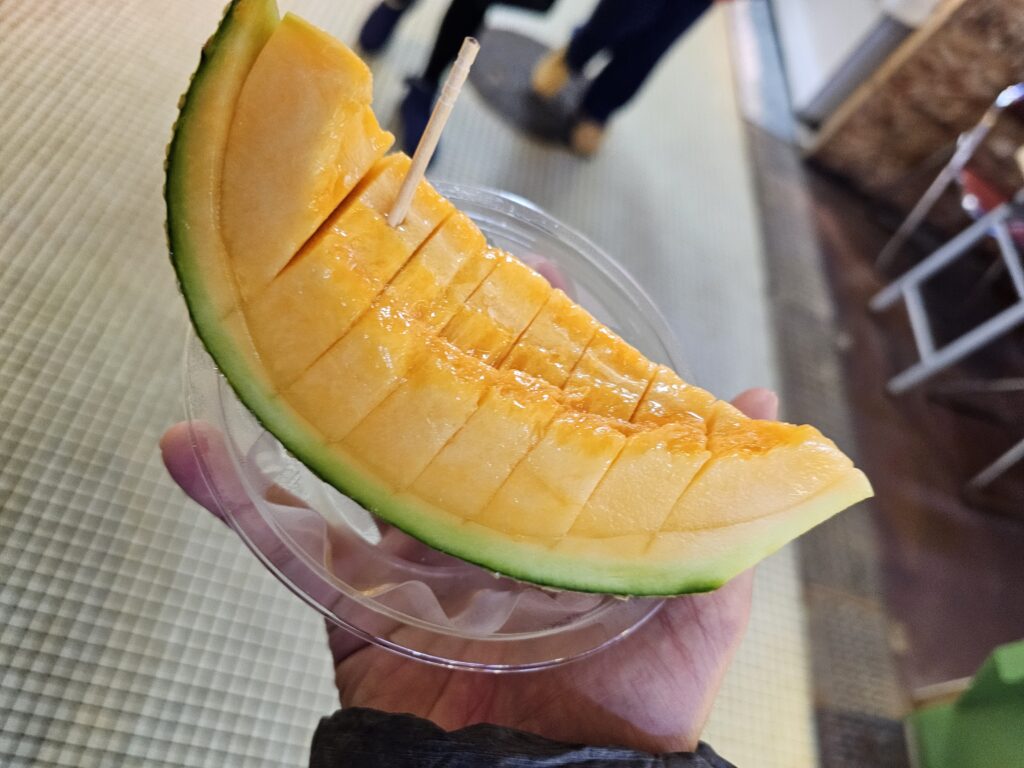
This wasn’t quite as sweet as I anticipated, although this was in December, not exactly prime melon season. The melon was still super juicy , it really explodes with a great cantaloupe flavor. This one was not super sweet though. Still pretty quality. I’m sure in the summer these would be insanely good.
The last bit of produce that I got were strawberries\ (861 yen, $5.86). These were very sweet and very juicy. Super tasty. I was surprised how sweet they were since I didn’t think they’d be in season.
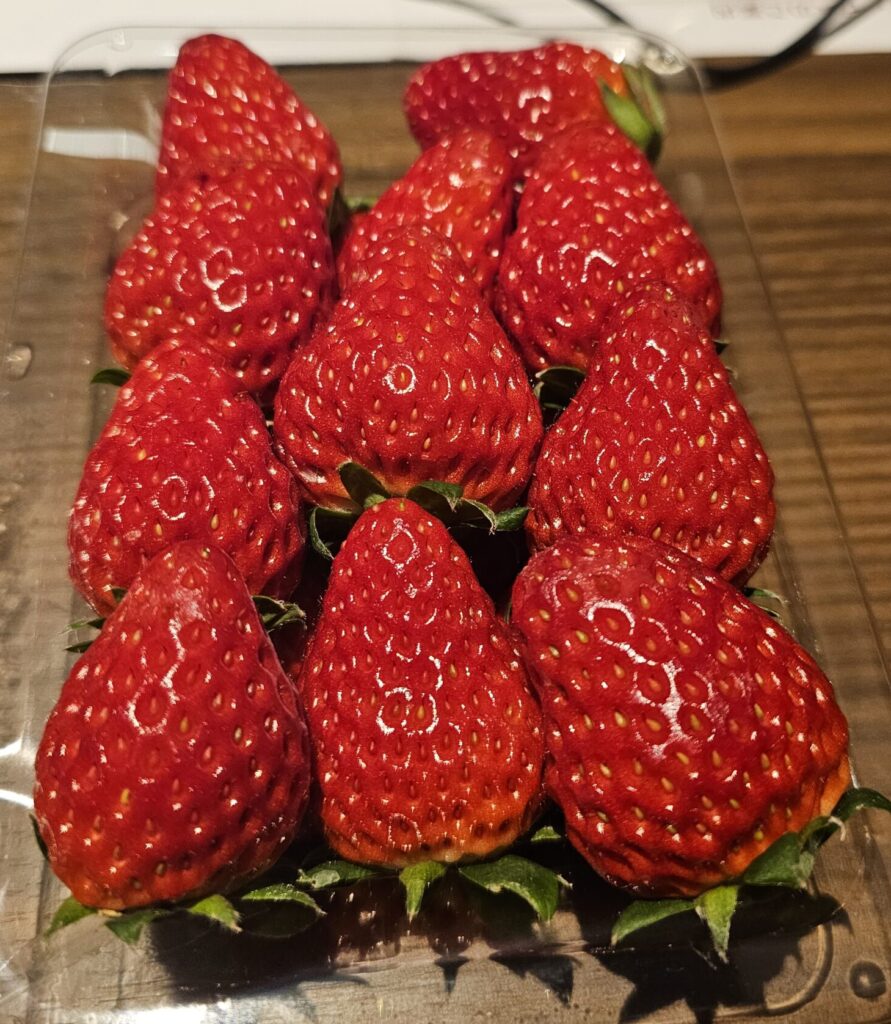
Perfect Place To Start Your Day
The Hakodate Morning Market is great place to kick off your day in Hakodate and grab some of the freshest seafood you can find in the country. It’s not a huge, robust market place, but that’s part of the charm. It won’t take you too long to walk through the entire Hakodate Morning Market but it might take some time to figure out what you want to eat exactly. There’s A LOT of seafood to try here and you certainly should try to fill yourself up with as much as your wallet will allow. I definitely recommend grabbing as much of the produce as you can too!
-
Soup Curry In Hokkaido, Japan Is Simply A Must Try
What is Soup Curry?
Originating from Sapporo, soup curry is a local specialty dish that was first created in the early 1970’s. A blend of Chinese and Indian spices it quickly became a local favorite with more of these soup curry shops opening up throughout Sapporo. These days there’s around 200 locations selling this unique dish in Sapporo.
Generally soup curry consists of a light curry flavored seasoned soup, a chicken leg, and roasted vegetables. There can be other types of meat included and vegetables can change with the seasons but basically this is soup curry.
Soup curry may have originated in Sapporo but it’s also very popular in Hokkaido in general. While in Hakodate it was definitely a food I was on the lookout for.
Begirama
I was able to find a soup curry spot that wasn’t too far away from the hotel I was staying at called Begirama. It had good ratings on Google (for what it’s worth) so I was excited to give it a try! It was definitely a popular place, which is always a good sign. I waited about 10-15 minutes to be seated which isn’t too bad.
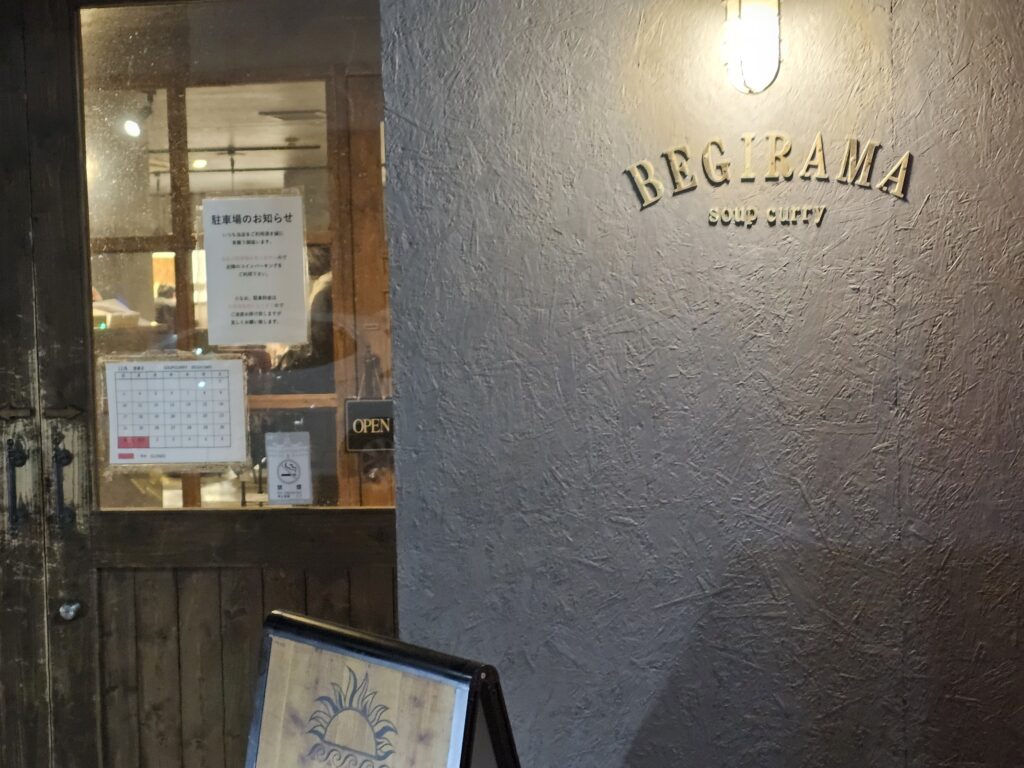
They had several types of soup curry at Begirama. I didn’t know much about soup curry, but in reading about it recognized that the usual meat was chicken leg. That one happened to be the “No. 1” dish, at least per the menu, so it seemed like a no brainer to try.
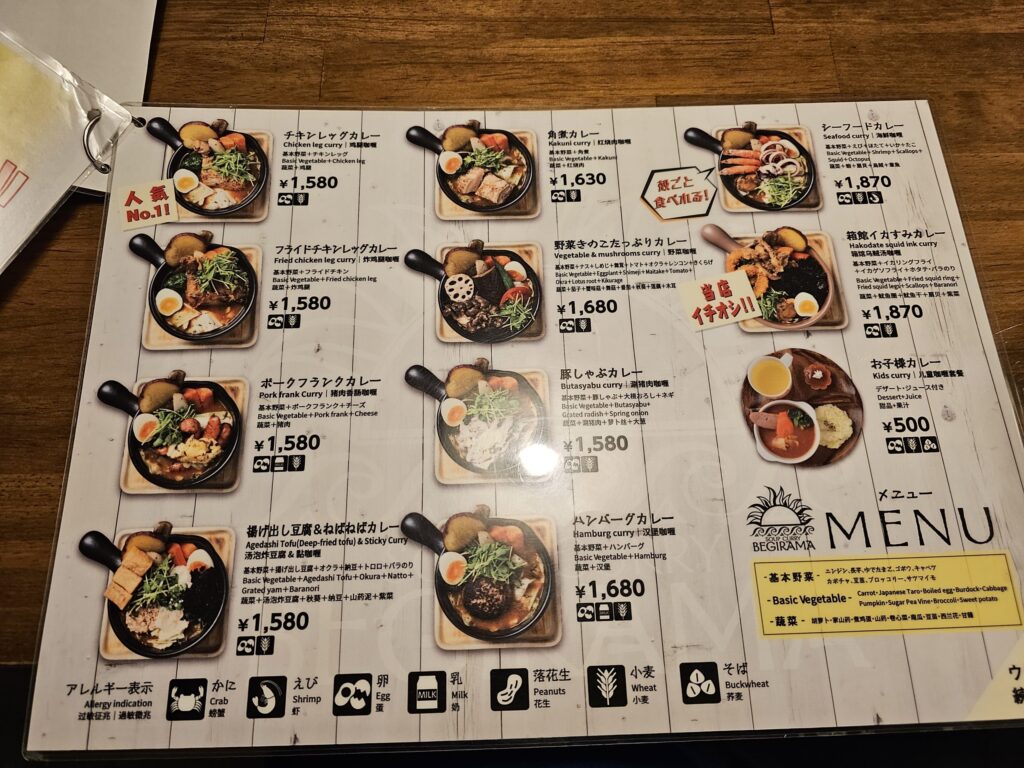
The Chicken Leg Soup Curry
Outside of the chicken leg the dish consisted of lots of veggies – broccoli, mushroom, half an egg, carrot, potato, cabbage, eggplant, pumpkin – and you get a medium rice along with it and chose very spicy.
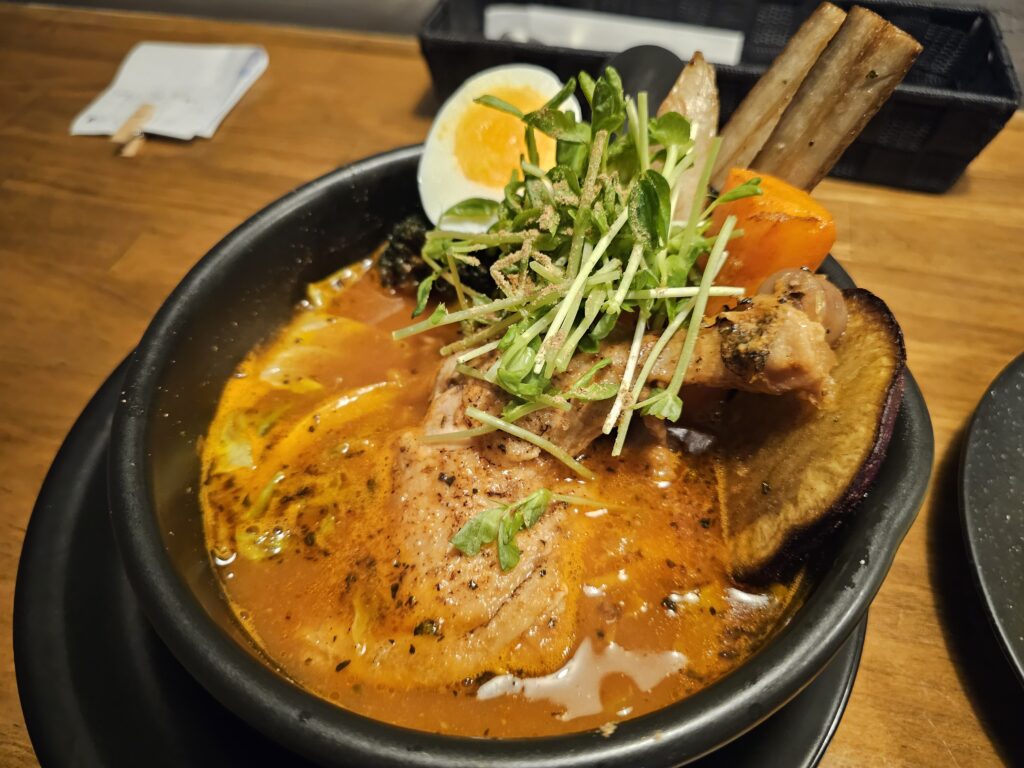
The broth was really interesting. There’s a deep curry taste to it…but in soup form. I mean no shocker there since this IS soup curry after all, but as someone that’s only had “regular”, thicker curry, it was still very strange to be slurping it in soup form.
It was also deeply satisfying. Especially on a cold December evening. The mixture of all the different spices was extremely tasty. It definitely had a kick to it and was actually quite spicy, which I loved!
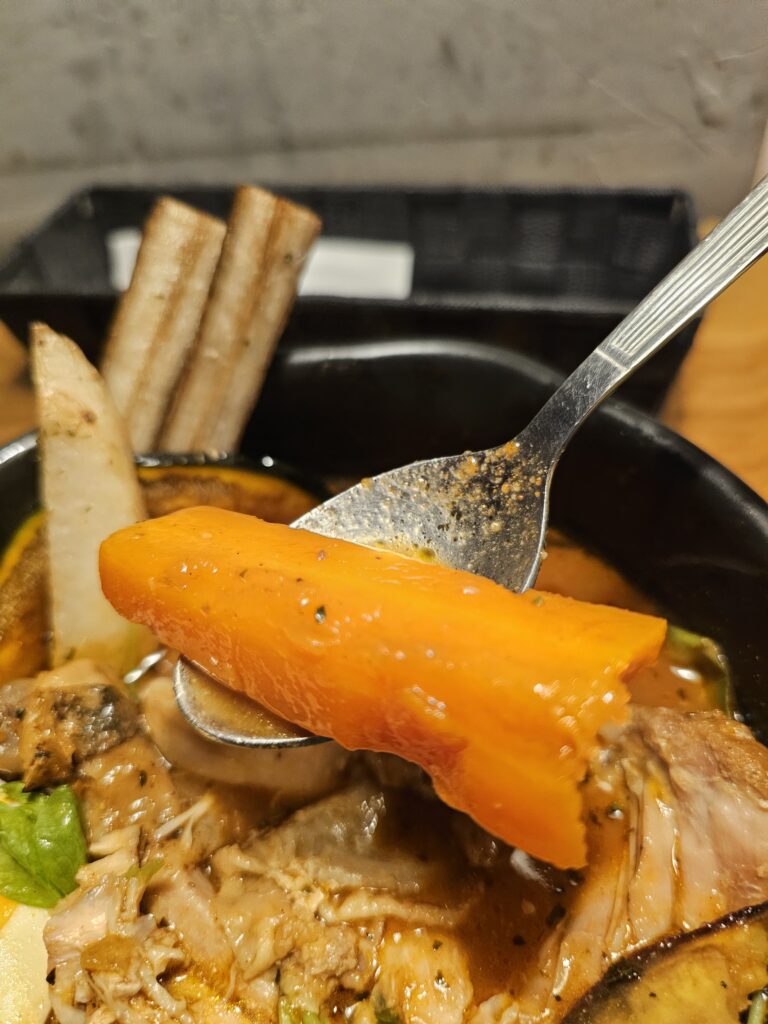
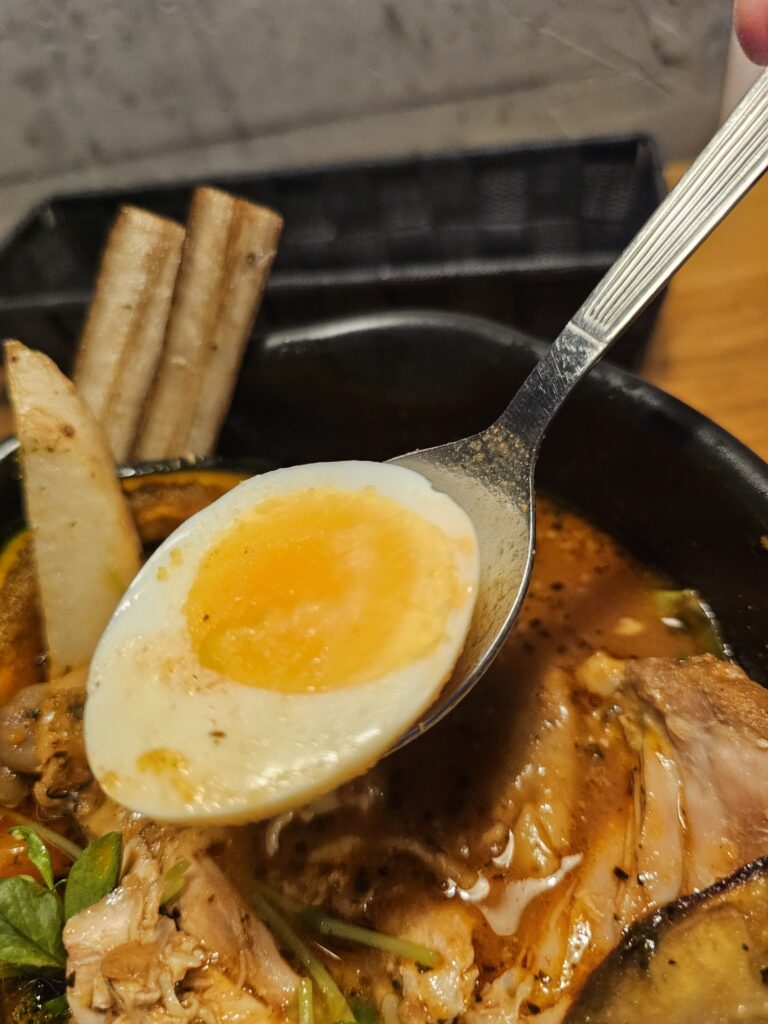
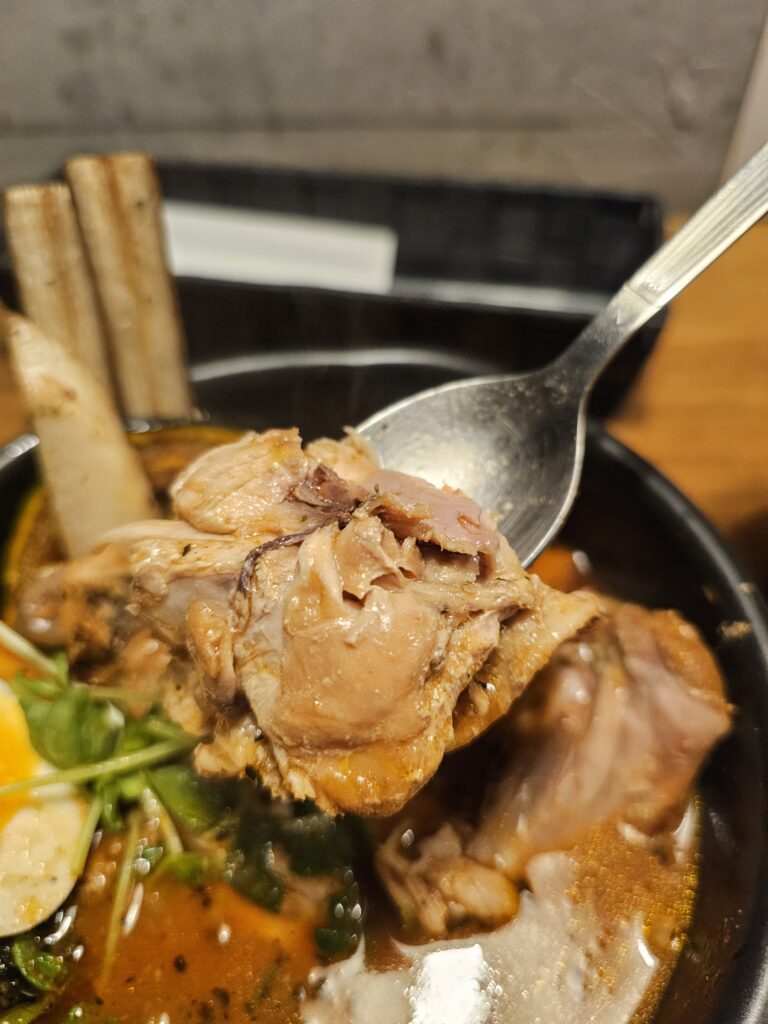
The chicken was VERY tender. It easily fell off the bone in chunks. There was really quite a lot of vegetables in the bowl too. Quite the variety as well. All the veggies seemed to be prepared differently with some being baked, boiled, and grilled. This, along with the general variety in vegetable texture, provided a different experience with each spoonful, which was great! Of course dipping the rice into the soup and grabbing some veggies and meat was the optimal spoonful.
It was very, very tasty. The more of the soup I had, the more I appreciated its uniqueness and really enjoyed it.
Is Soup Curry Worth Trying?
If you enjoy curry than soup curry is something you absolutely must try in Hokkaido. It’s one of the area’s signature dishes for one. It’s literally curry in soup form. A totally different take on a beloved dish. It’s so unique and ultimately satisfying.
Outside of Genghis Khan (grilled mutton), and miso ramen, soup curry is one of the most famous dishes in Hokkaido that has really blown up in popularity since its introduction back in the 70’s.
In my other travels in Japan, outside of Hokkaido I haven’t seen soup curry. I’m guessing in Tokyo or any other large city there must be places that serve the dish, I didn’t go out of my way to look for it down in the Tokyo area. But I don’t recall seeing it when walking past all the millions of restaurants you see in Tokyo. This makes ordering the dish even more important if you find yourself traveling in Hokkaido. Order it and enjoy it, you aren’t likely to find it in other parts of Japan or back home!
